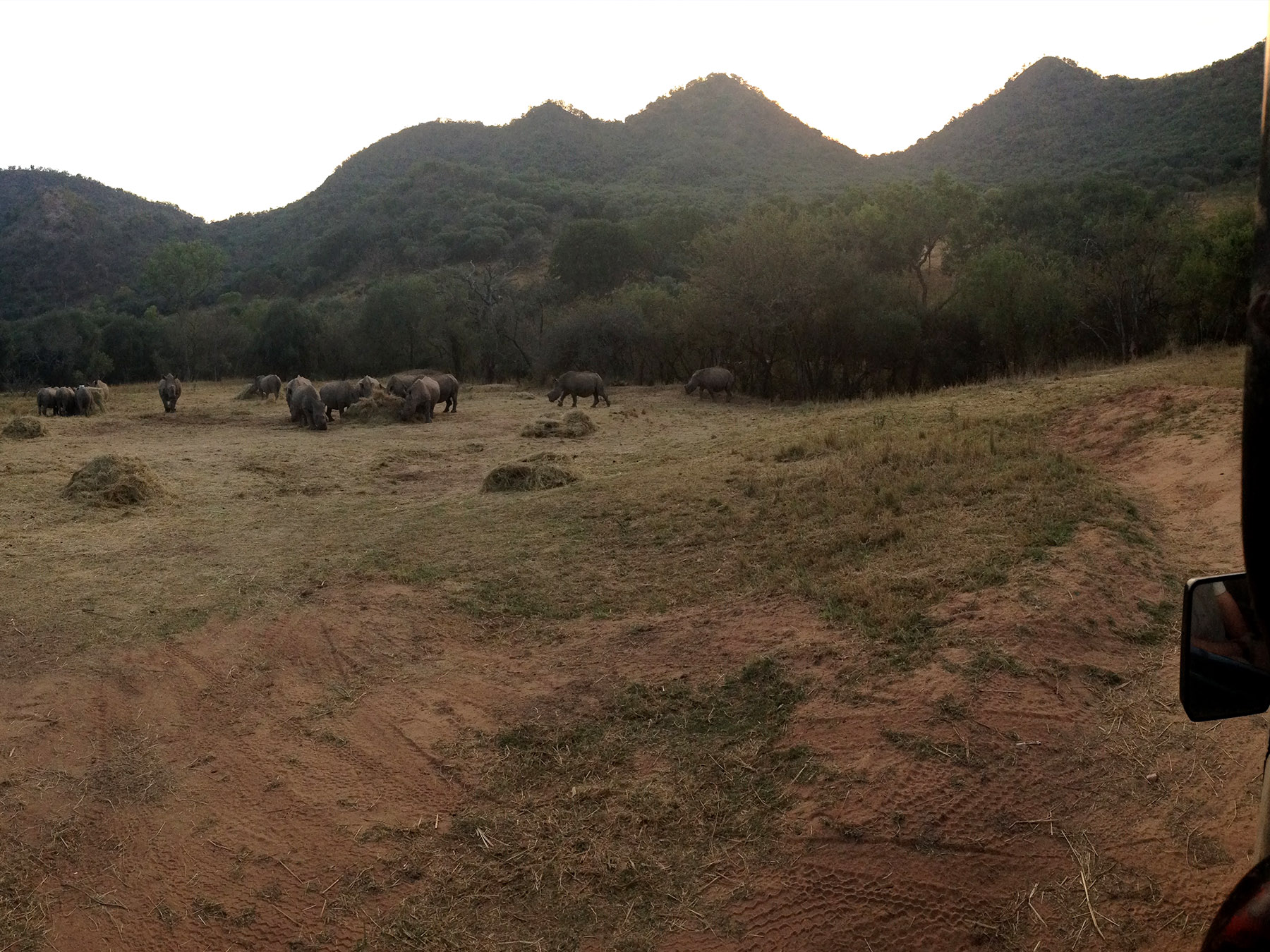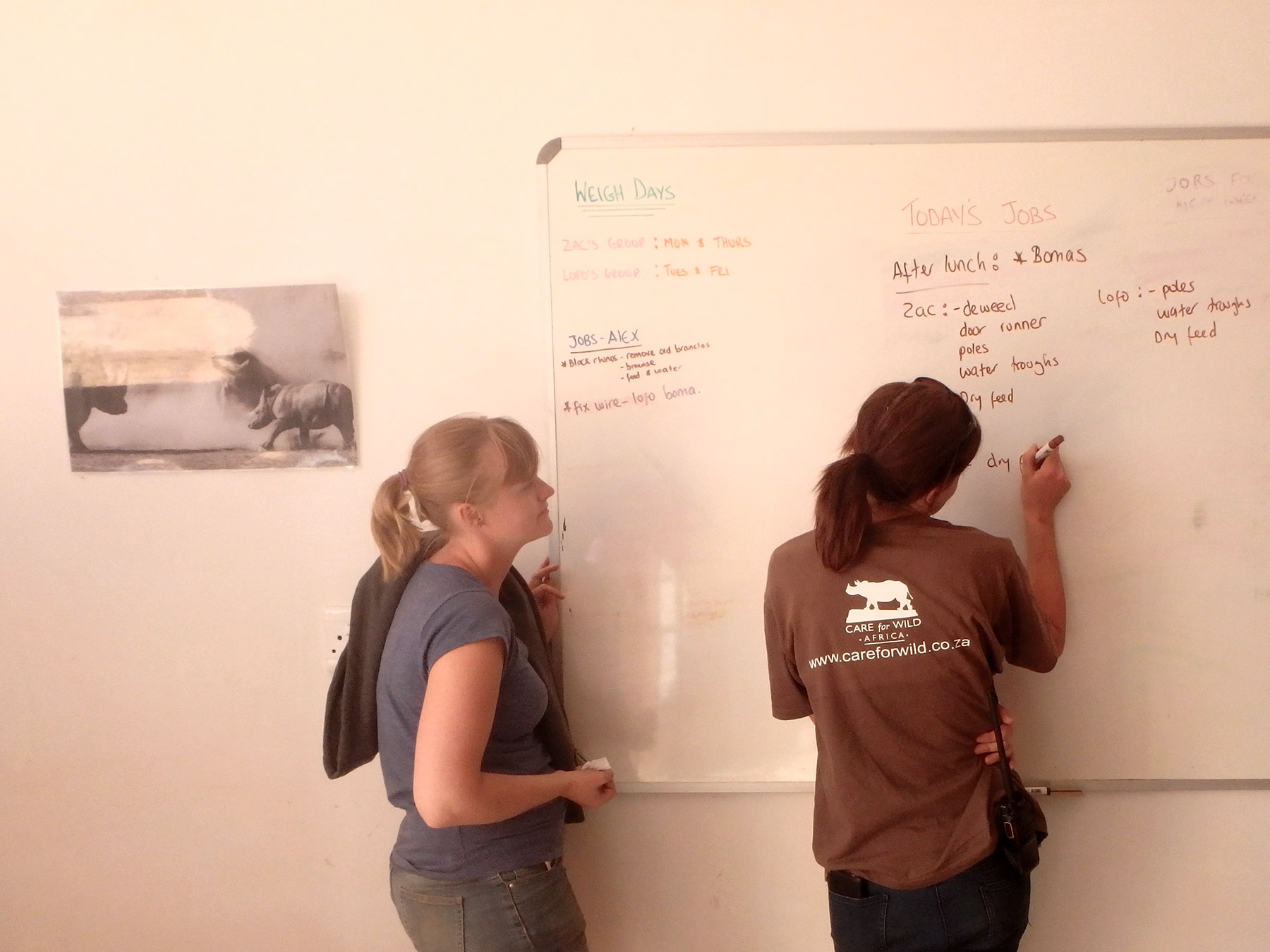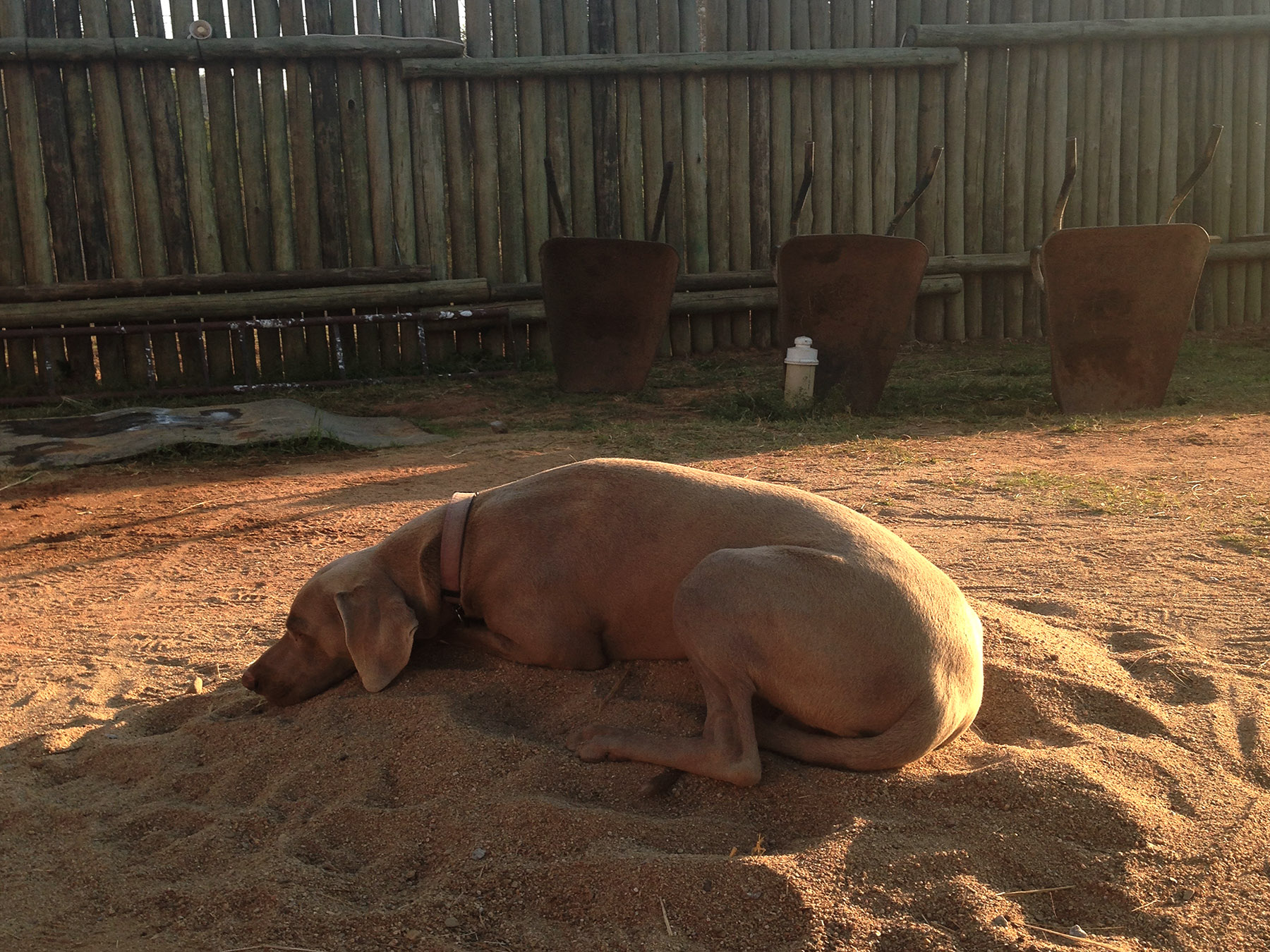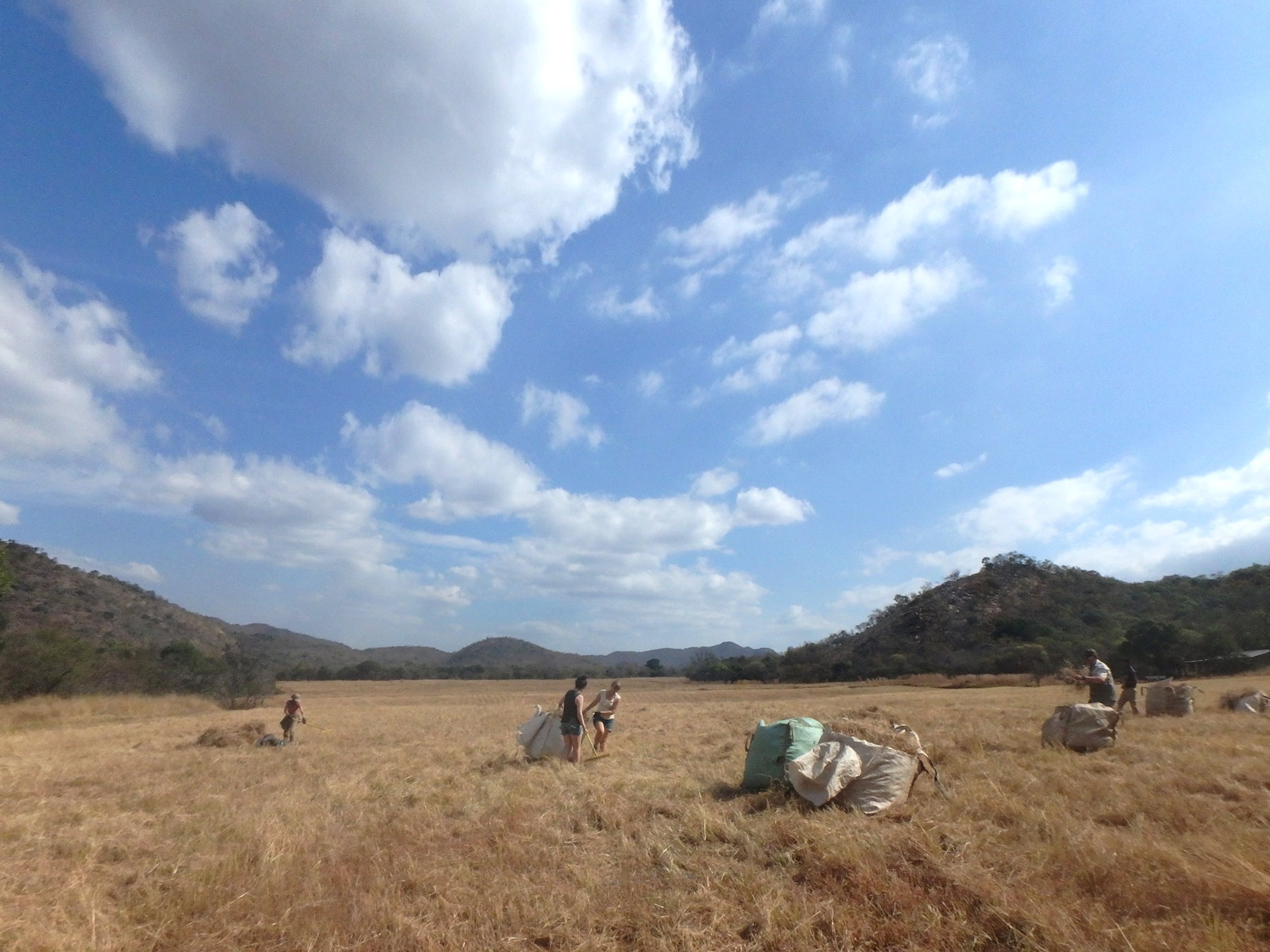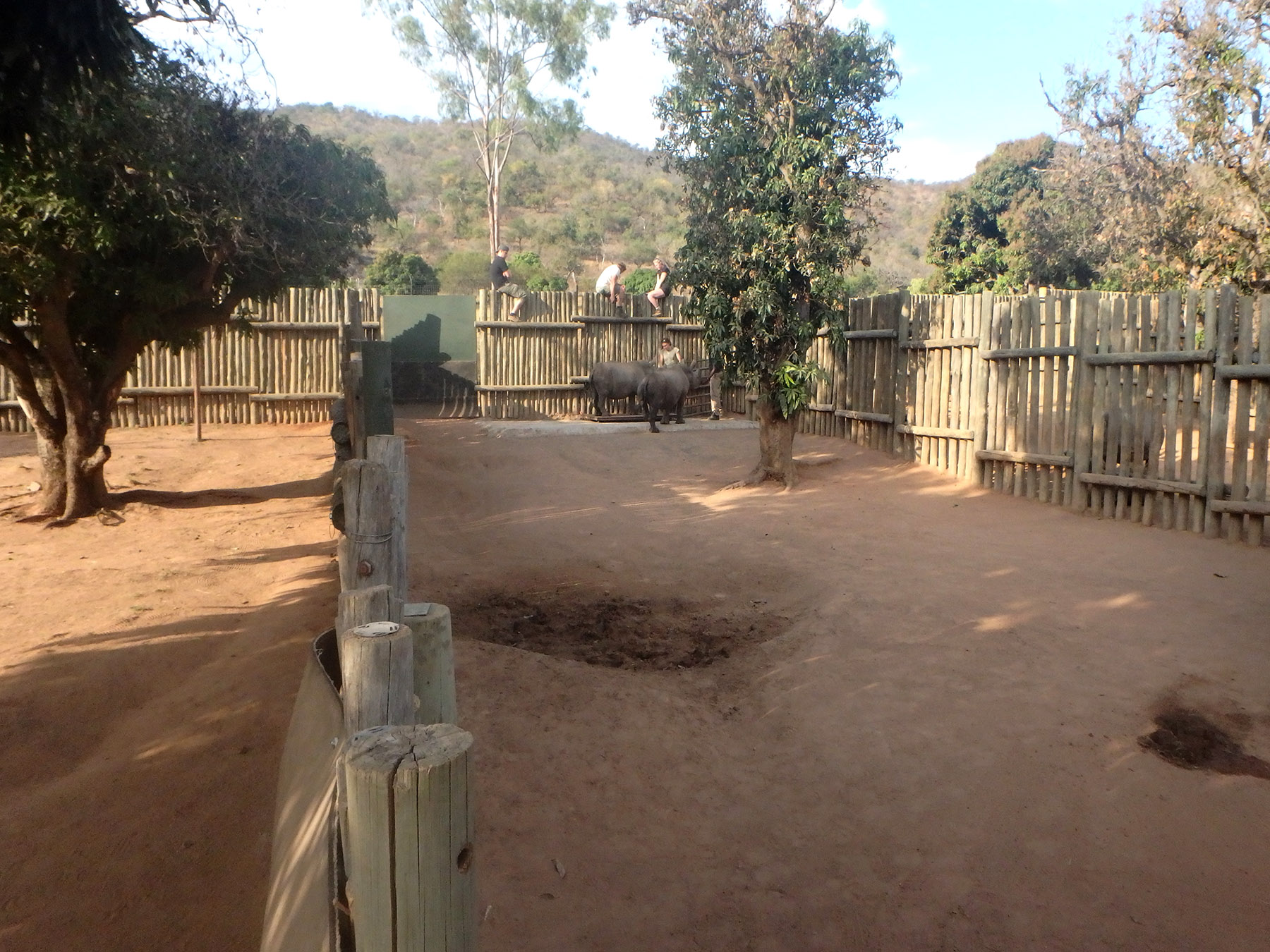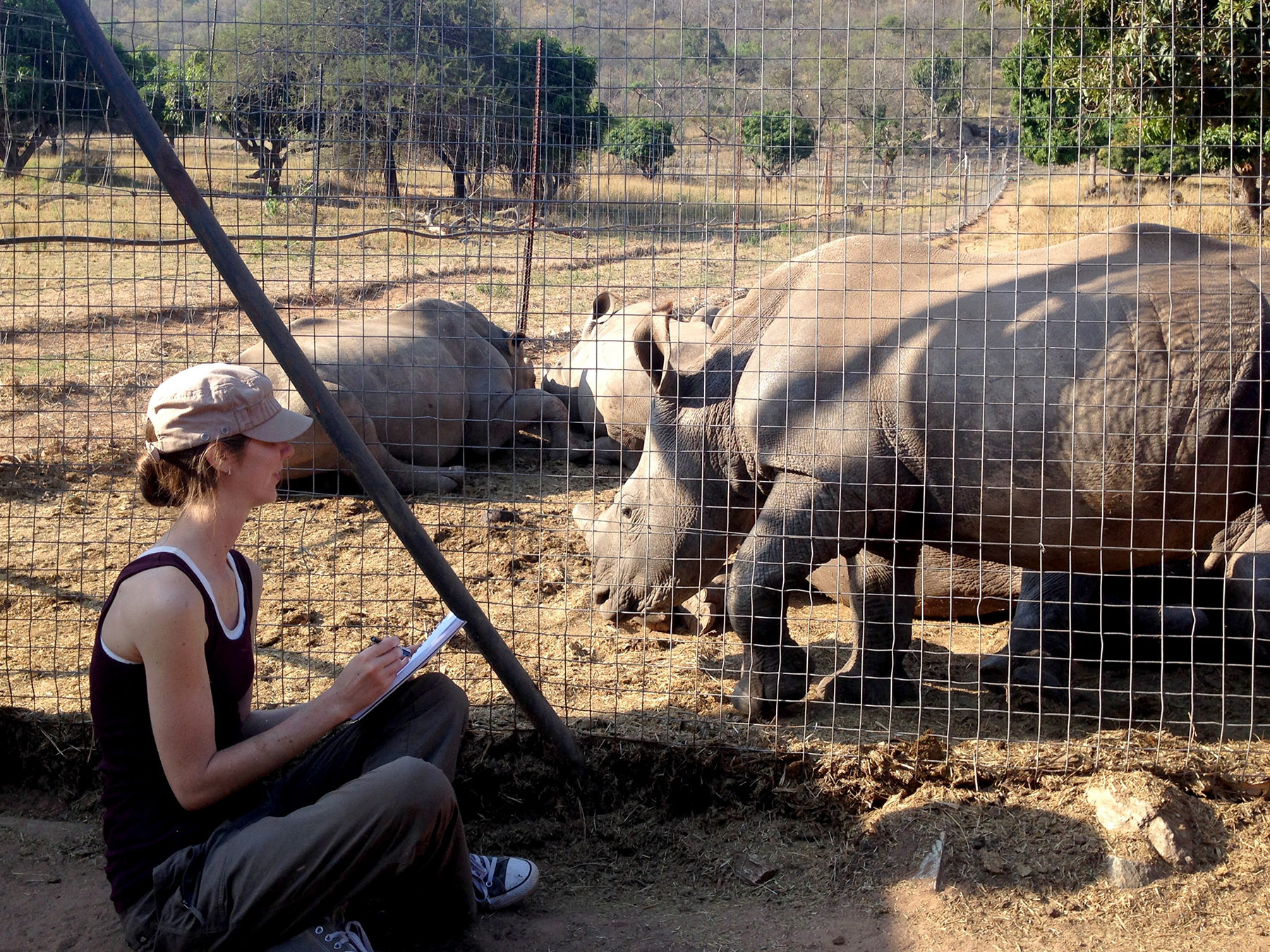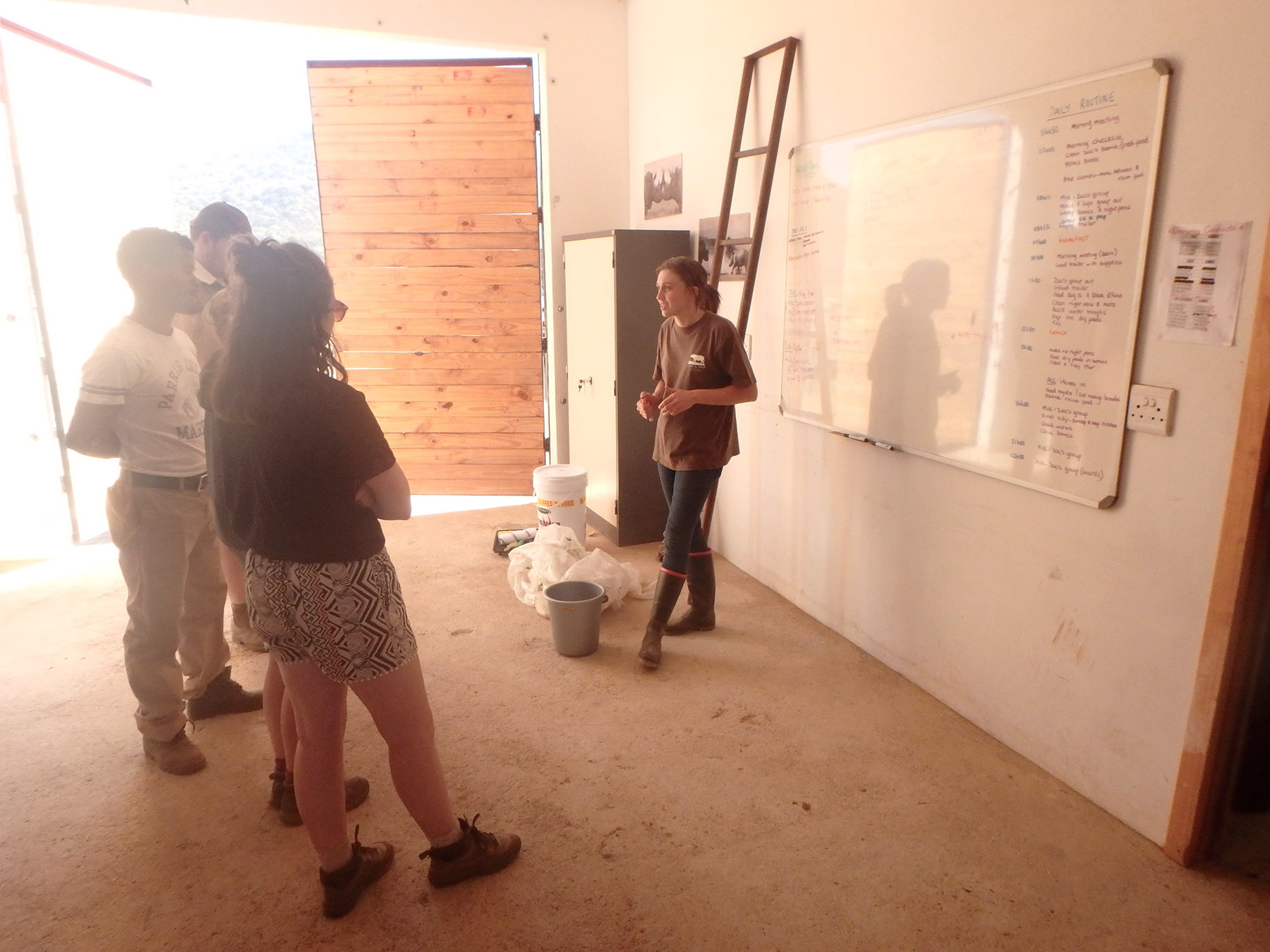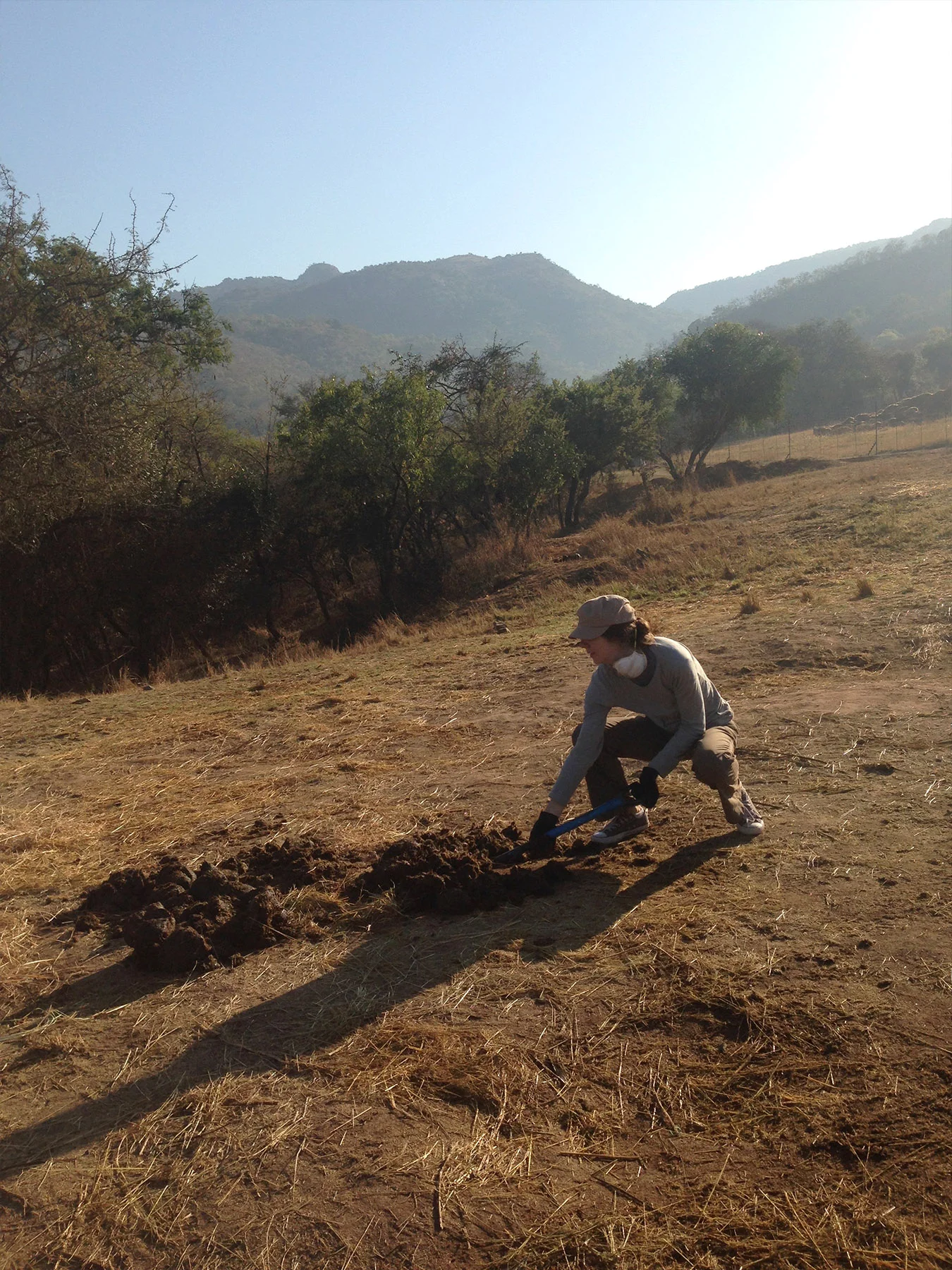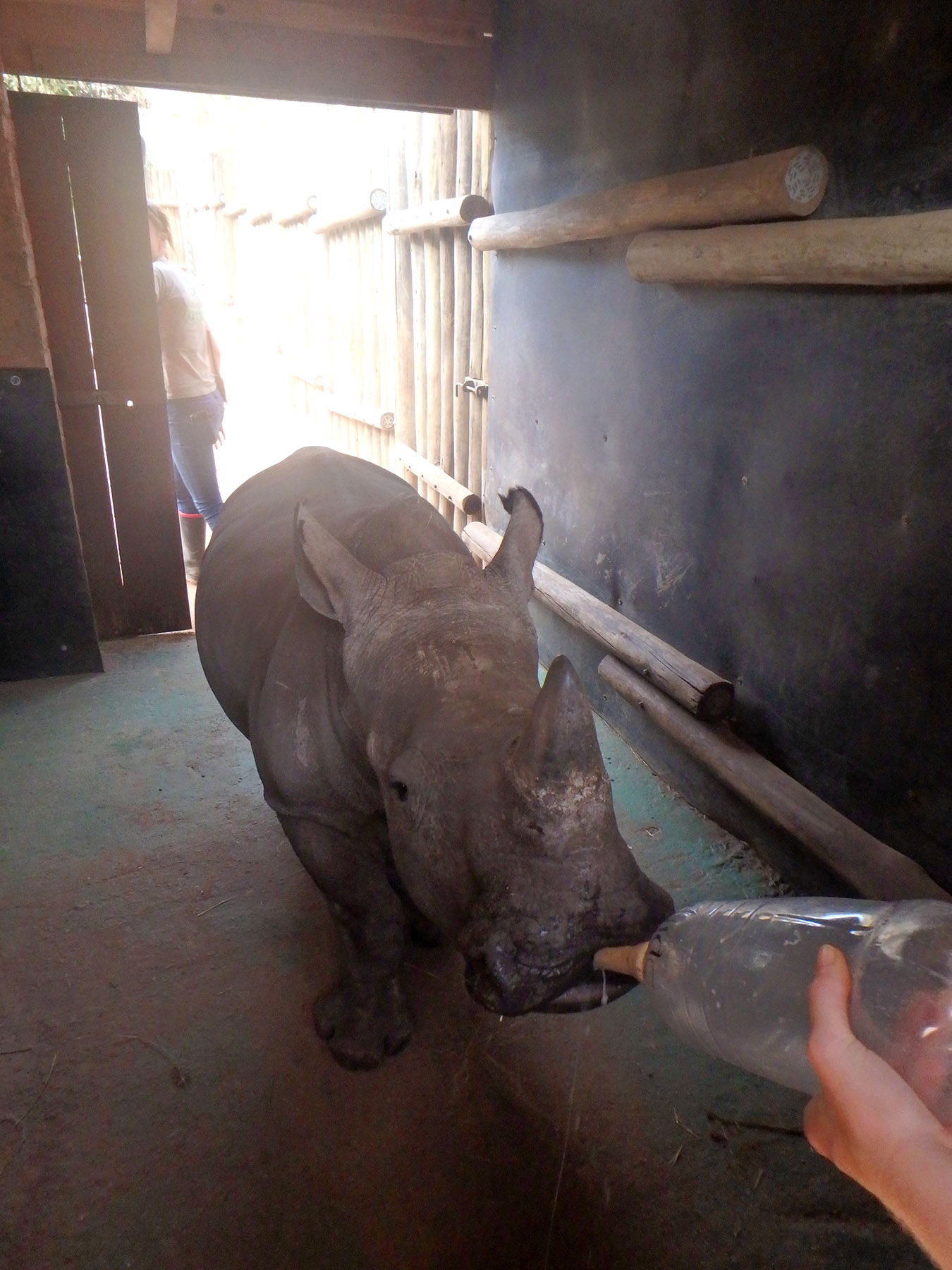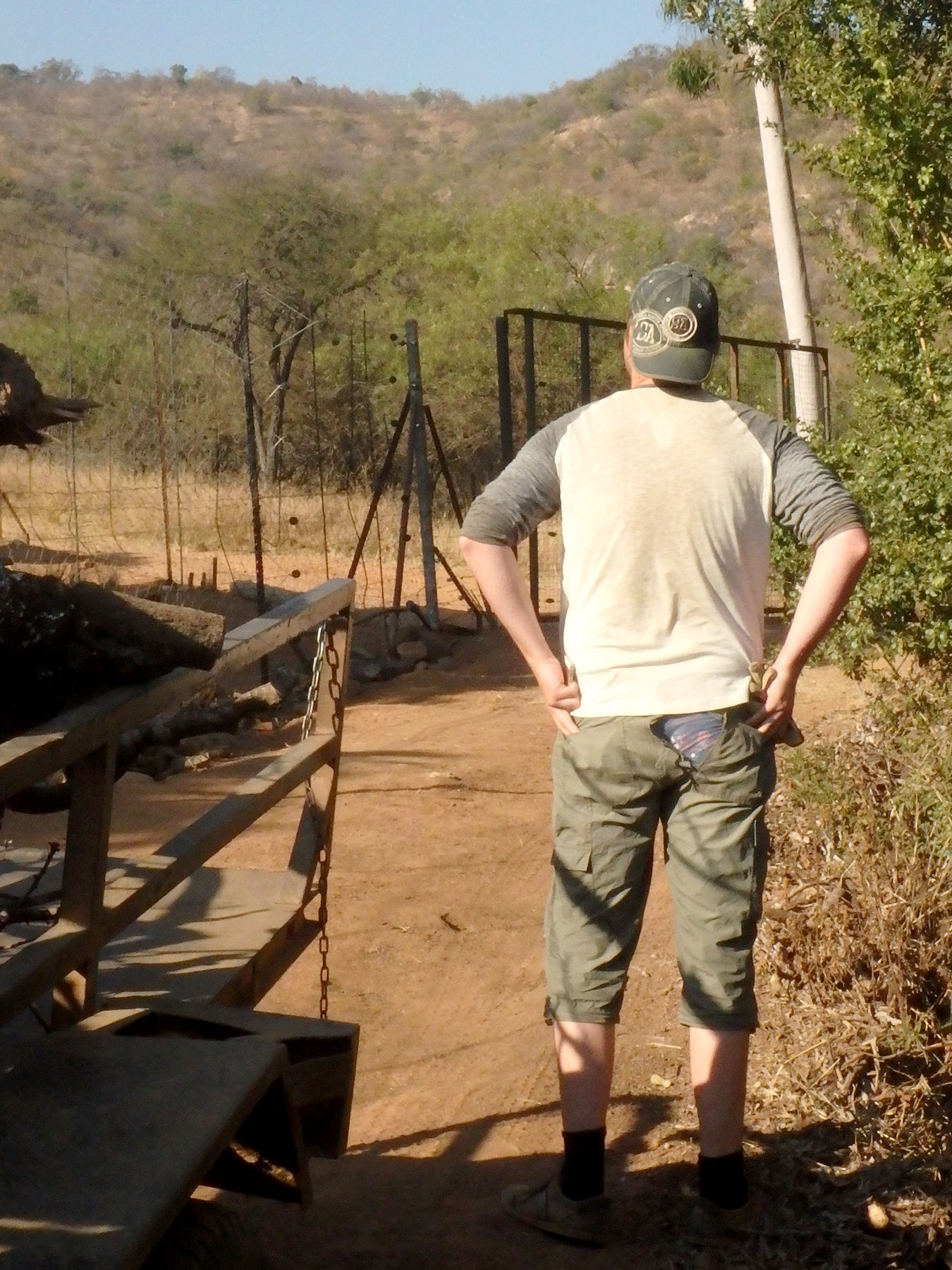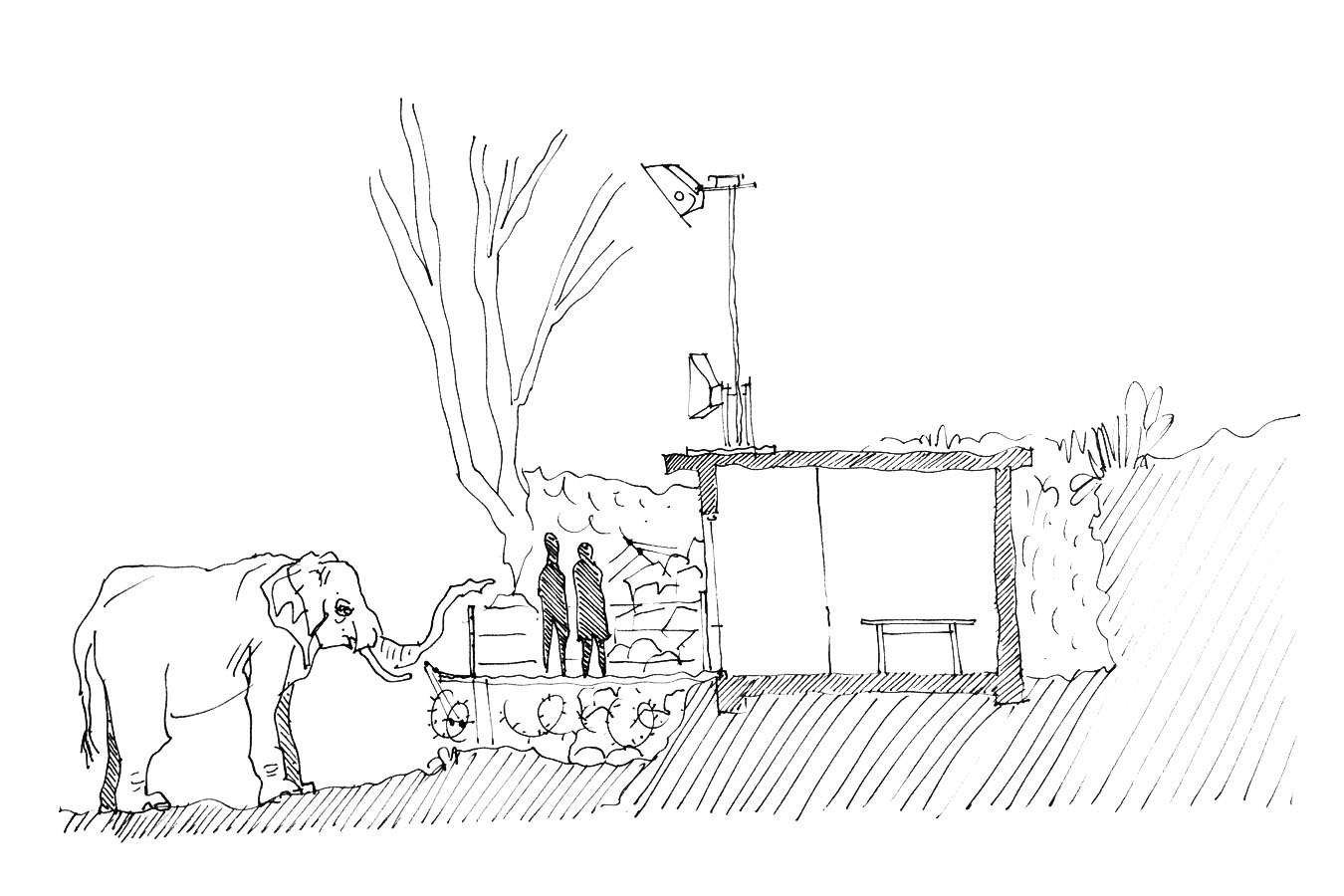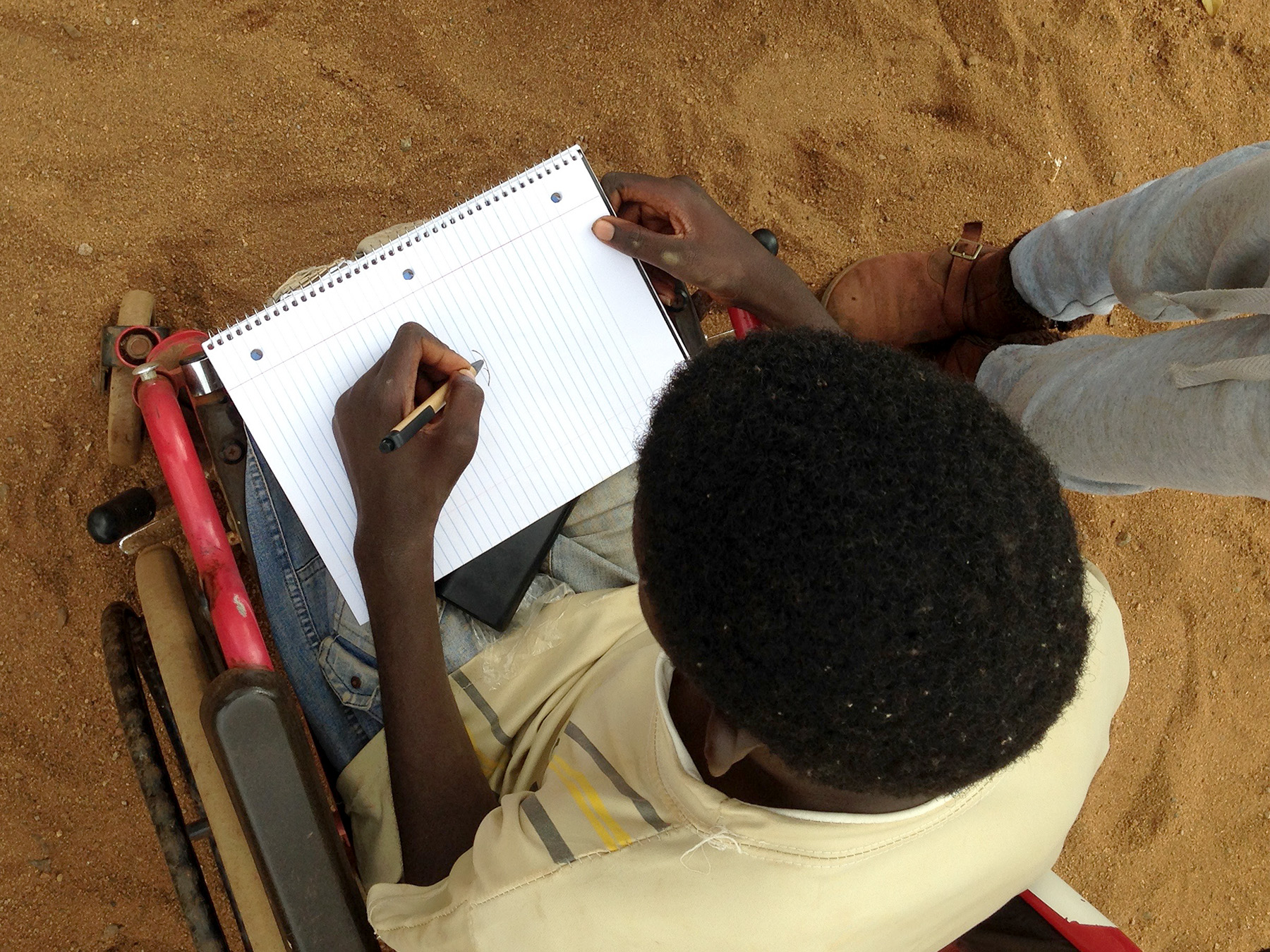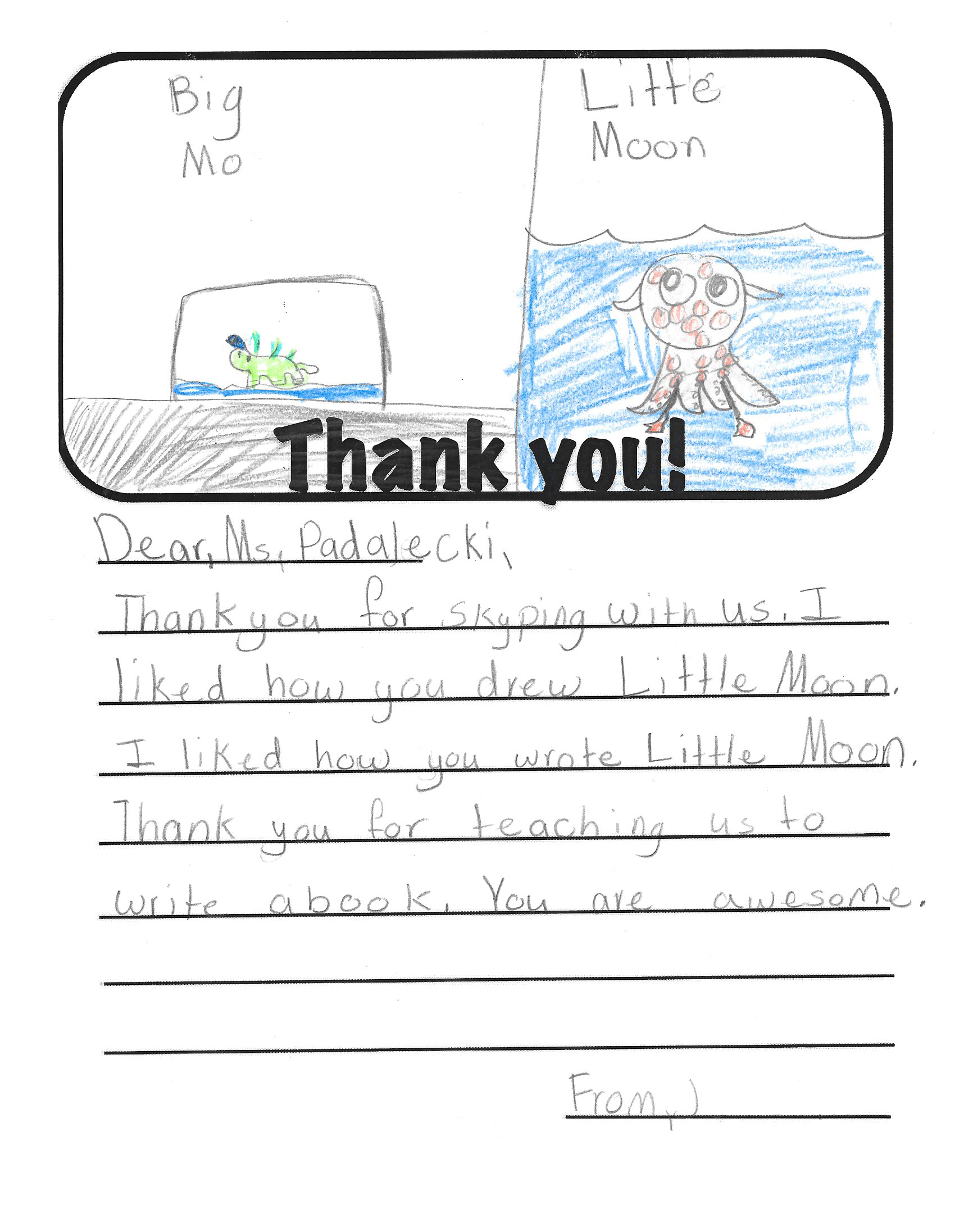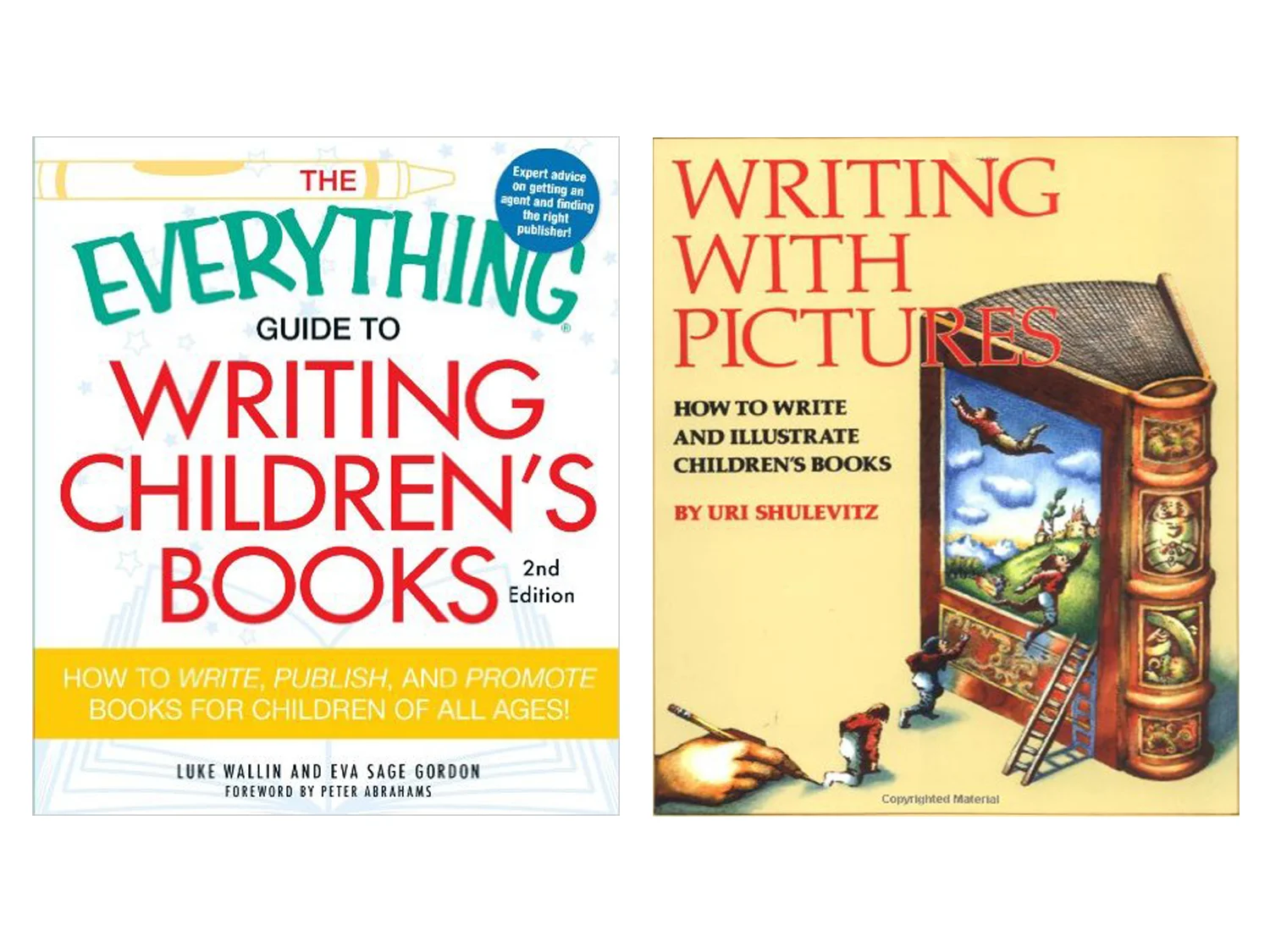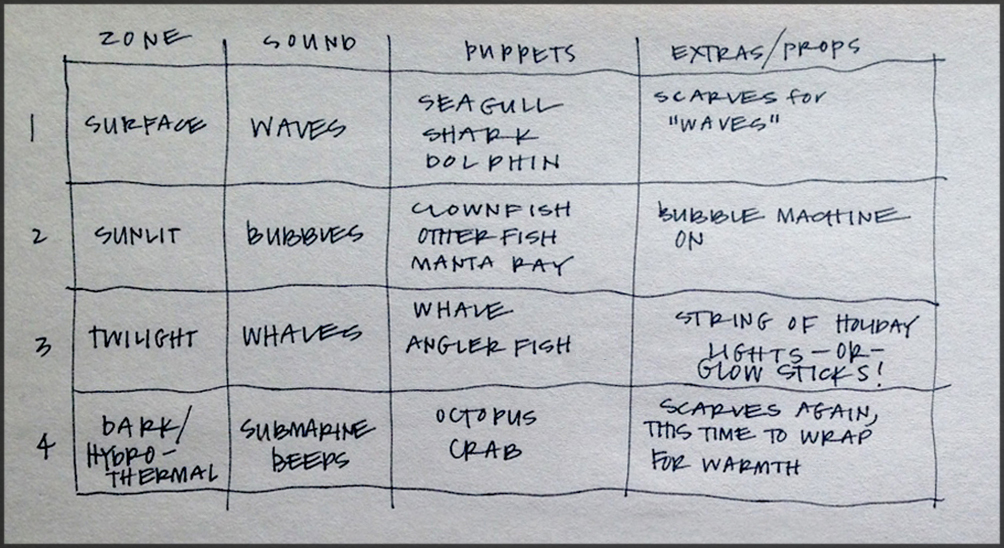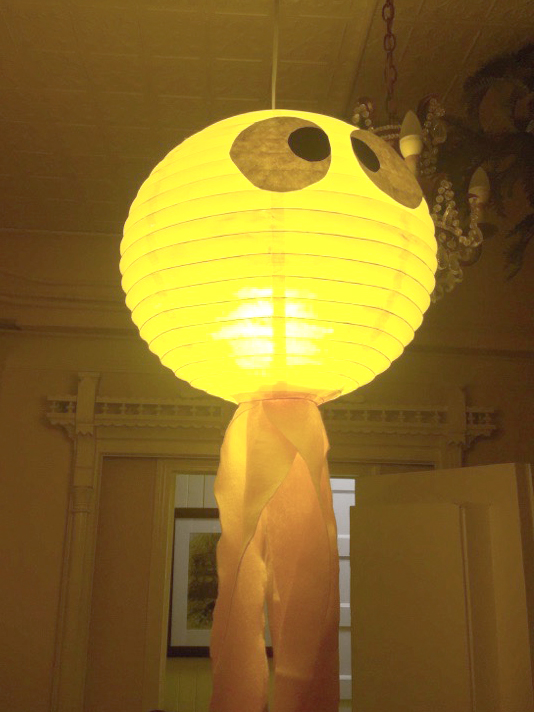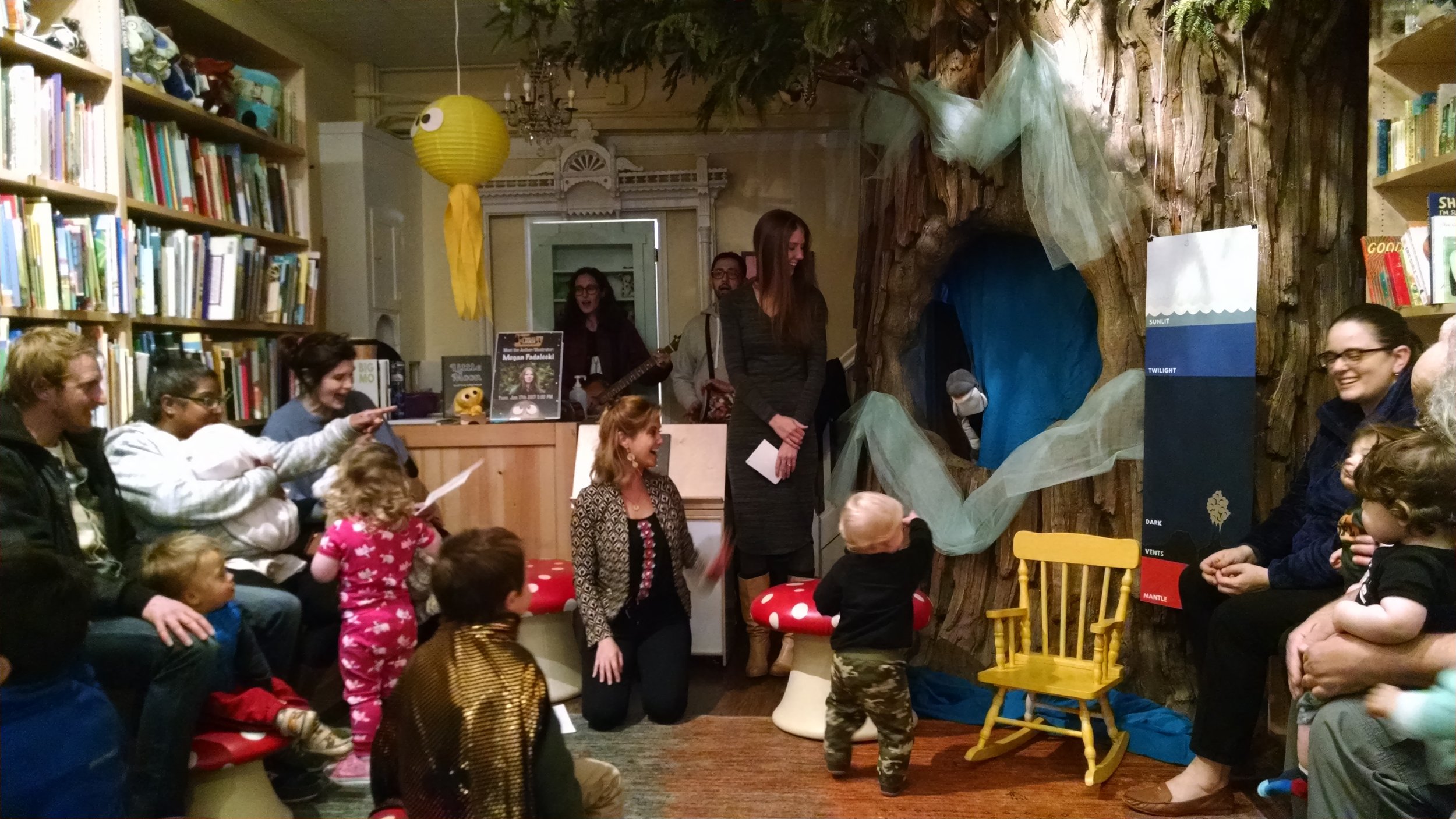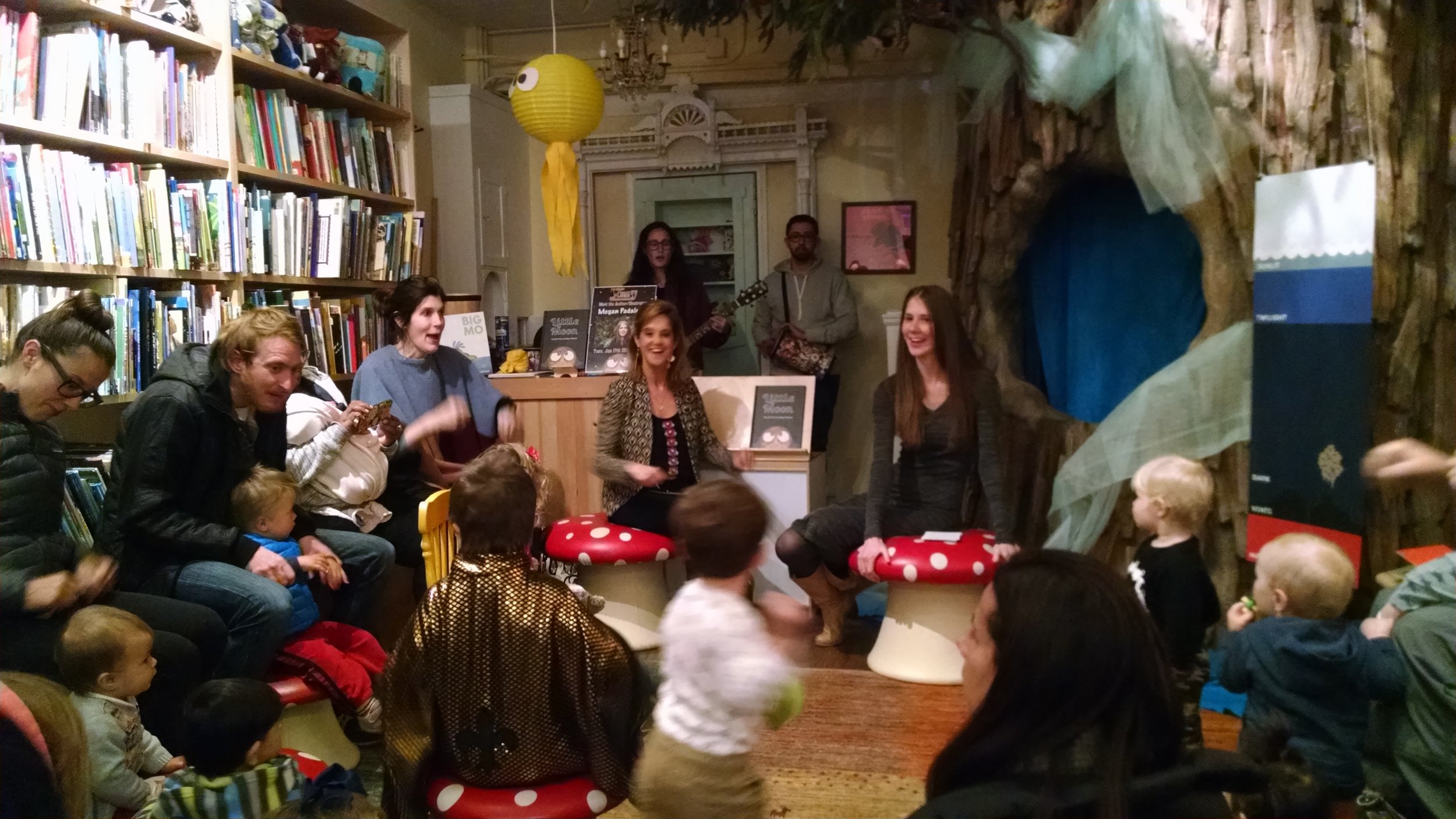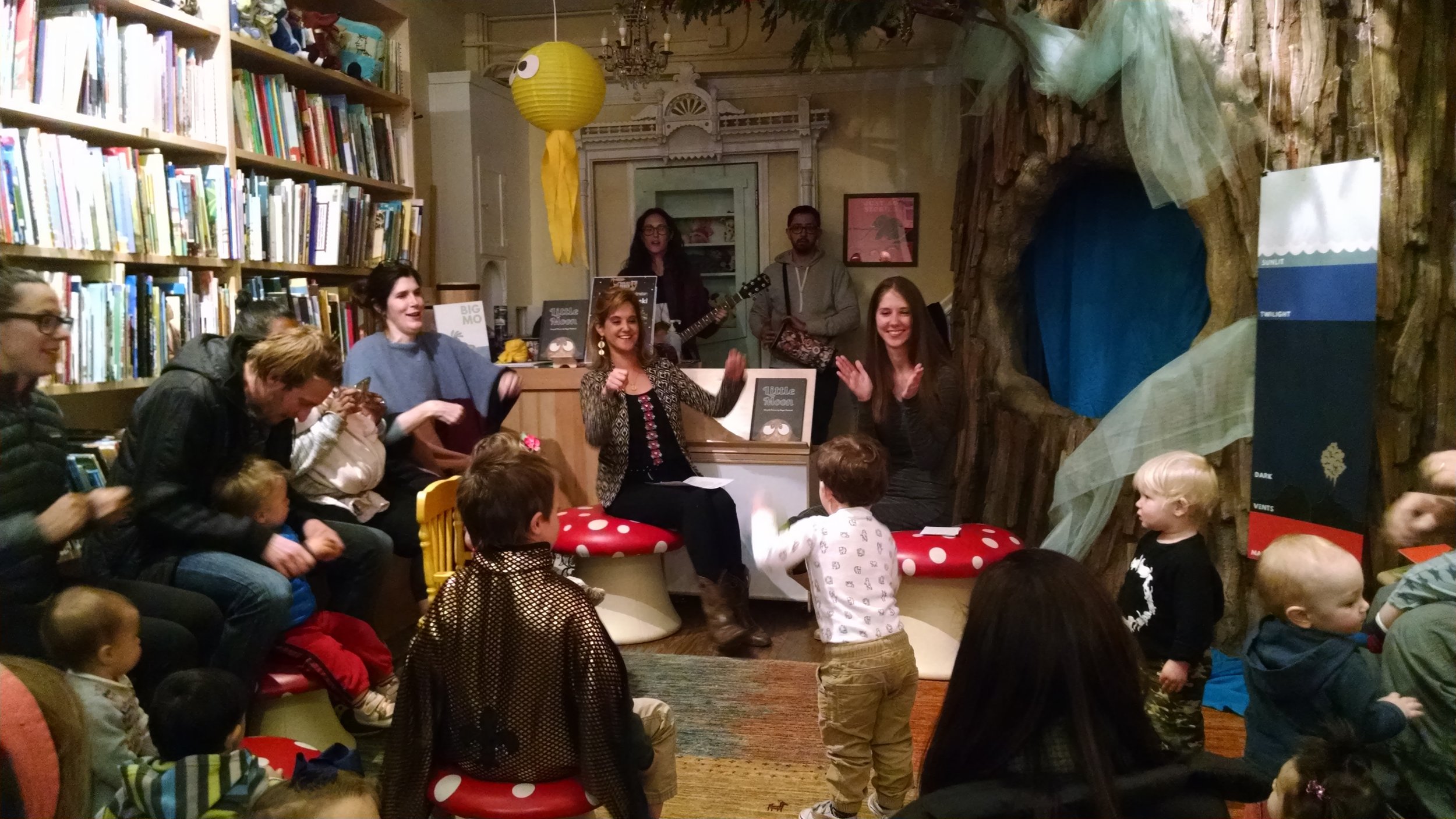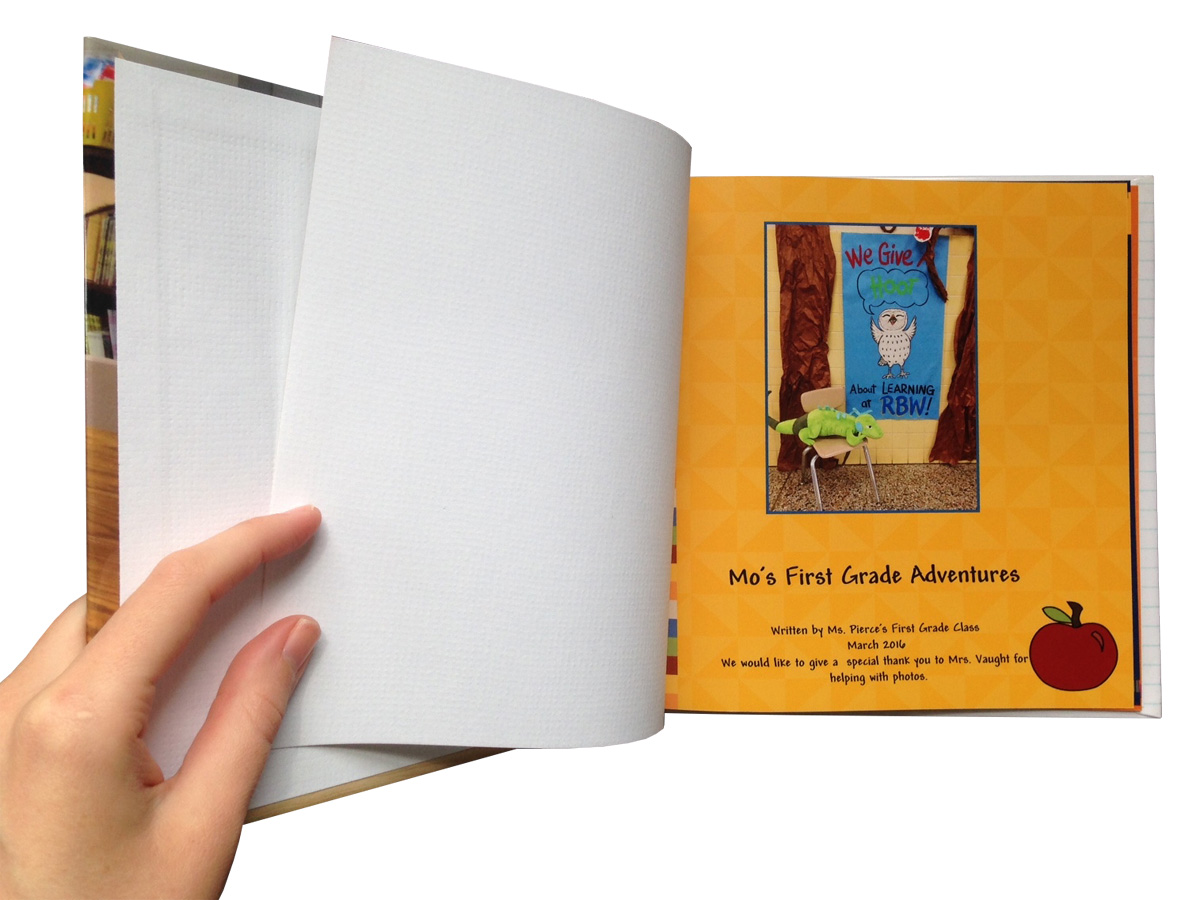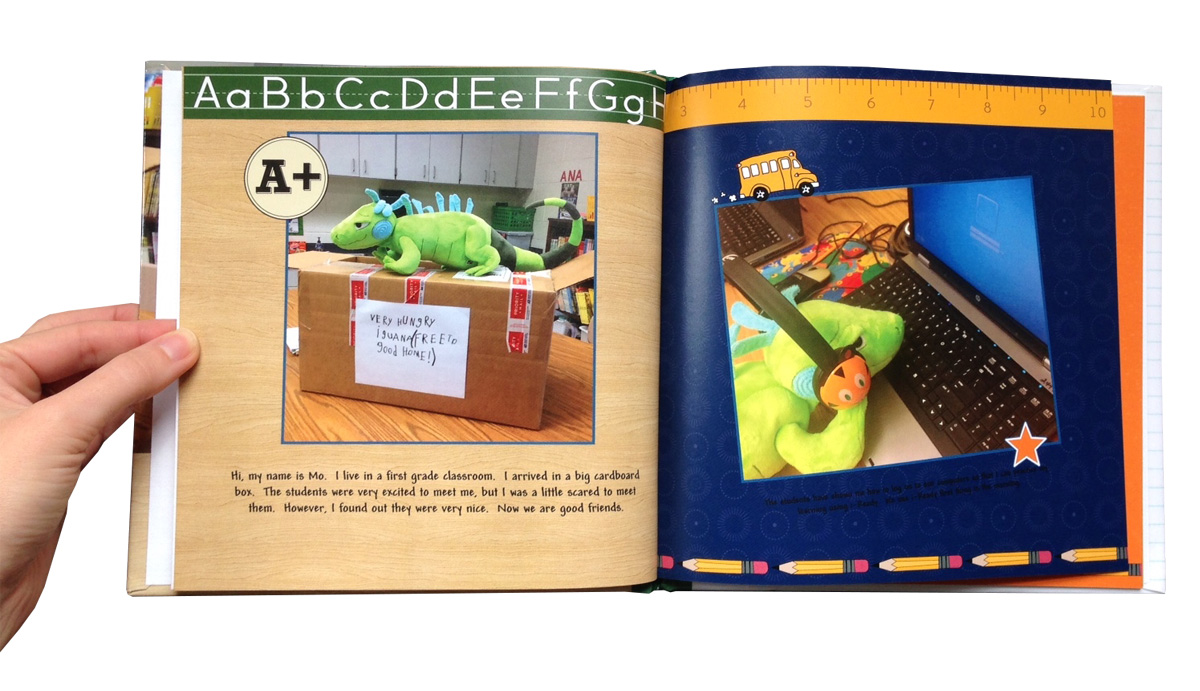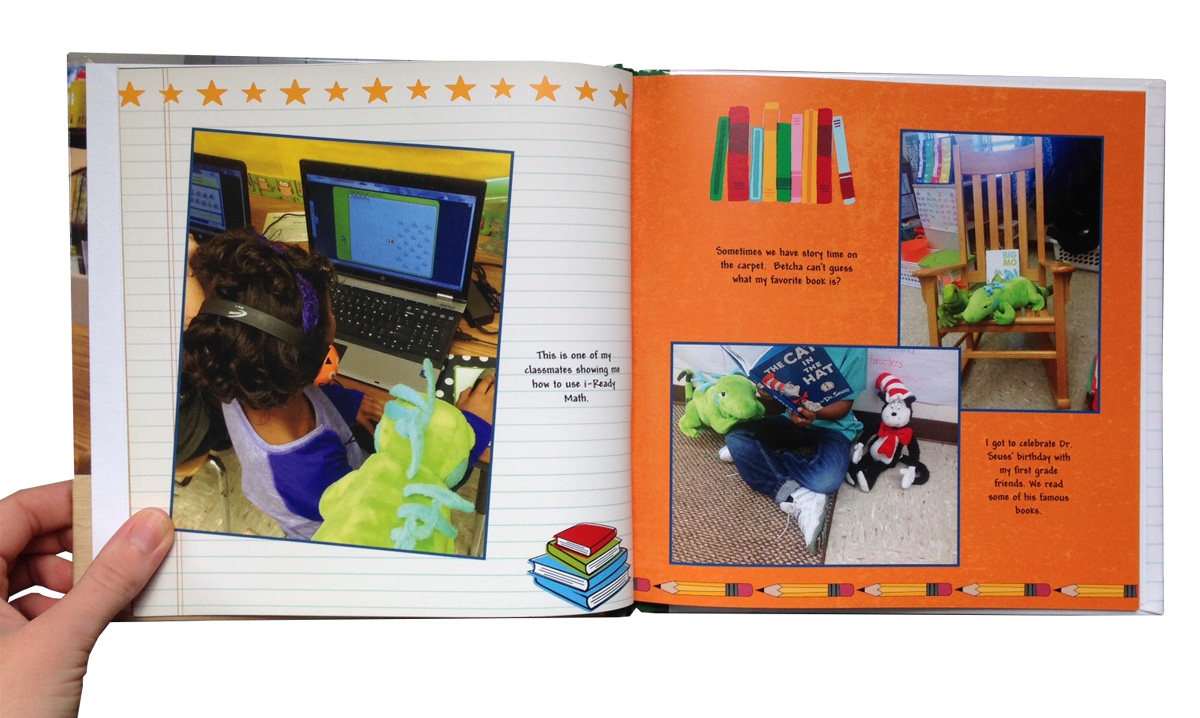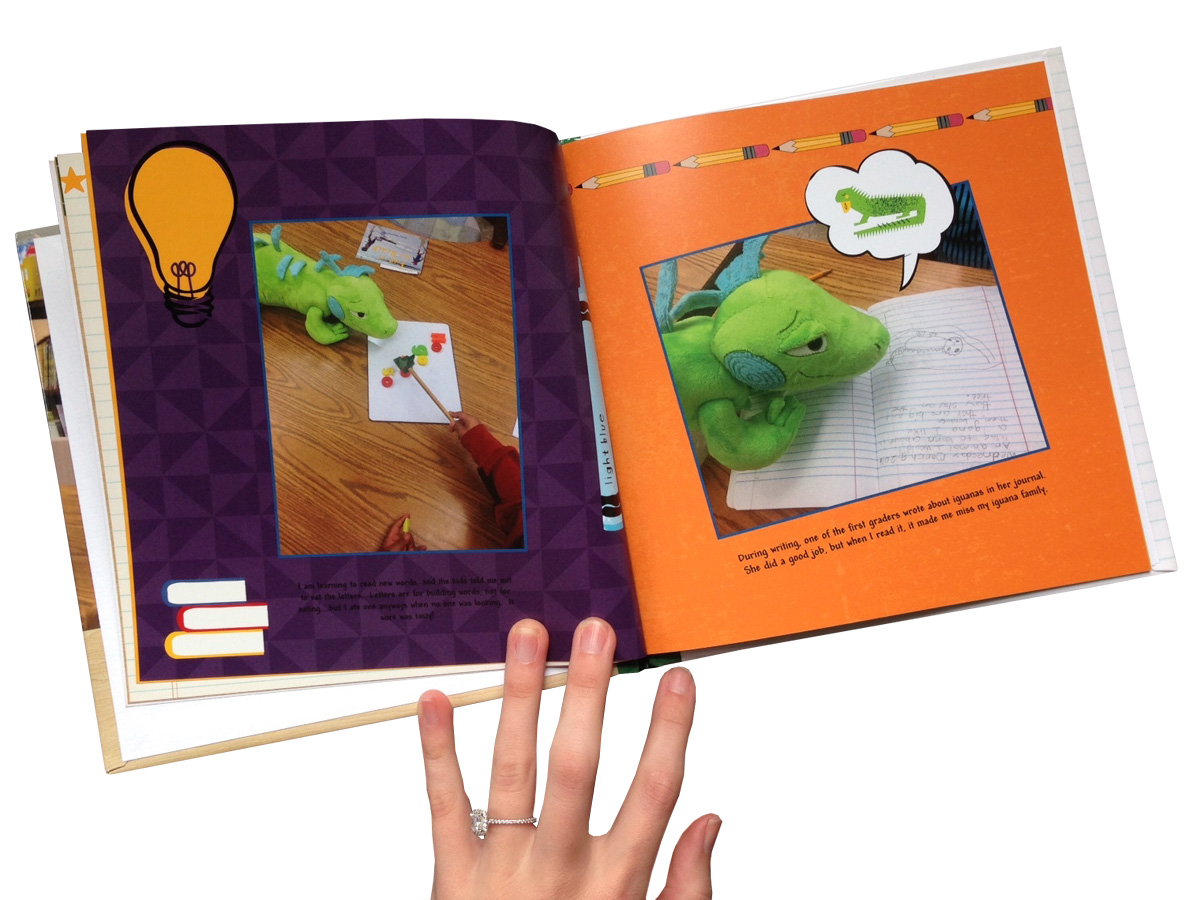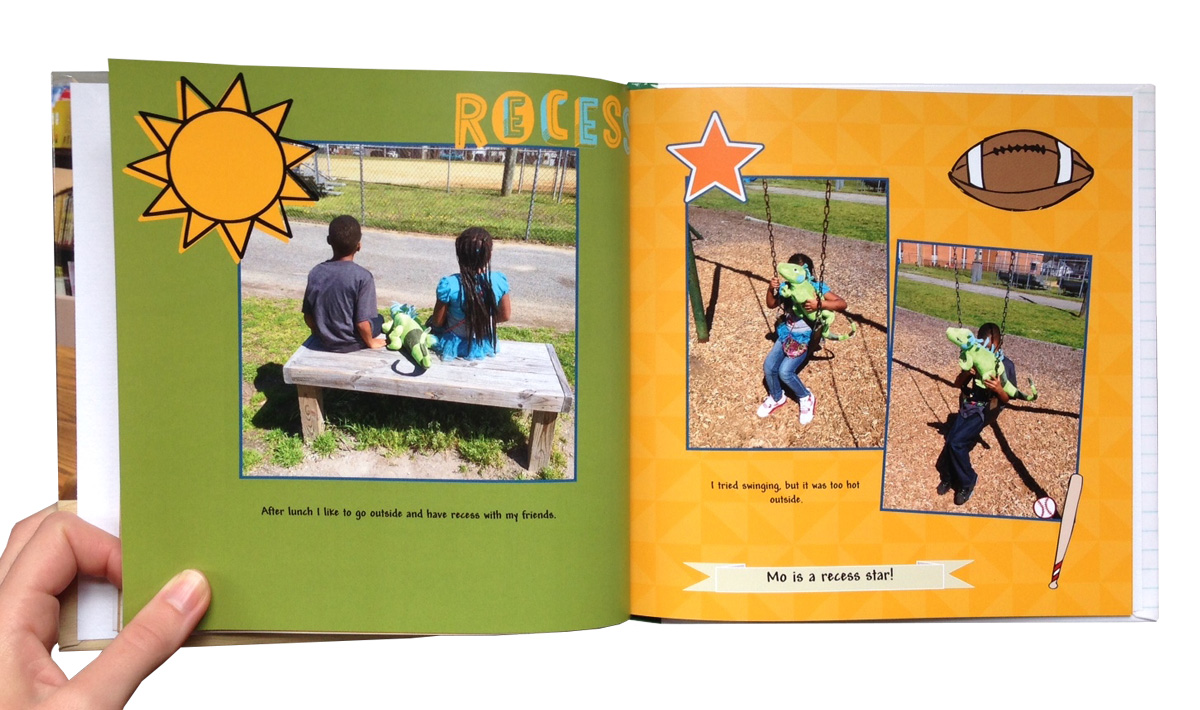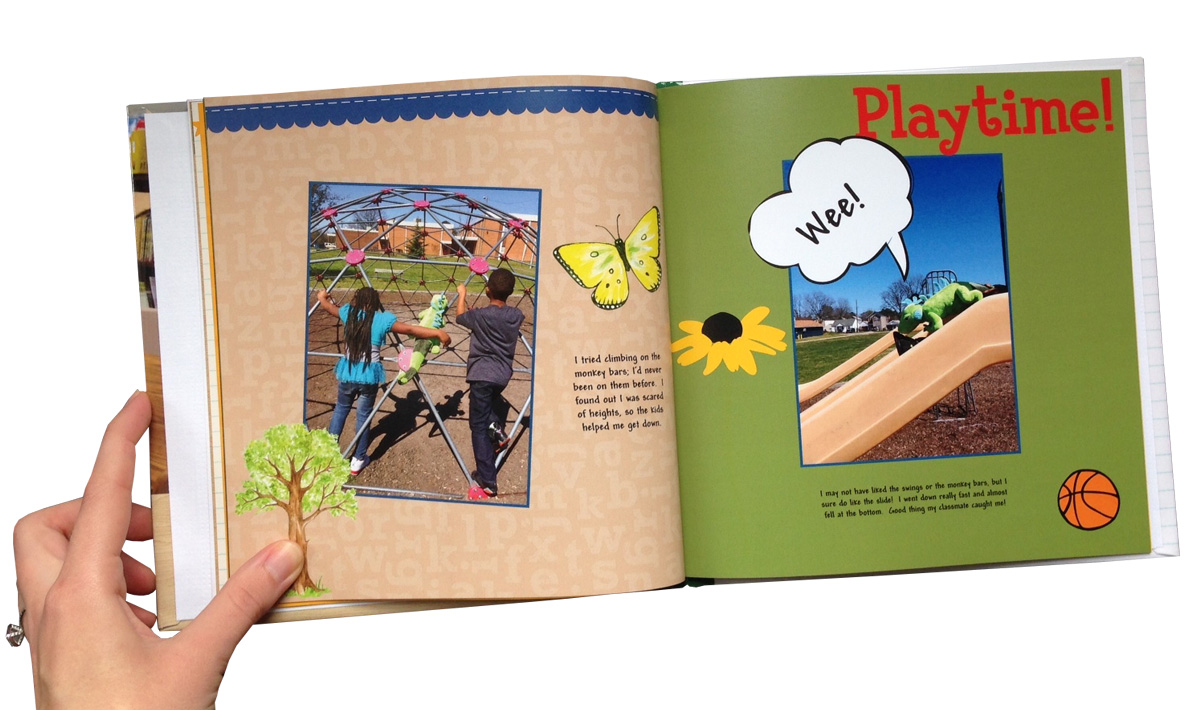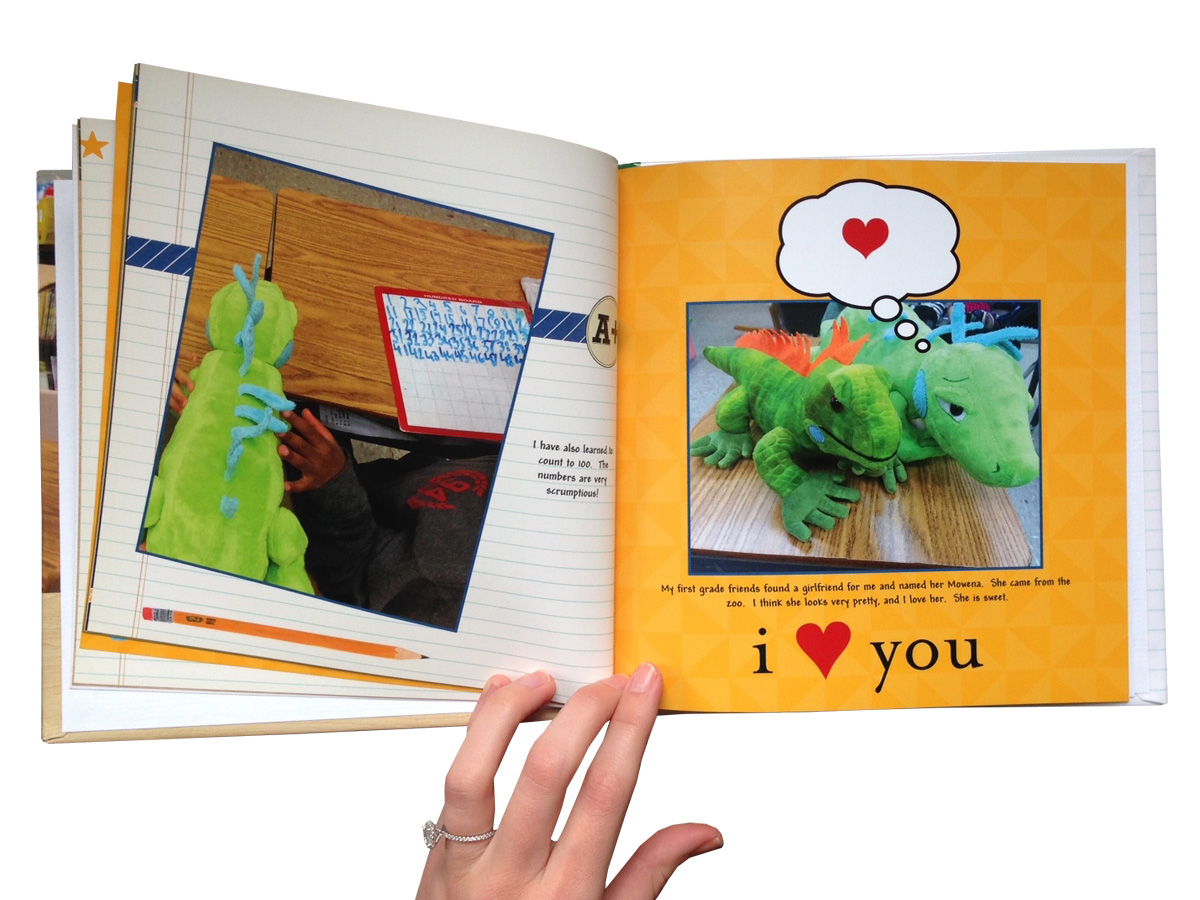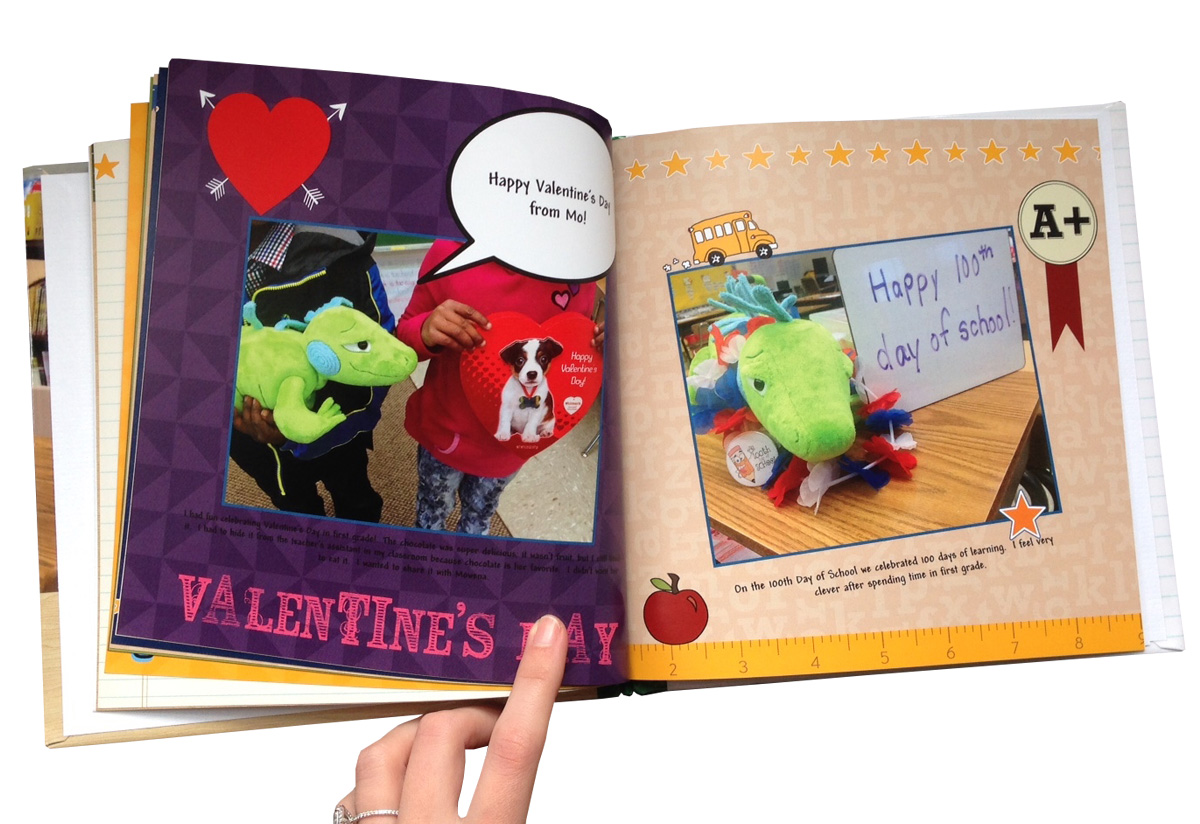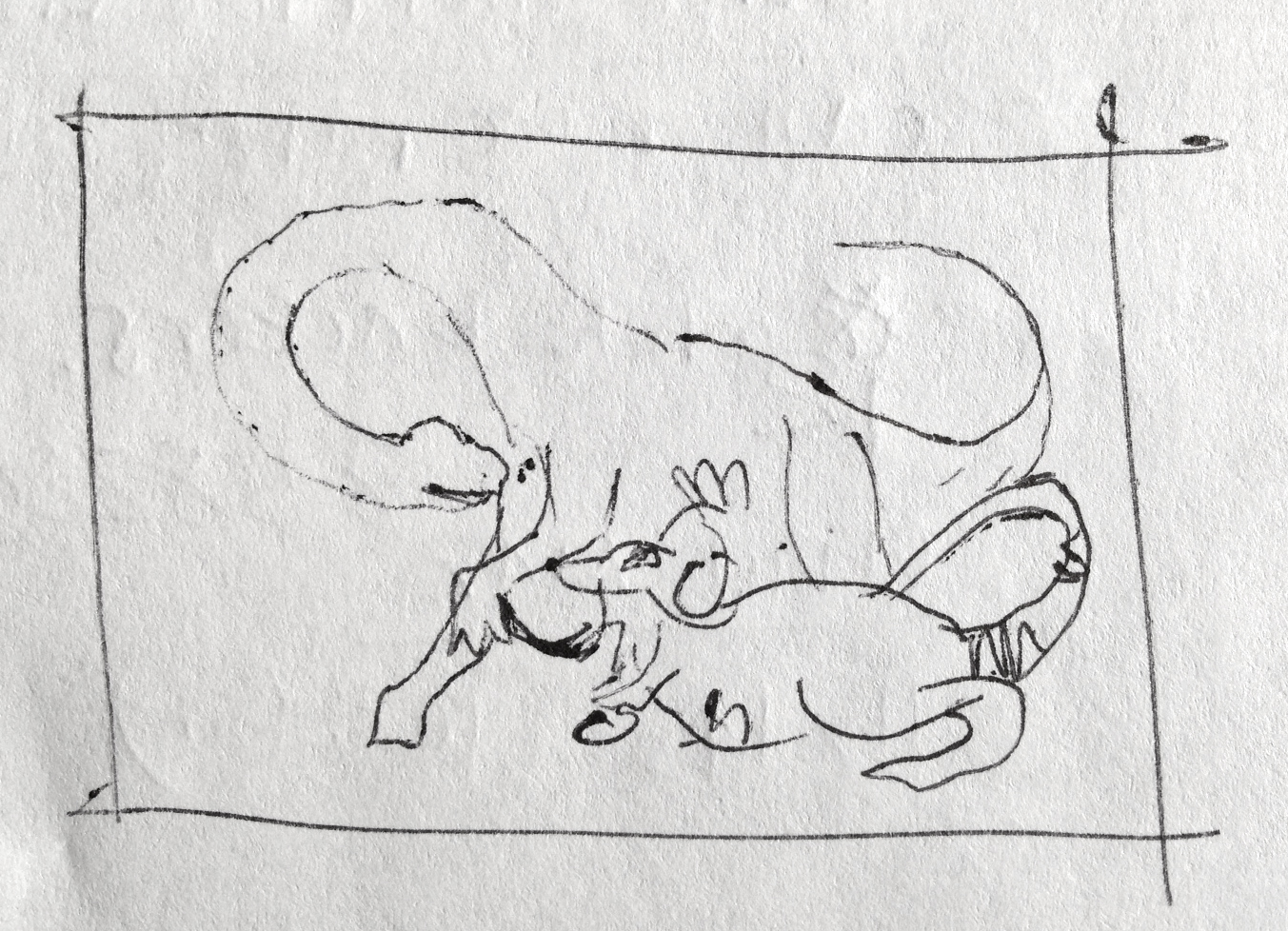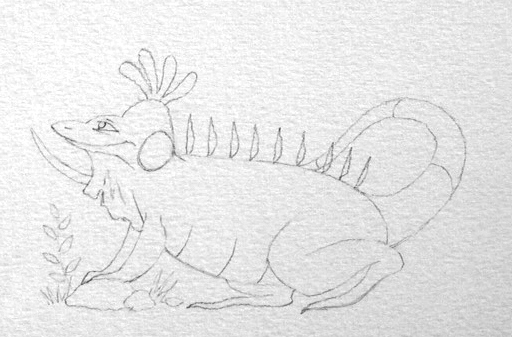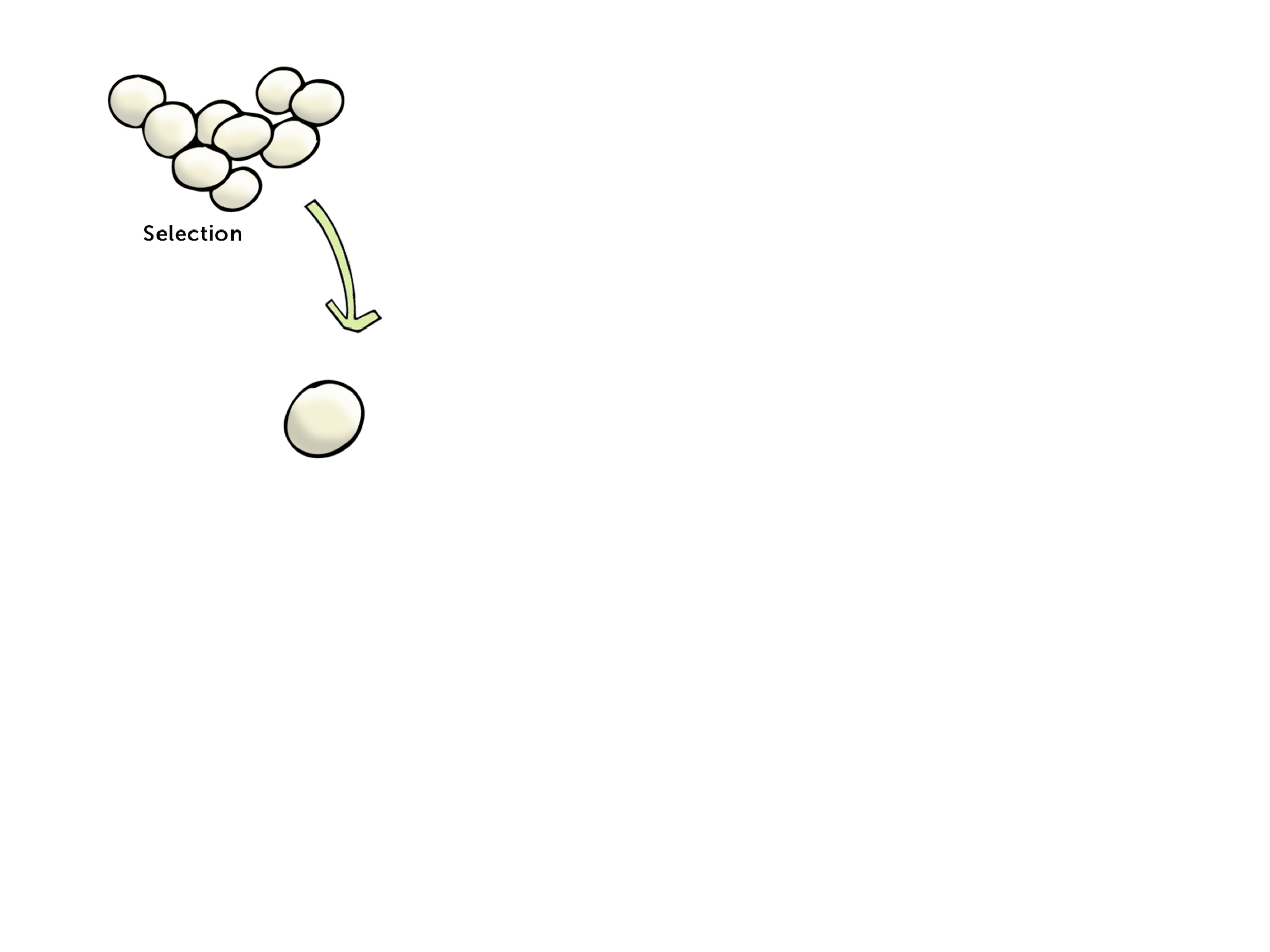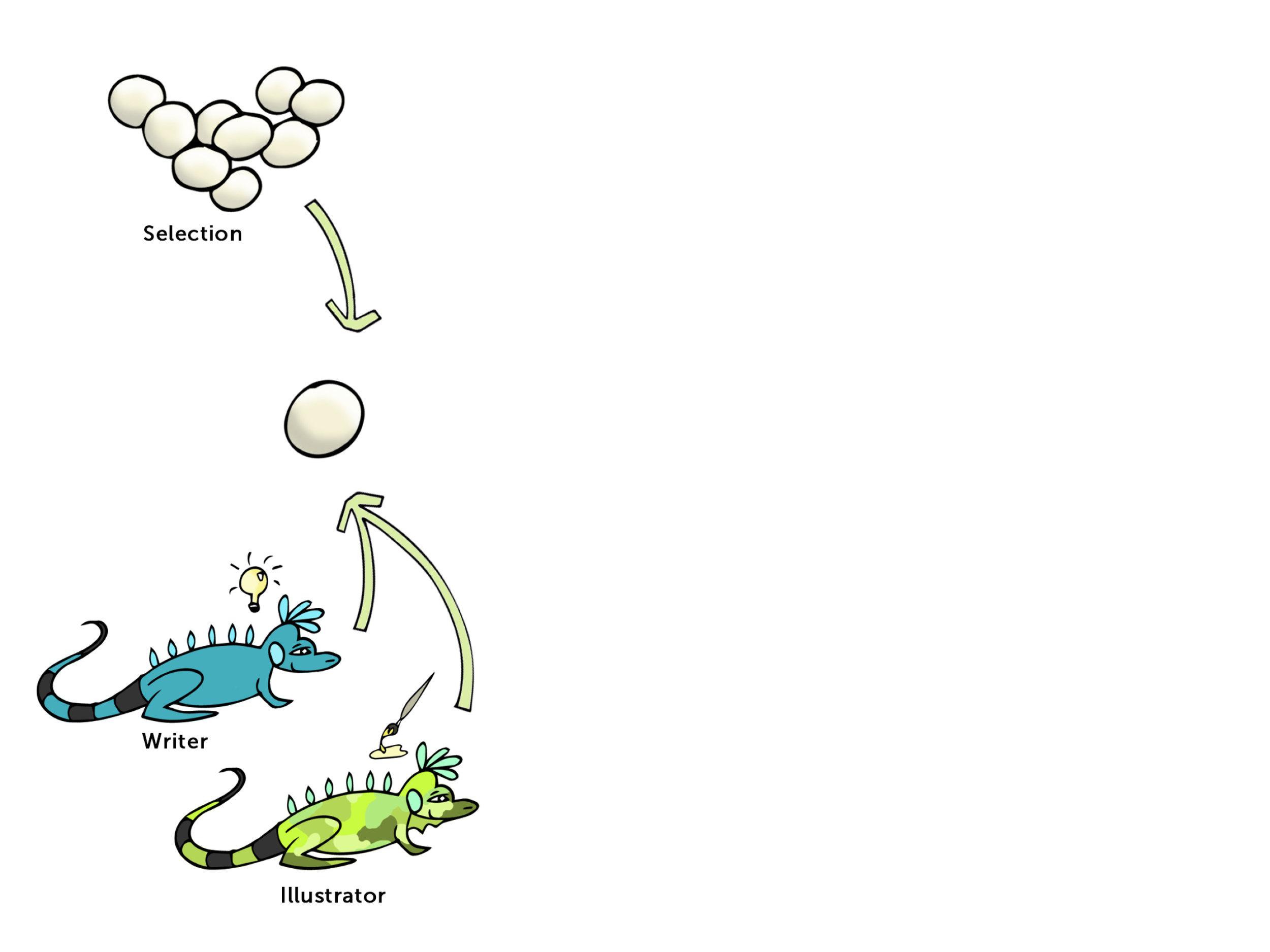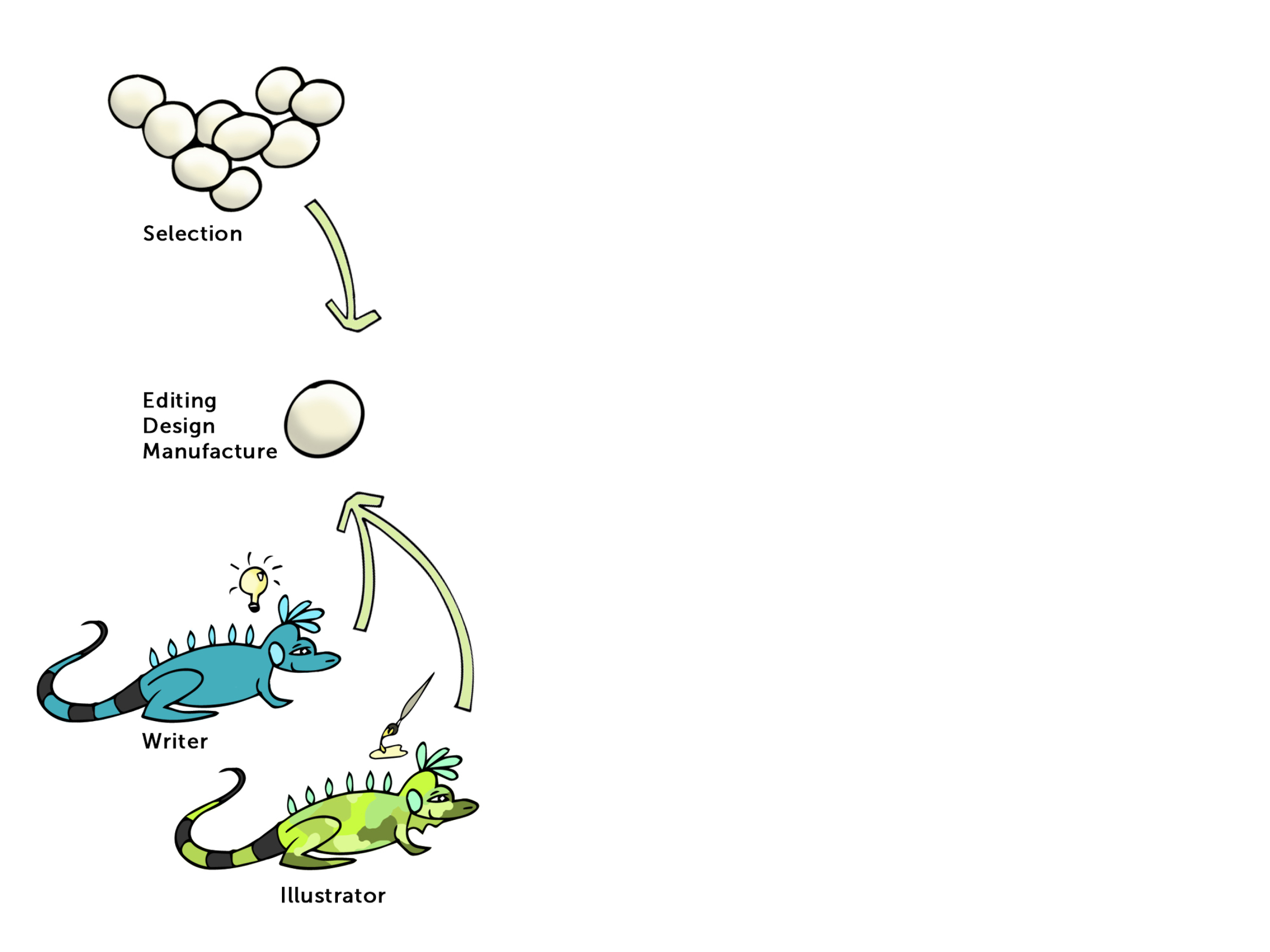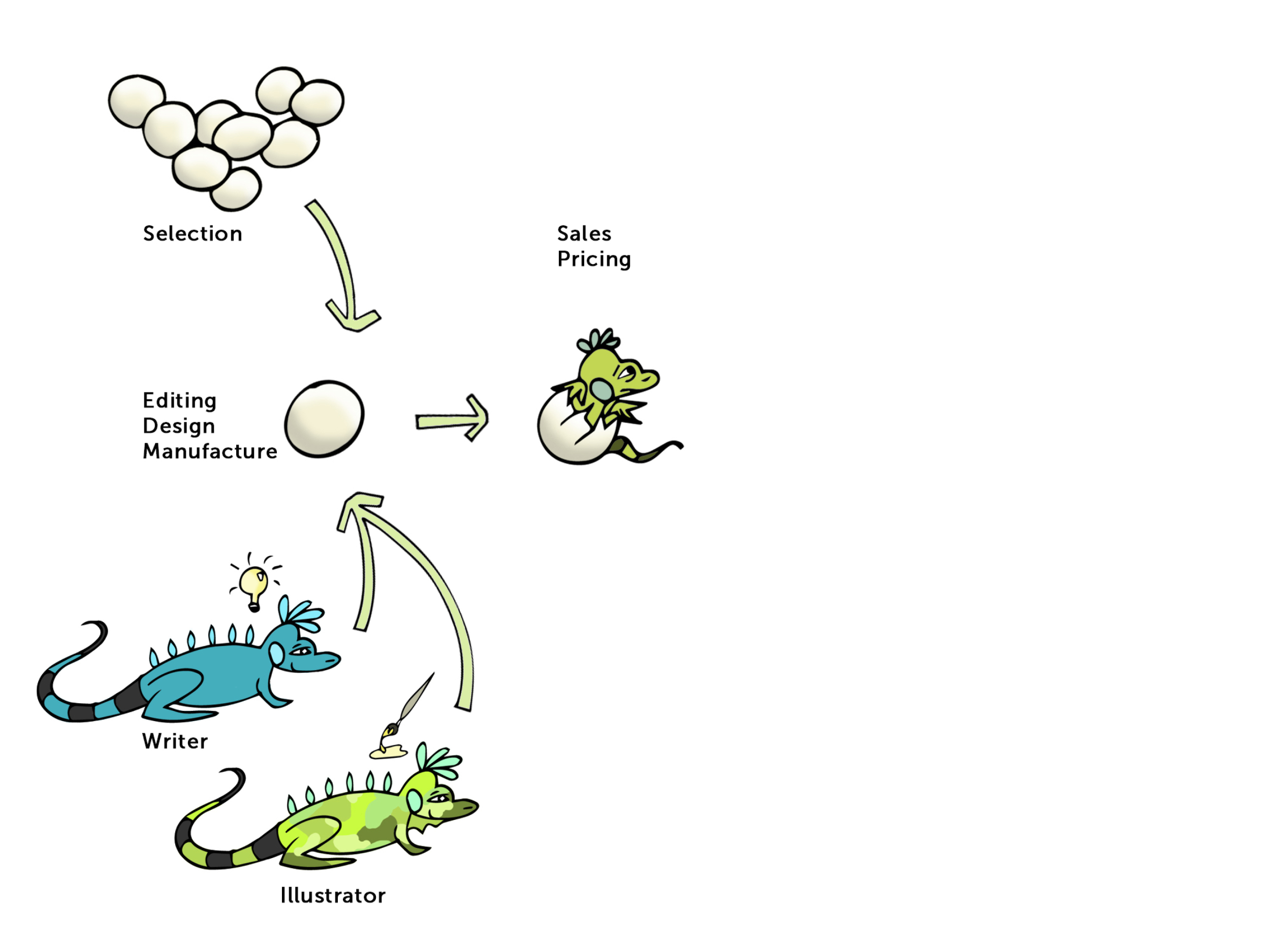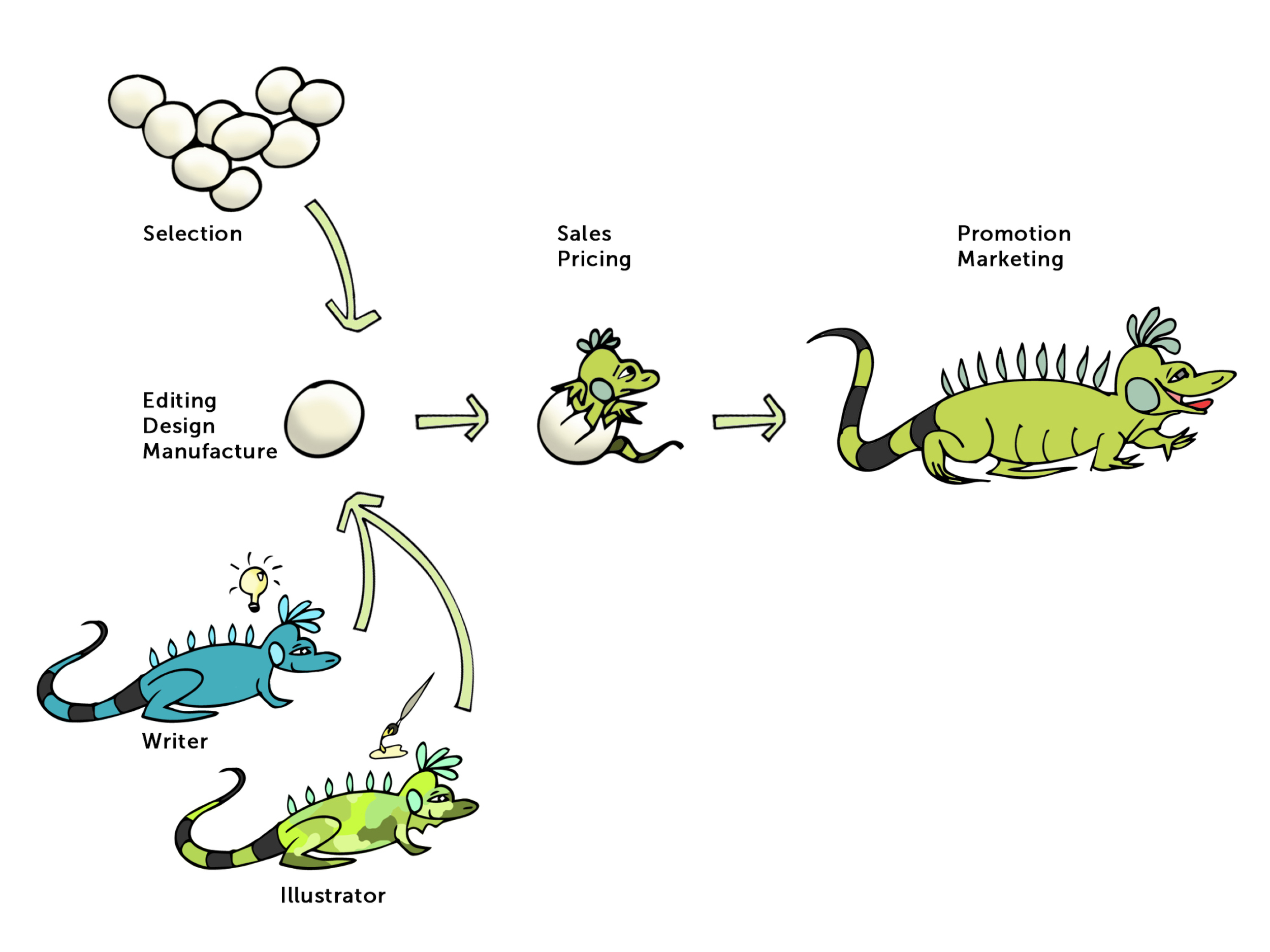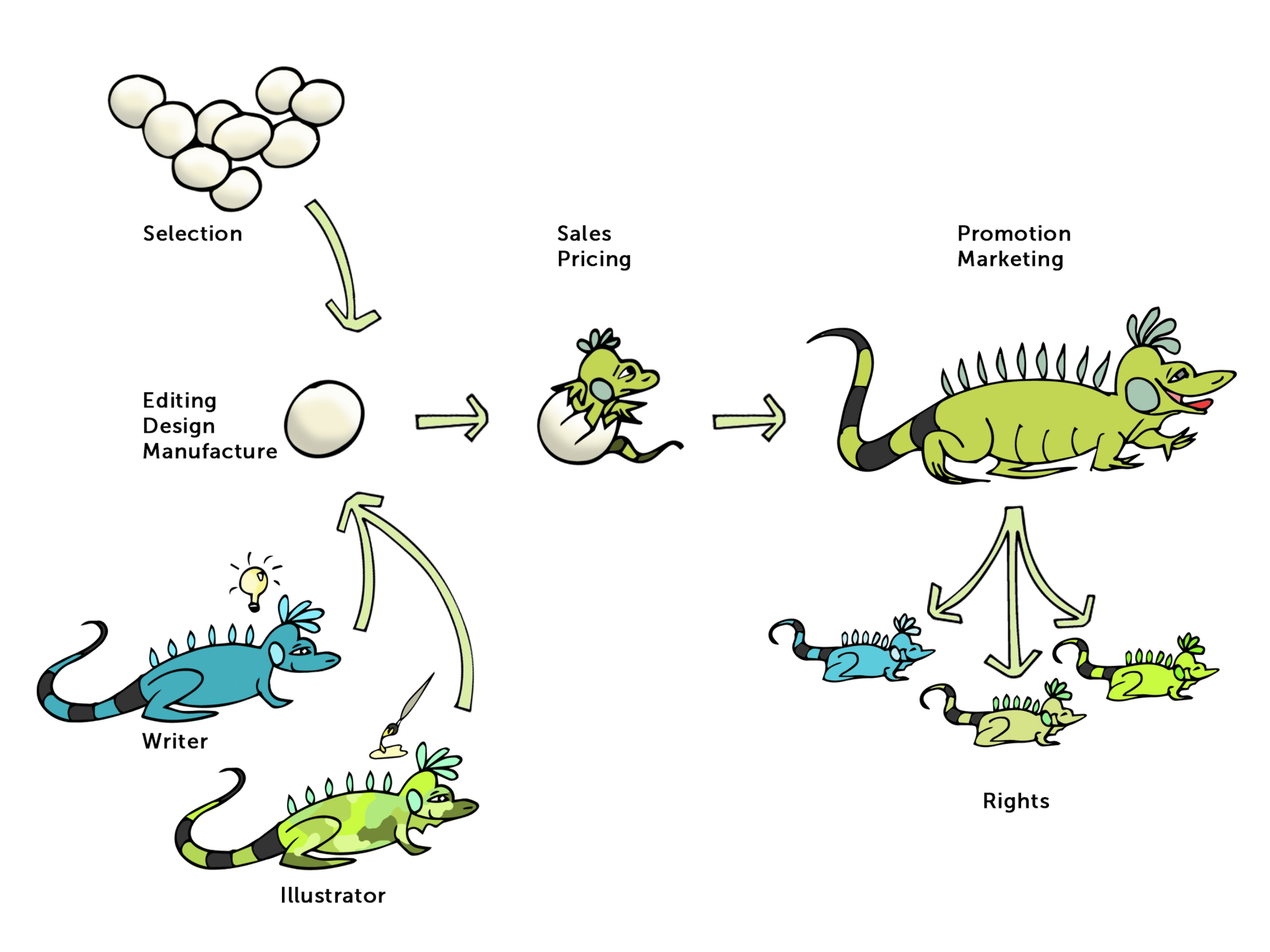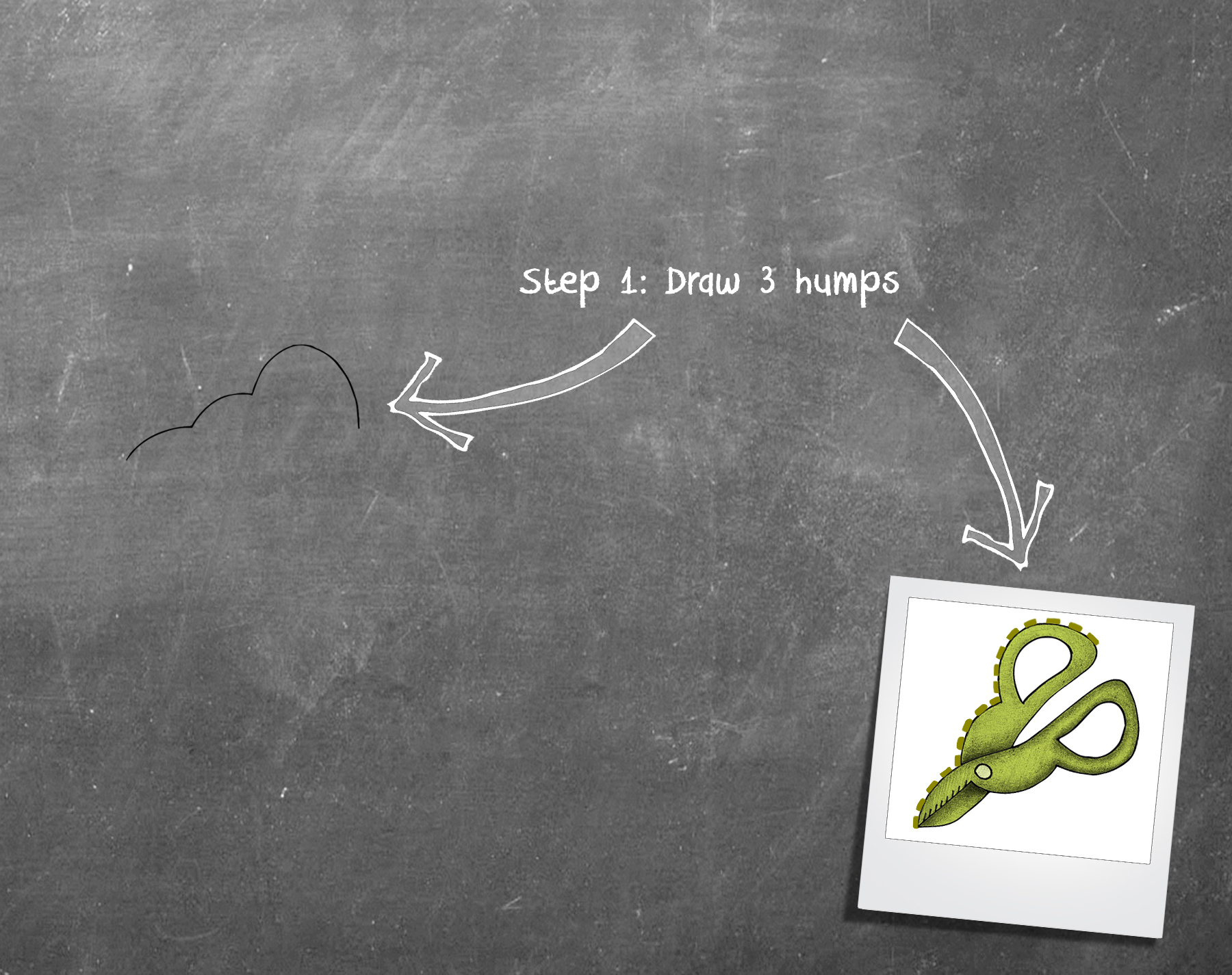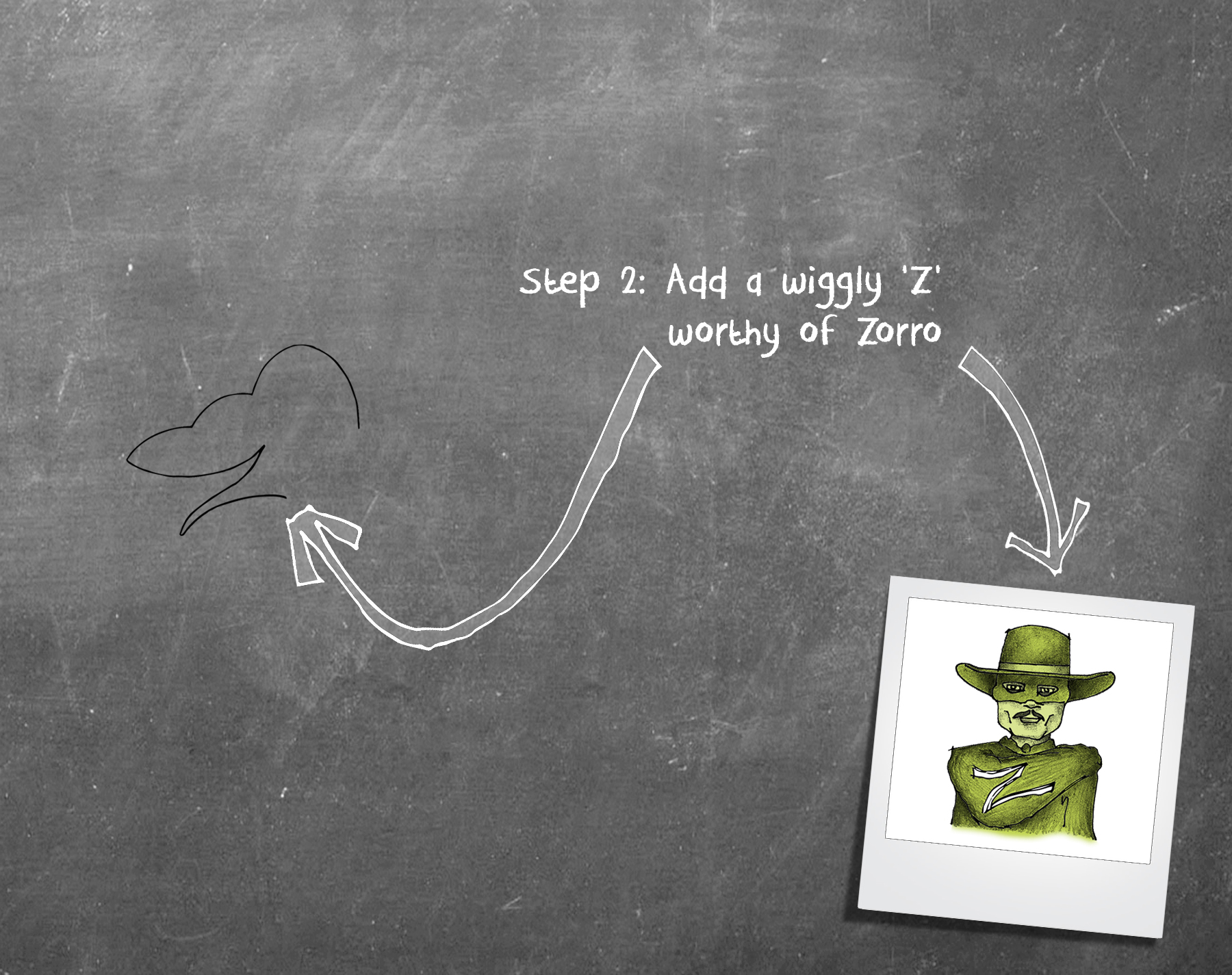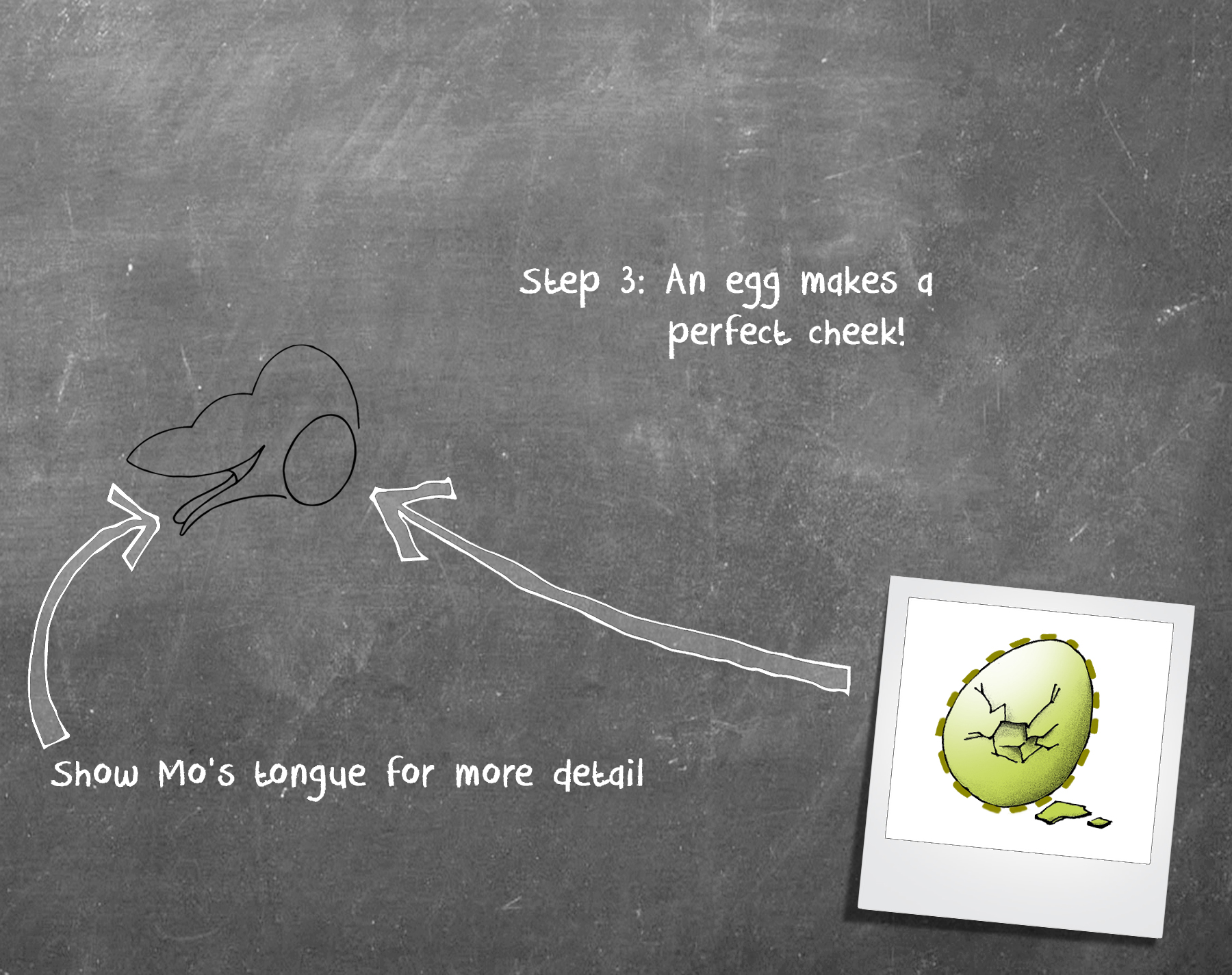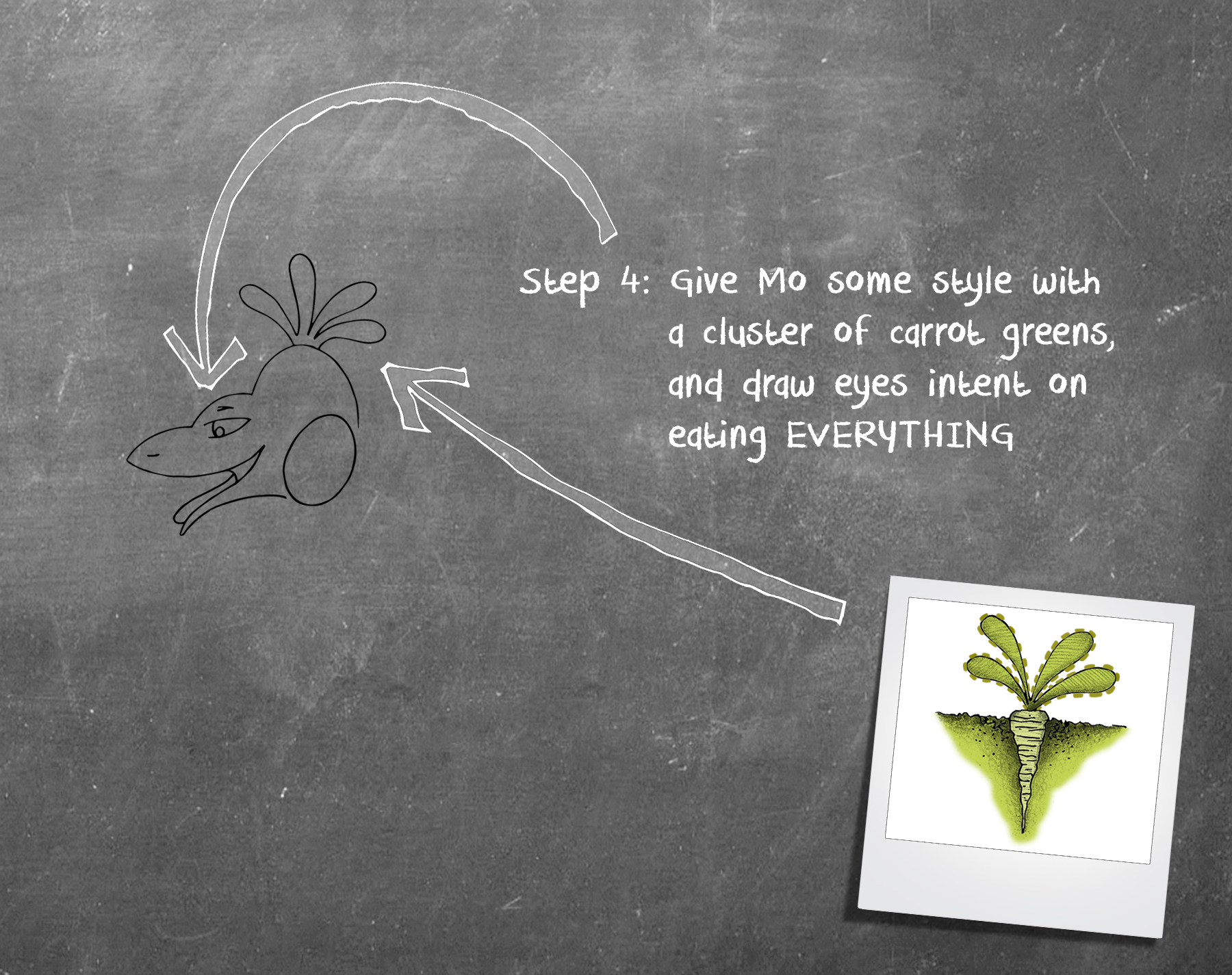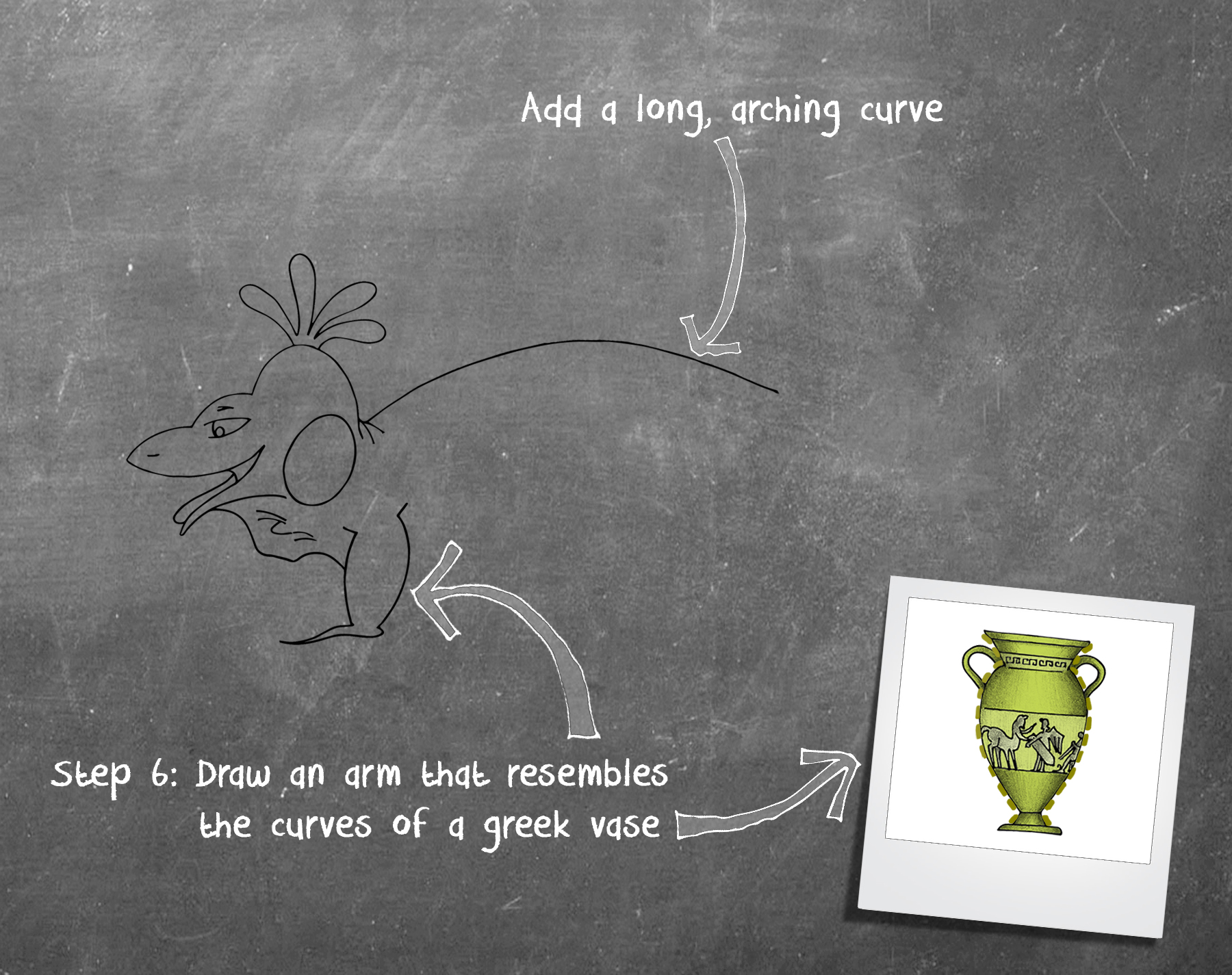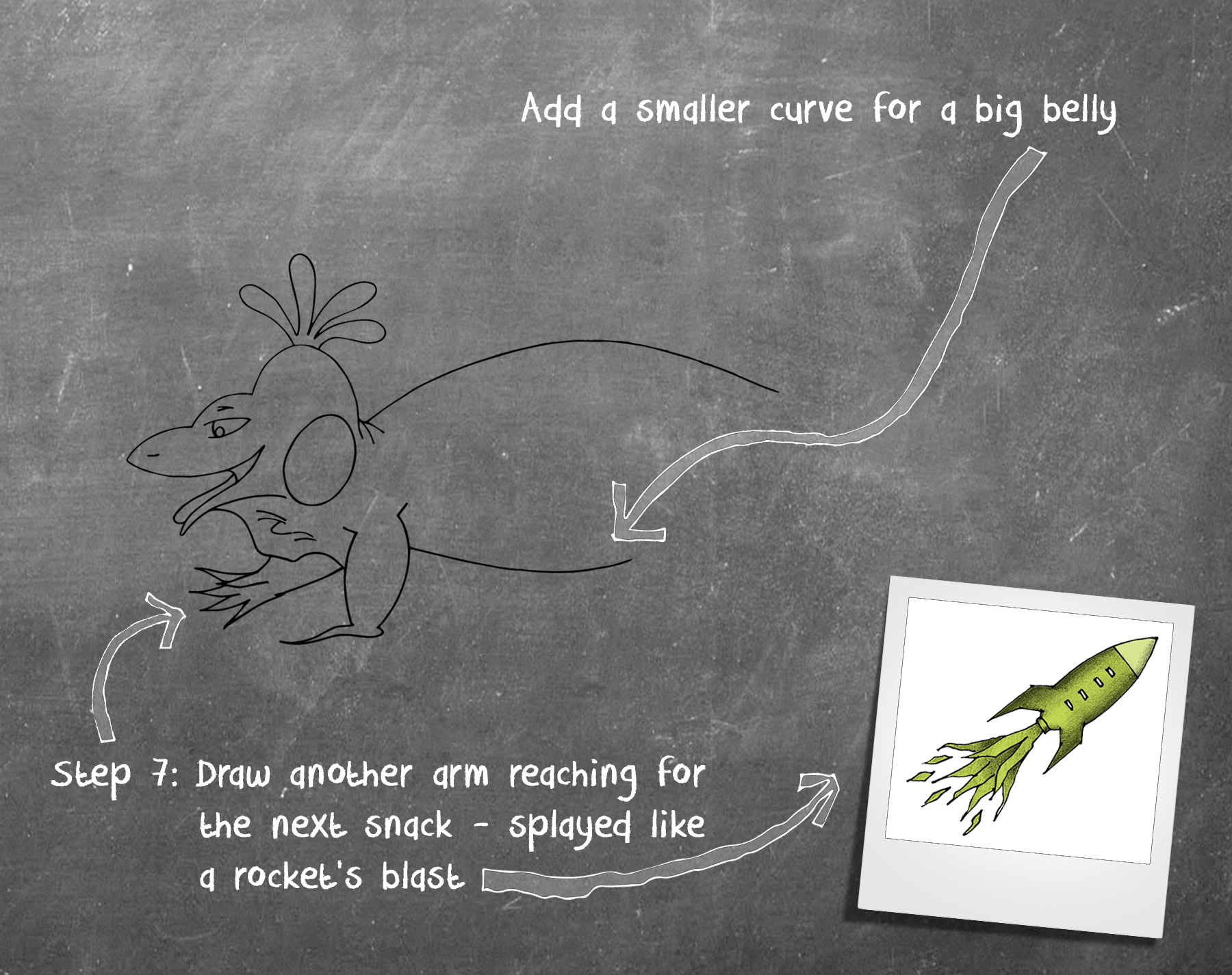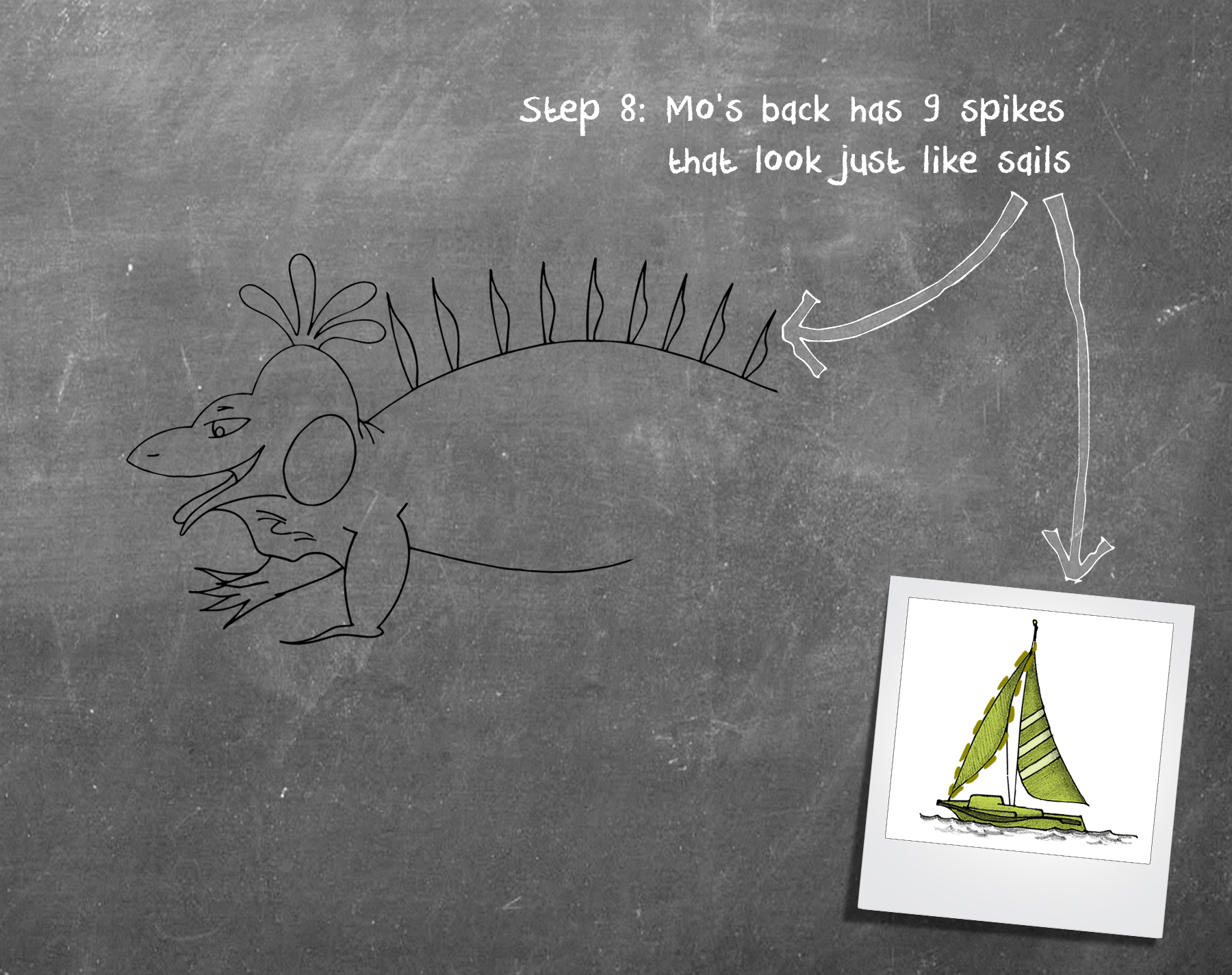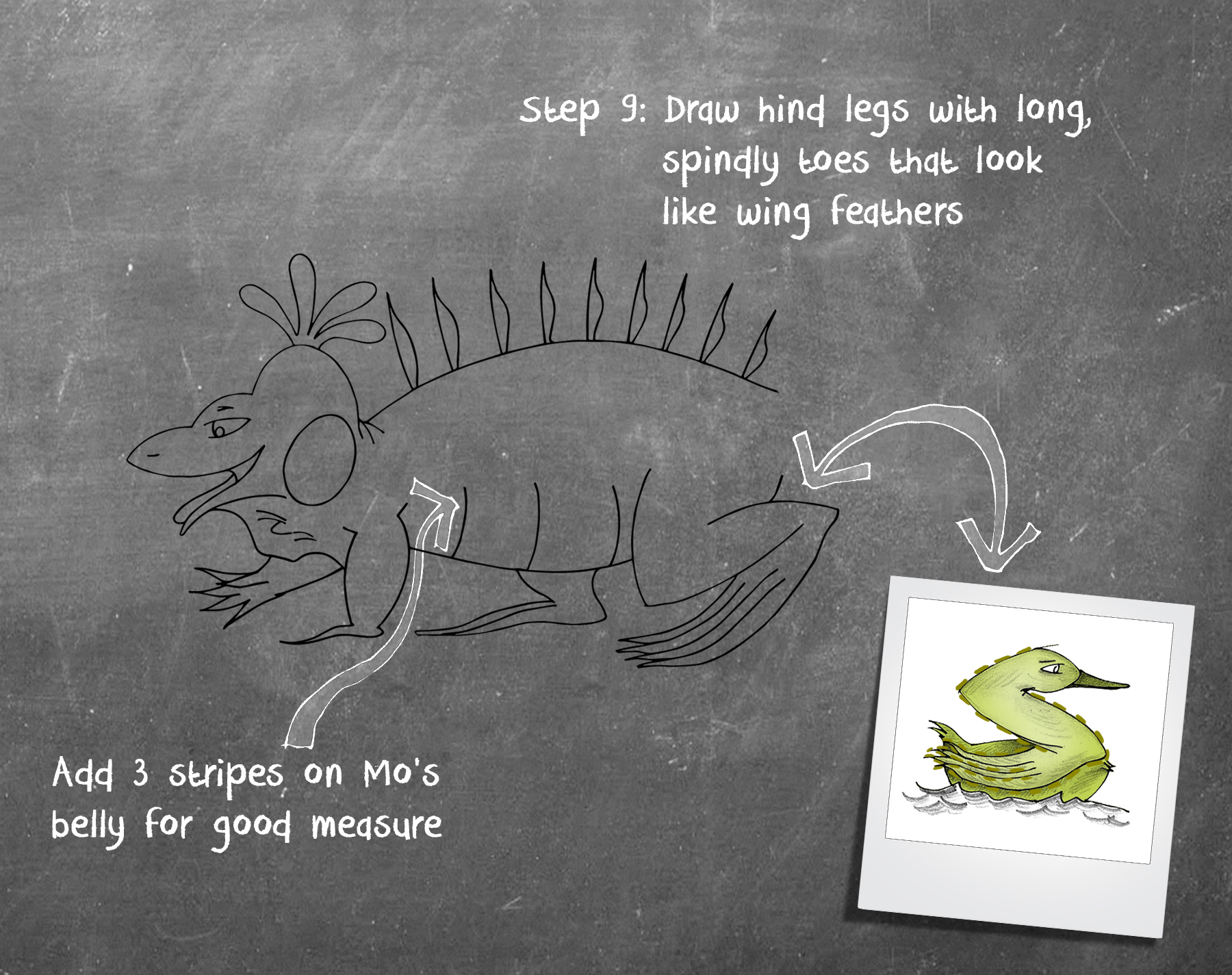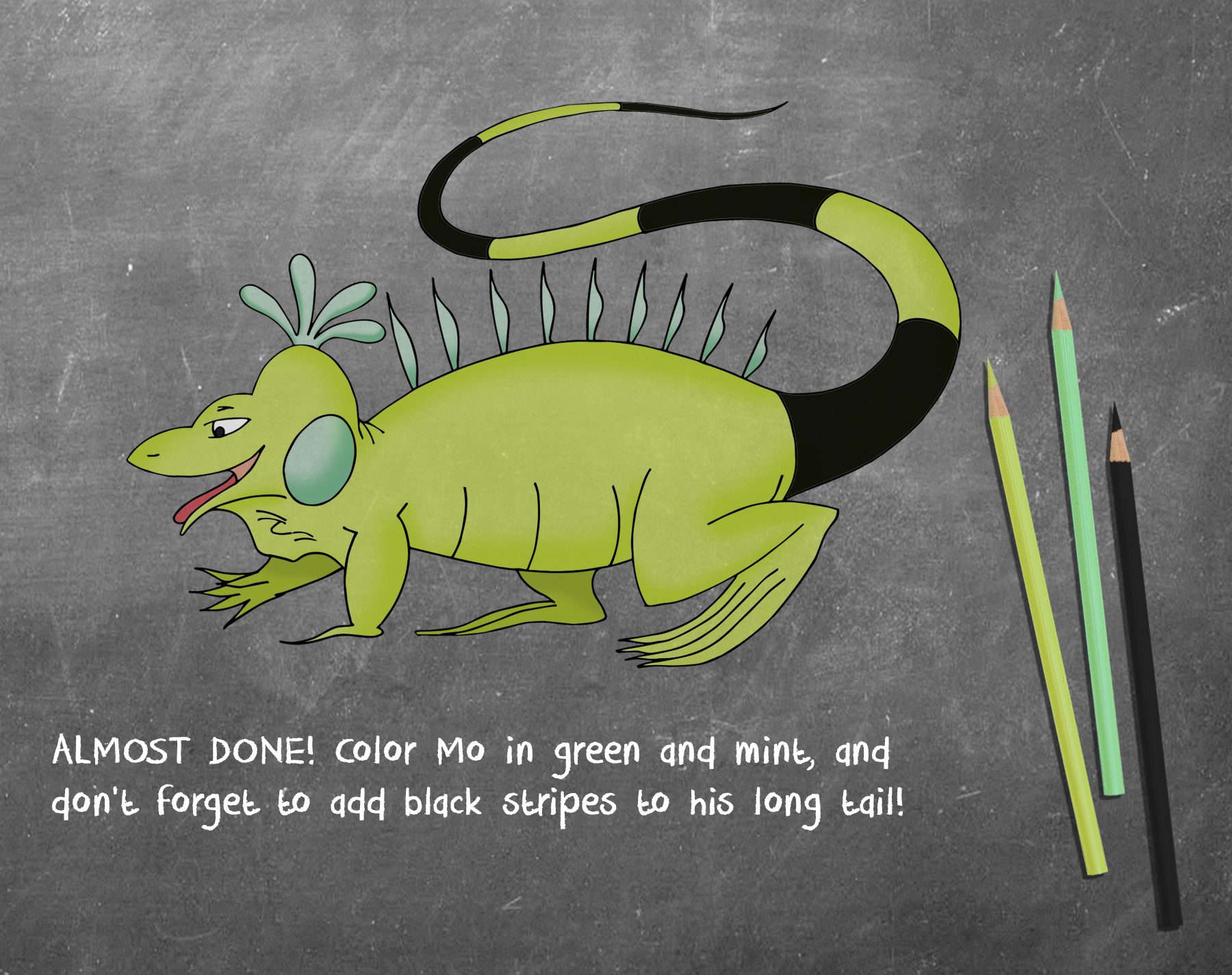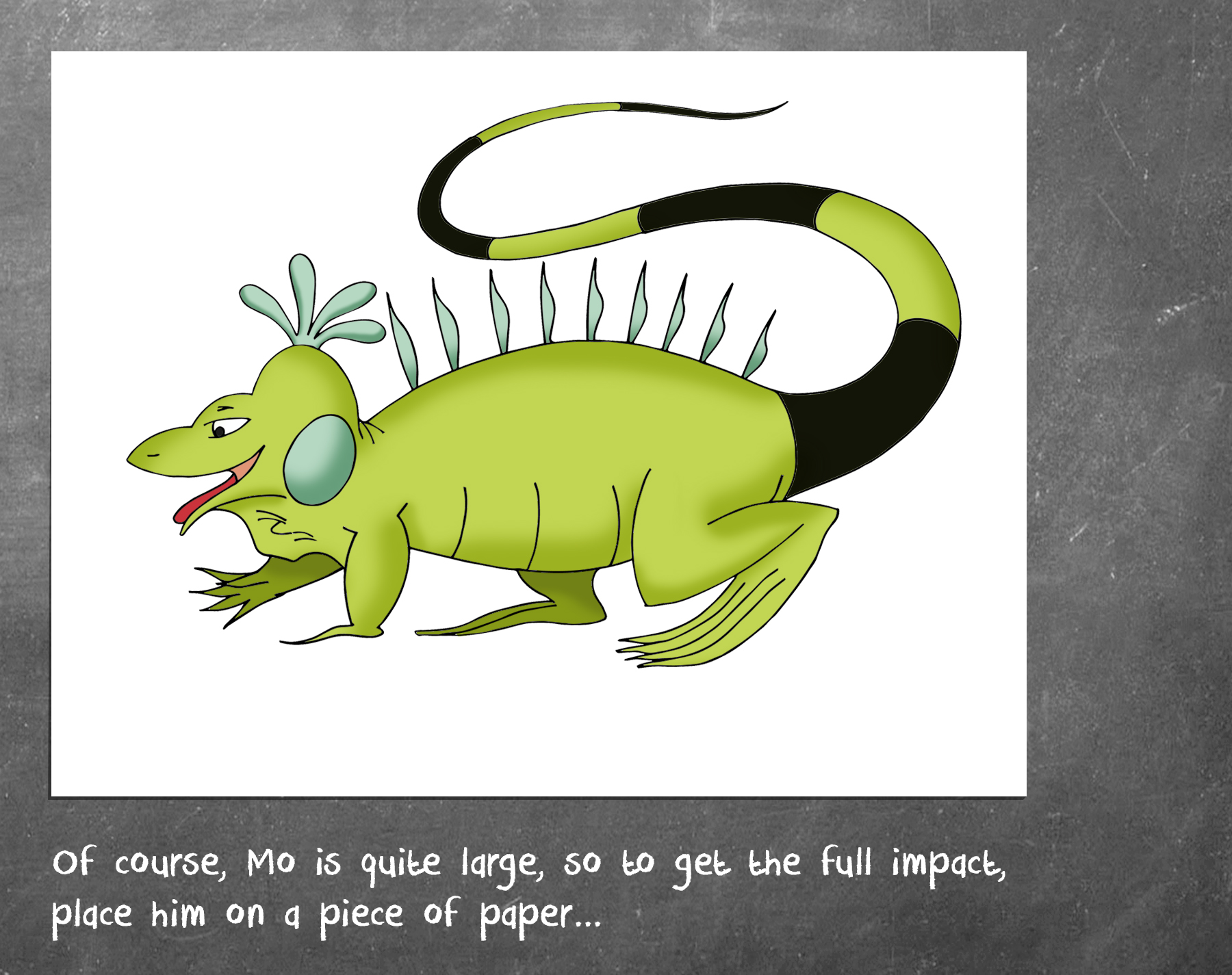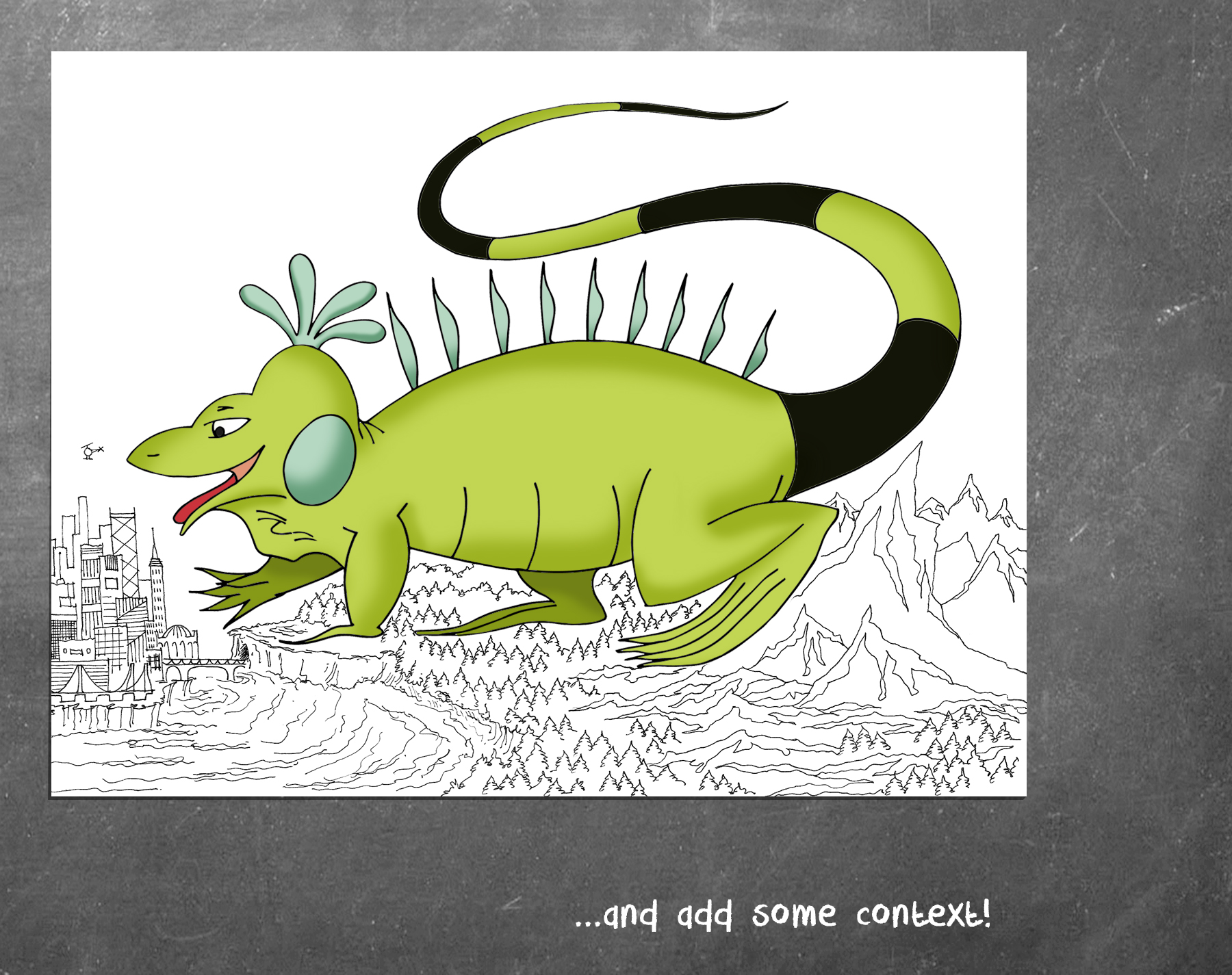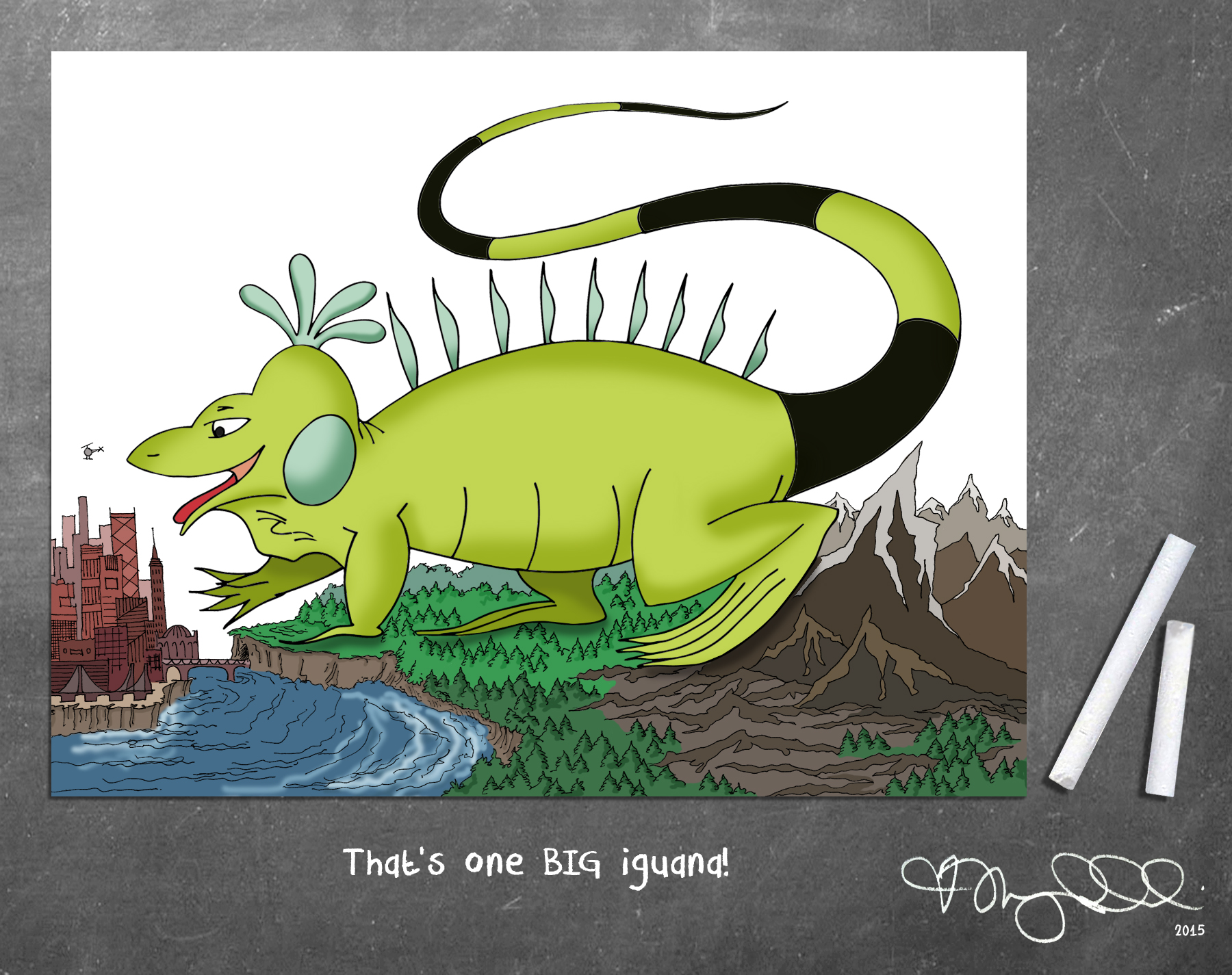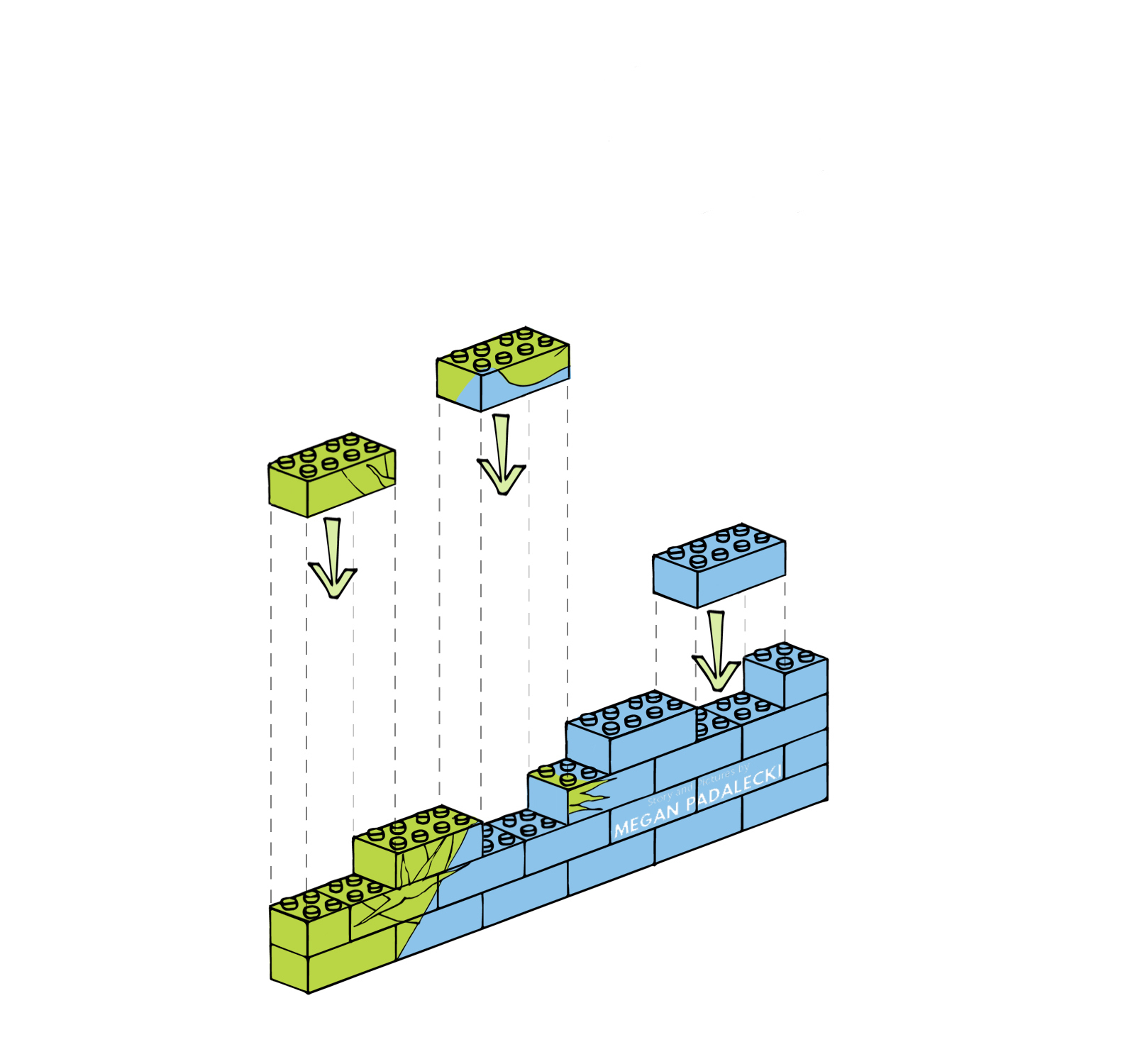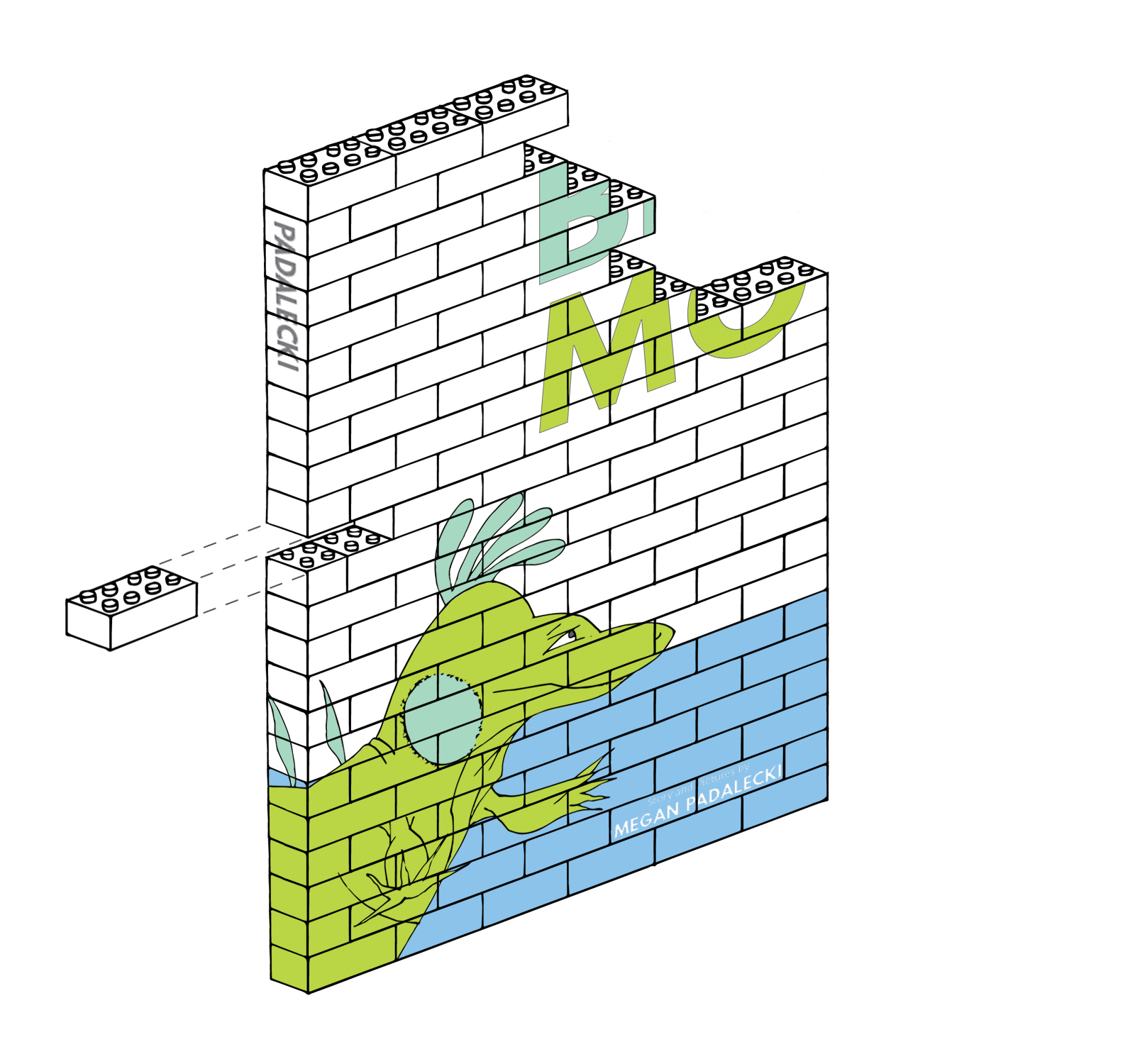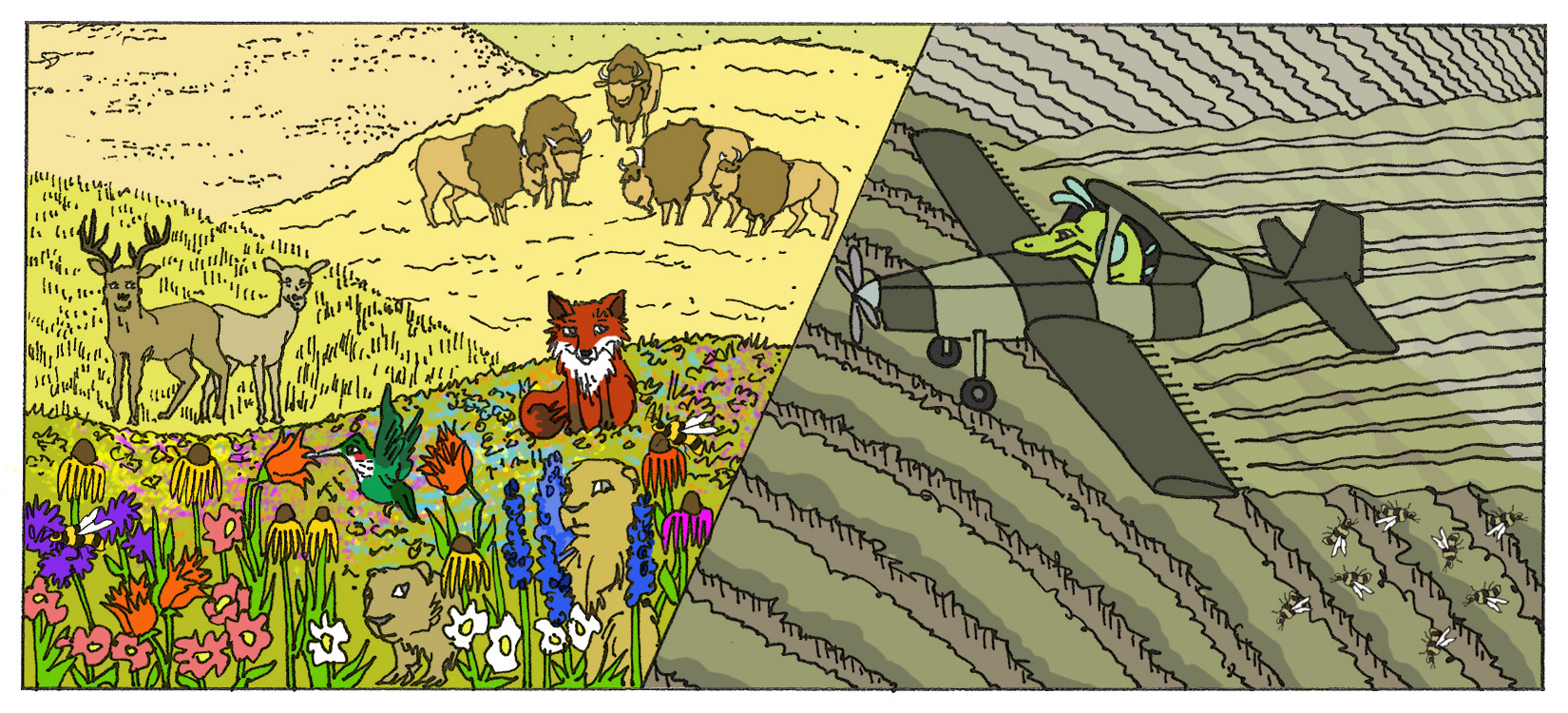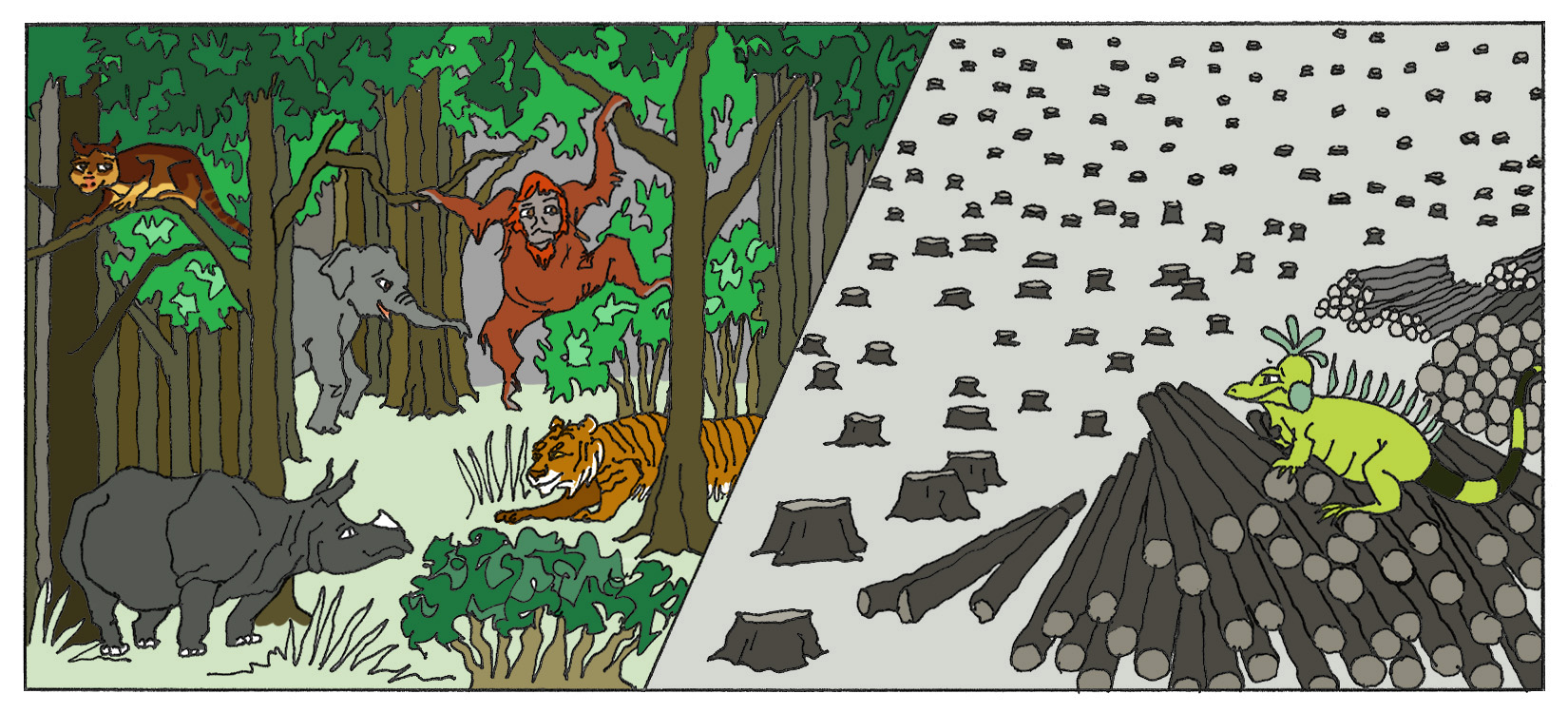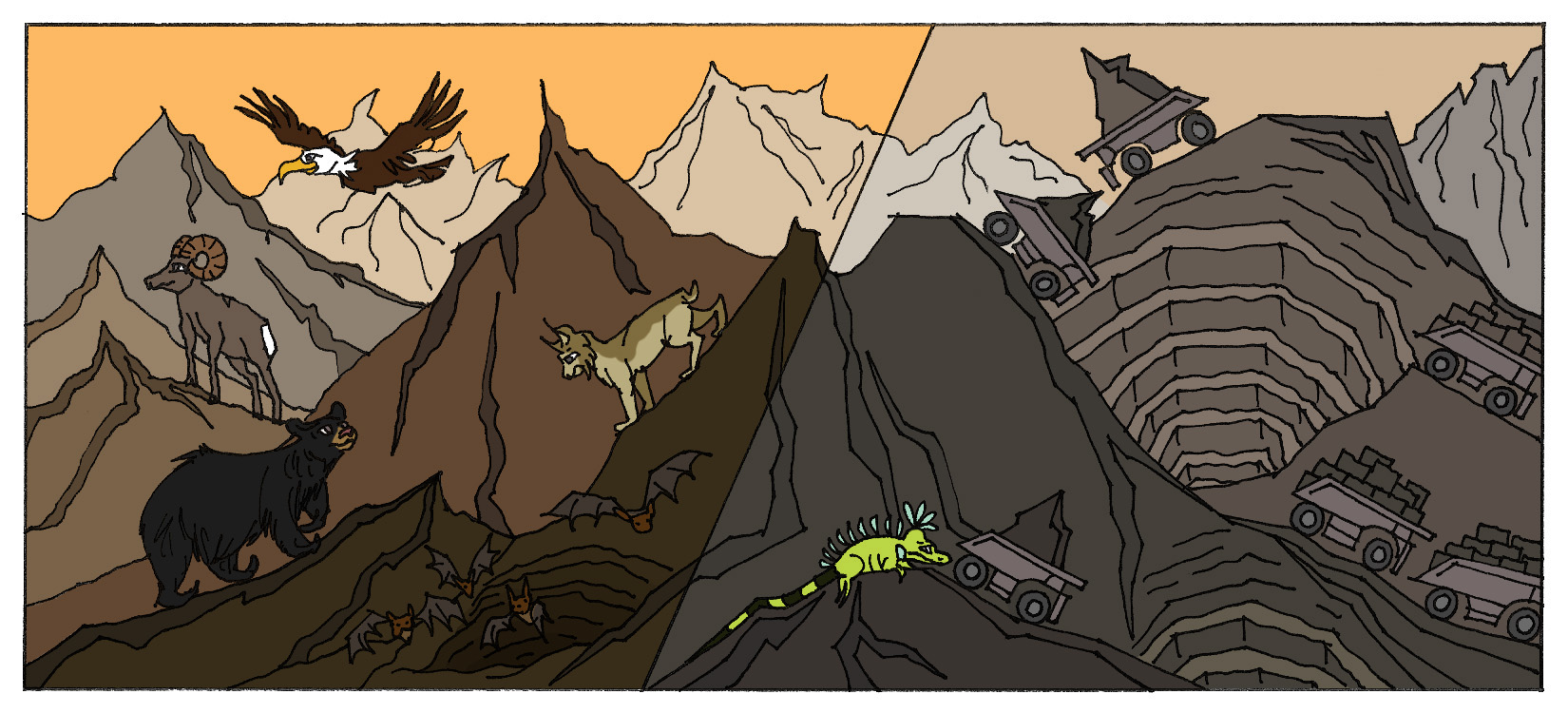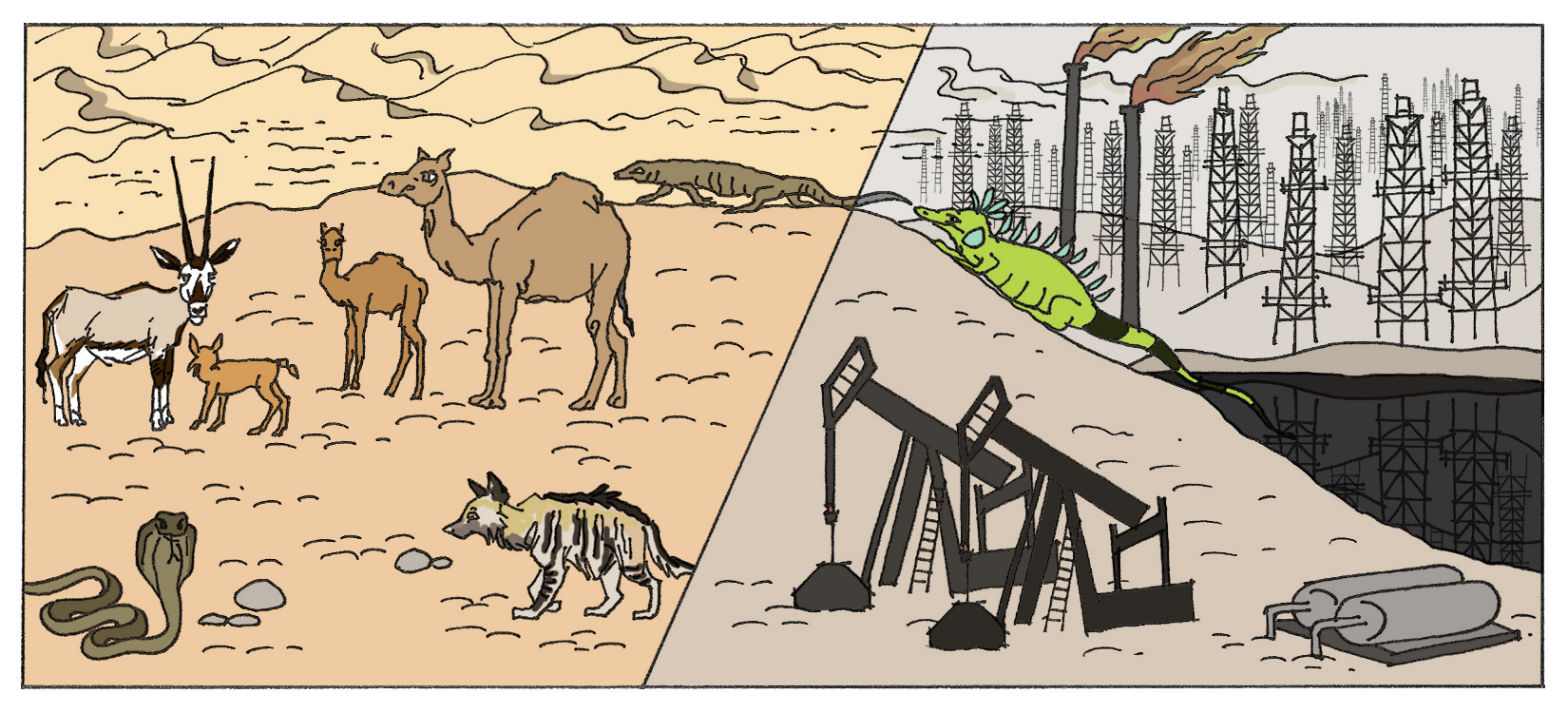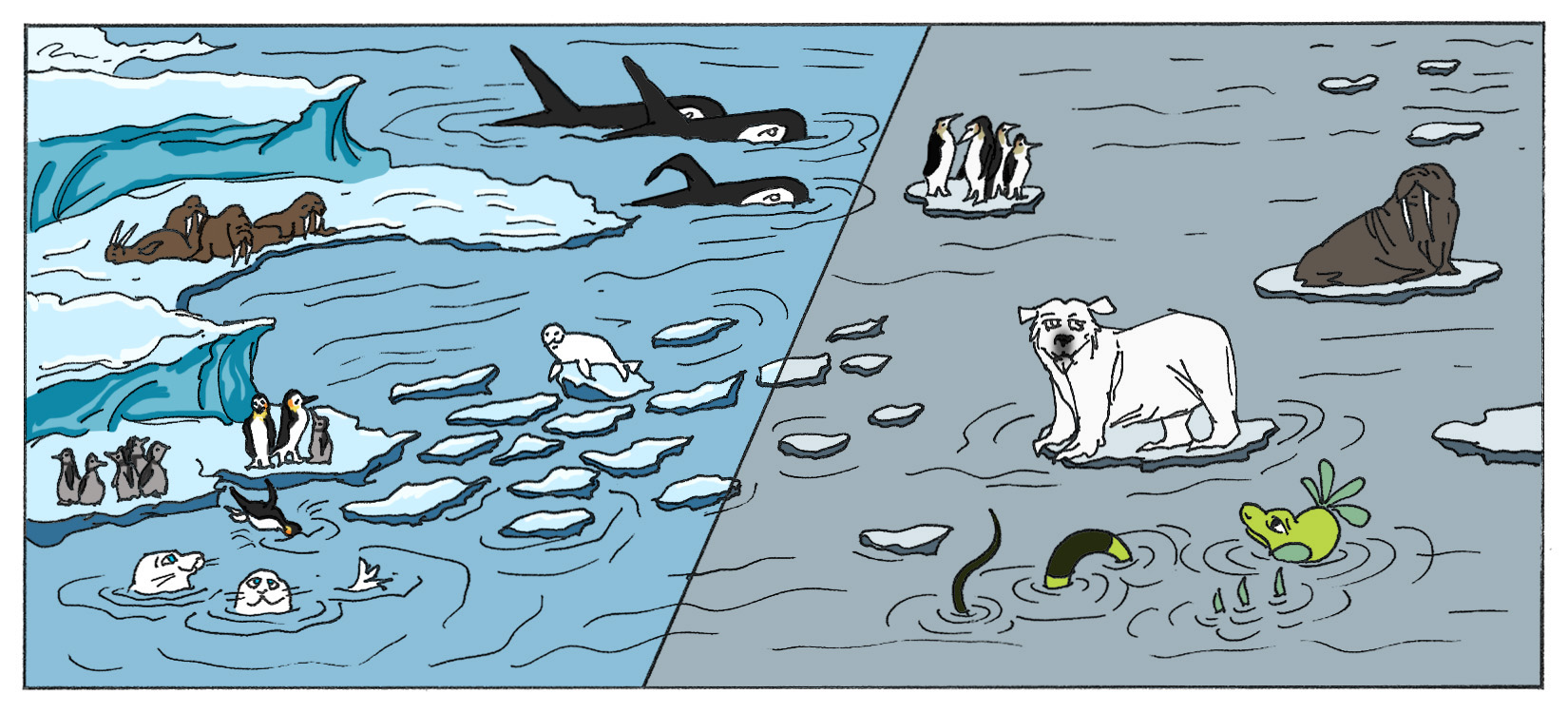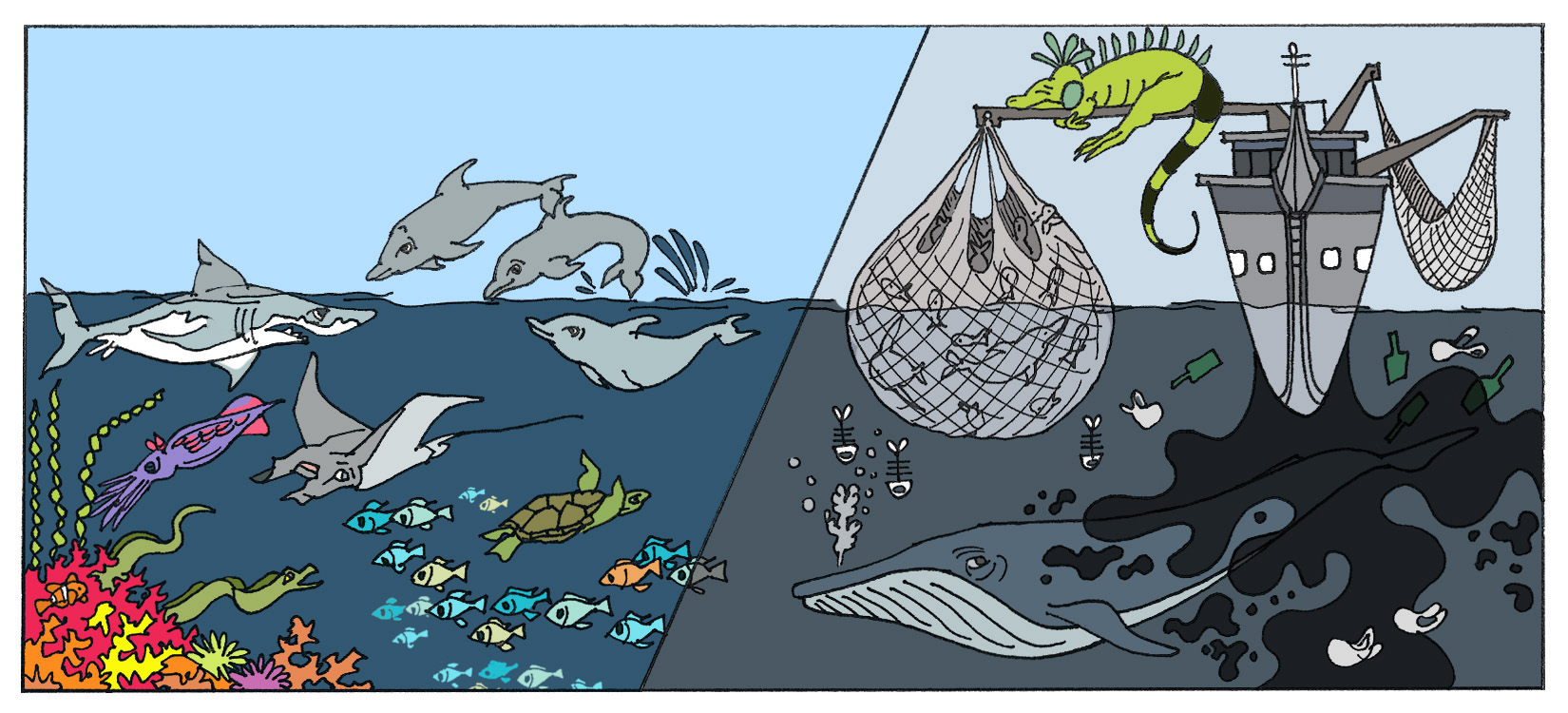With so much to celebrate about my recent volunteering trip to South Africa, I've been a little overwhelmed to write this post ... BUT ... I'm giving it a shot. With sincere gratitude to all who contributed to the fundraising campaign, I hope this will give you a sense of the good work your donation supported!
Shall we begin?
... but first, not to brag or anything, but I consider myself an expert packer. When traveling in an adventure scenario, it's especially important to be nimble on your feet! Hence, two small backpacks for three weeks of travel.
I call it the Pregnant Camel look.
PART 1
See those numbers above, 1 through 3? After arriving to Johannesburg from the US, I took a local airline to Kruger Mpumalanga Airport (say that ten times fast!), then began the first African leg of my journey to the SECRET sanctuary location in Barberton (No. 1 above).
How quickly can one sketch before airline officials ask you to "get off the runway, please"?
Mpumalanga Airport, where the sky stretches on forever – and so does the tarmac.
After nearly 24 hours of flying and airport-hopping, I was psyched for solid ground! Thankfully this pretty little terminal was welcoming and Africa-y (my favorite vibe)!
It is worth noting that if you are flying to a top secret rhinoceros rehab facility in rural South Africa – and you were given NO information on its location prior to arrival – you can just check if the airport has a giant rhino statue to know if you're on the right track.
Giant statue? Check.
It's also worth noting that I adore anglicized African names. The first local I met was my driver, a man named Gift. I hopped in Gift's unmarked jeep, we drove through a casual gathering of vervet monkeys in the parking lot, and continued on for 2 hours to the project site where I was dropped off outside a gate literally in the middle of nowhere.
Gift and I had a fantastic conversation about the socioeconomic condition of the region which fit in nicely to the larger discussion of the rhino horn trade. If my purpose was to volunteer to protect and preserve the species, I wanted to understand WHY rhino poaching is so rampant?
I will not go into great detail here about the rhino poaching crisis (linked to rhino horn's status as the most valuable illicit commodity on the planet). I write children's books and am not an expert in international crime syndicates! Suffice it to say that the issue is at the forefront of conservation efforts in Africa – and if not curbed, rhinos will be extinct in the next decade. The dreadful statistics are staggering.
Downer much!?
There is some good news and it comes in the form of conservation groups such as the one I joined up with, called Care For Wild. Check them out for MUCH more information than I can share here, including profiles on all the precious babies! Care For Wild operates under the 3 R's: Rescue, Rehabilitation and Release. We volunteers took part in the Rehabilitation effort by maintaining enclosures, bottle feeding, gathering hay, and clearing the property of poaching hazards (more on that later). By some stroke of luck, I also assisted on a de-horning day, which is a big deal and a rare opportunity to feel important :) For an in-depth understanding of de-horning, read this. Rhino horn is no different than a finger nail in that it grows back, so de-horning is an important ongoing maintenance program at Care For Wild.
In the wild, rhino calves stay with their mothers for the first three years of life. In fact, 9 times out of 10 when a baby is rescued it is found standing next to its poached mother. Although this is incredibly heartbreaking, it does allow the rescuers to locate the calf more quickly. The babies are rushed to the Care For Wild facility and are often badly injured, malnourished, and traumatized. One calf, Wyntir, was found in such a depressed state that she had allowed hyenas to chew her ears off. The stories of these gorgeous babies inspired all of us to contribute our physical efforts in any way we could. We want a full recovery for each special delivery!
Lofo boma (ie. livestock enclosure)
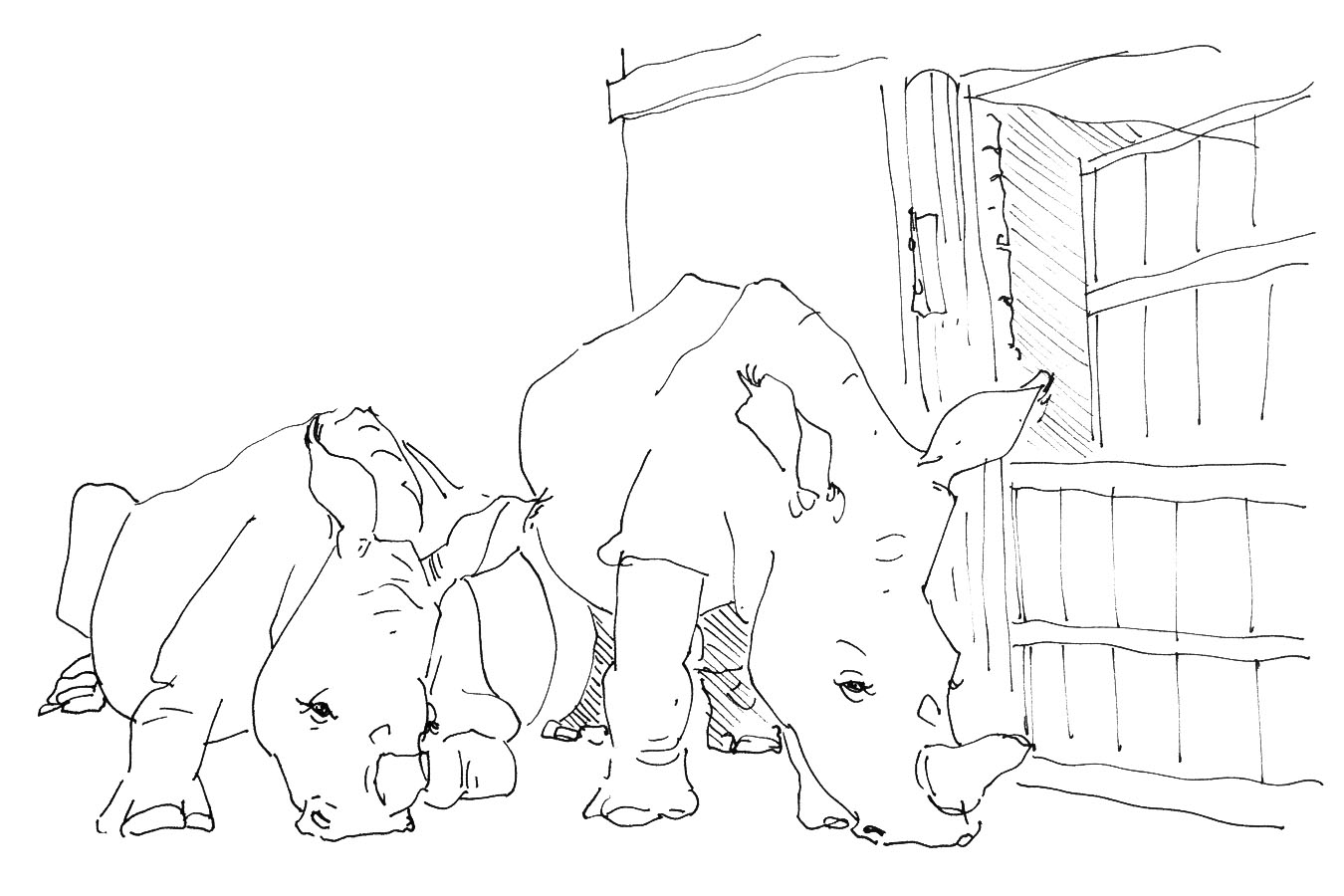
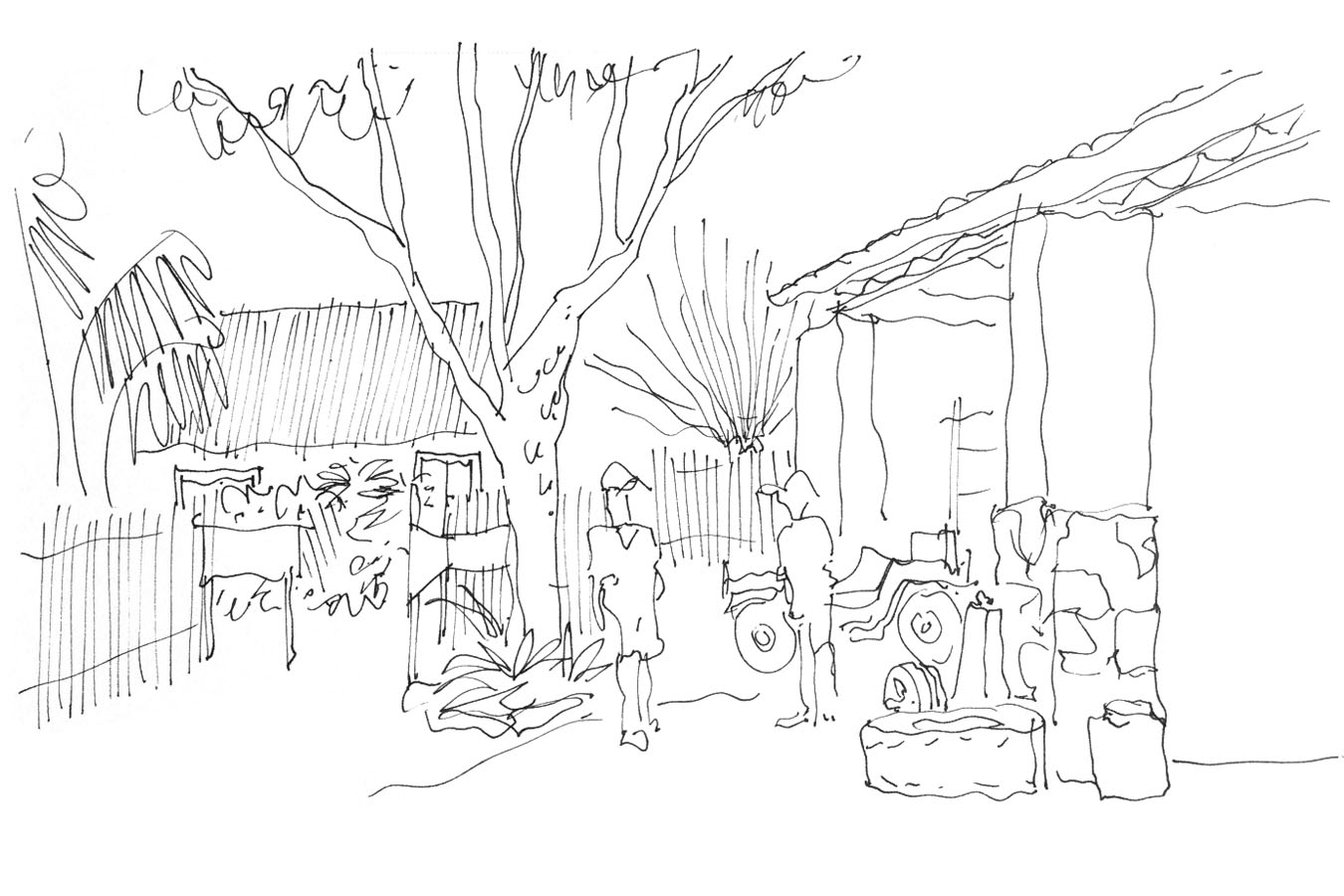
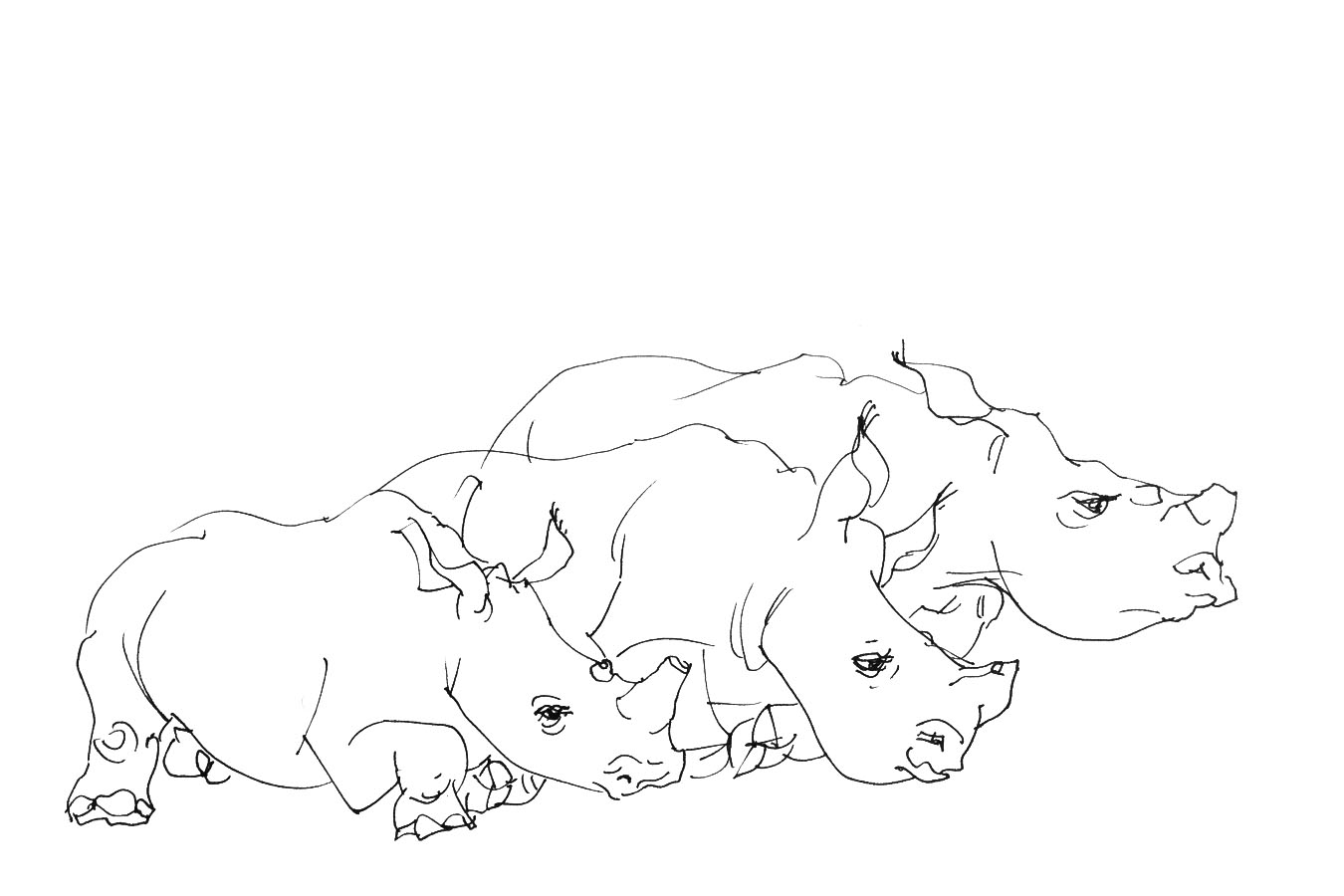
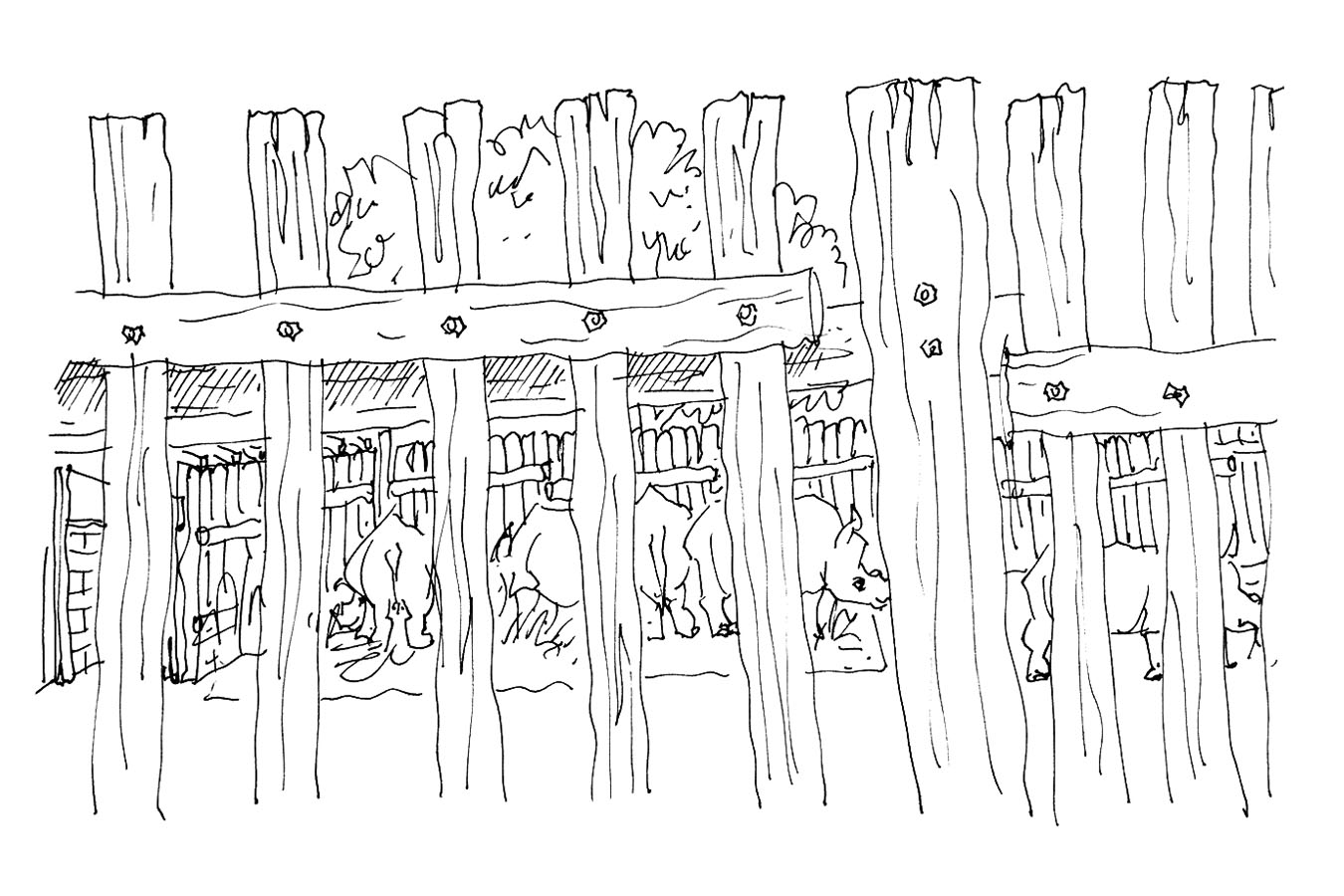
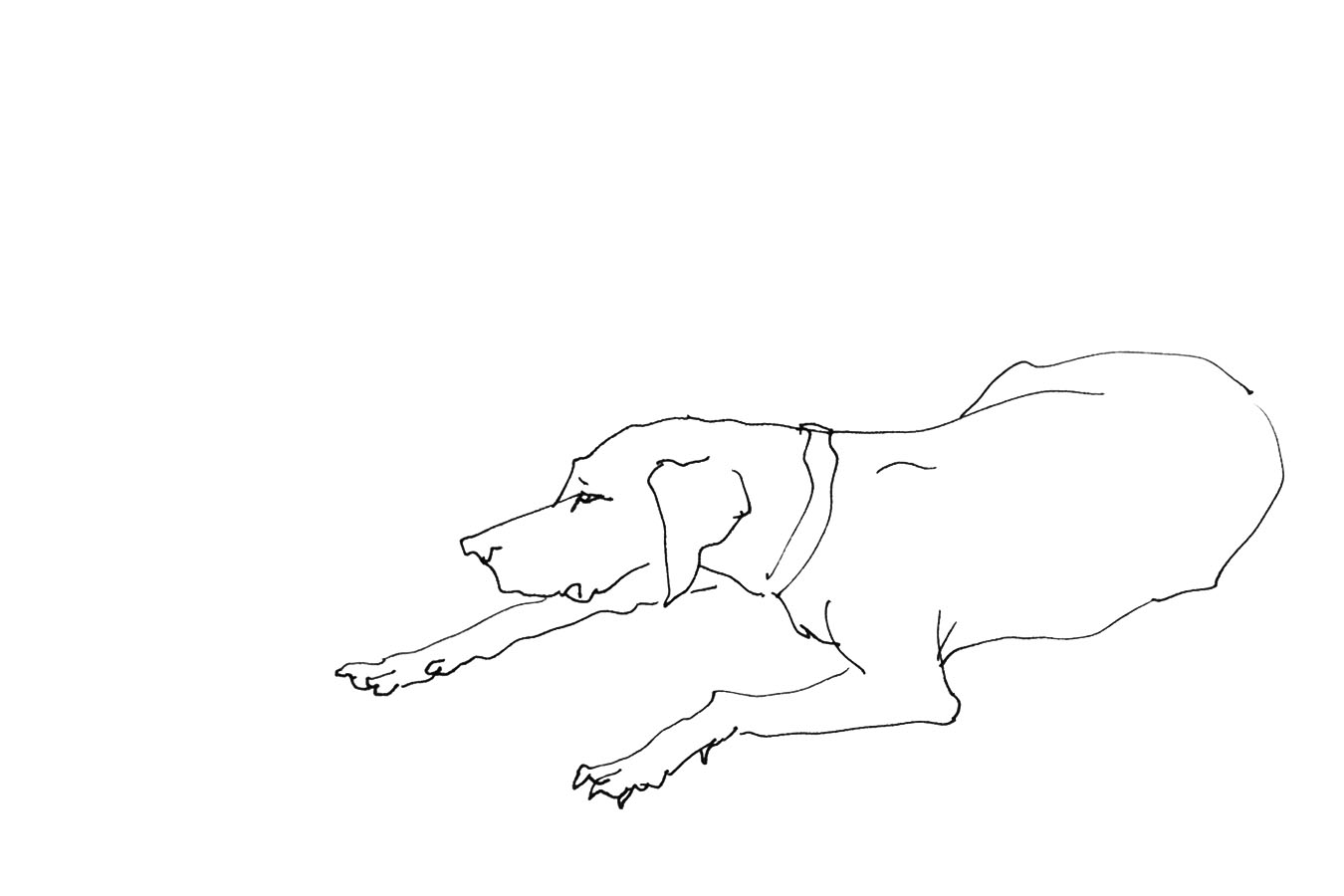
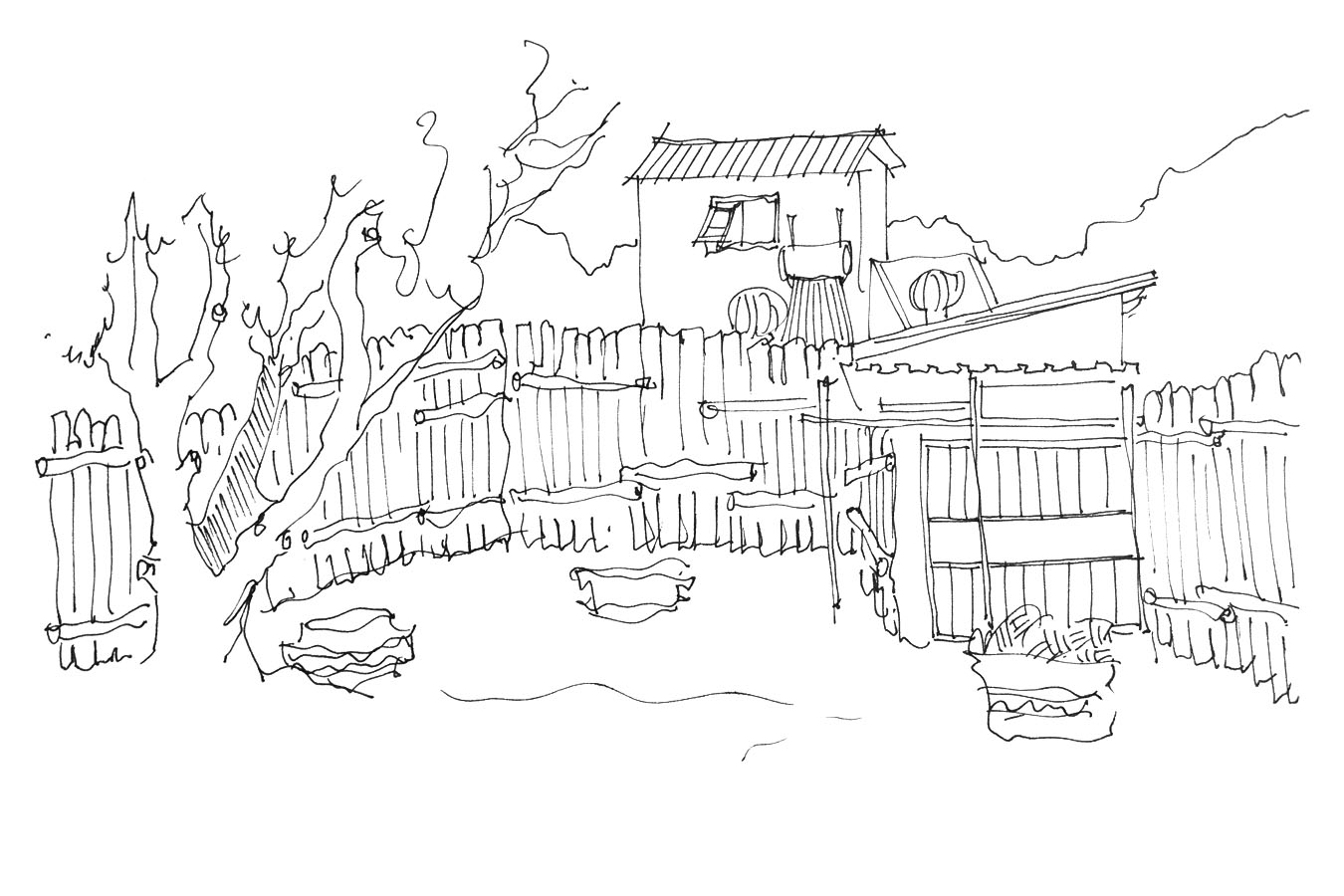
Care For Wild, despite being a total mystery to me before my arrival, is a truly legitimate, well-run operation. It was founded by a former veterinary nurse who also spent years as a captain of the anti-poaching police force in South Africa. HER name is Petronel Nieuwoudt and she means business. Since its founding in 2001, CFW has become the largest rhino sanctuary in the world, so you better believe that our volunteer duties were waiting for us – boot camp style – every morning at 5:30 am.
(And what was NOT waiting for us at 5:30? Electricity and heat (in the winter!). This was rural Africa, after all.)
My typical day consisted, in general order, of:
0530h | Wake up to a chorus of iphone alarms among the 10 or so volunteer cabins. Listen for the captive lion on site, who prefers to stretch his roaring muscles at this hour.
0545h | Gather at the viewer (ie. the open-sided safari-style vehicle). Bundle up in 3 or 4 layers for the chilly ride down the hill to the bomas. Wave to the hippos and owls.
0600h | Arrive at the bomas. Mix special milk formula for the babies: Zac, Grey, Spirit and Jemu. Mix pink formula for special needs rhino, Venus, who likes to pull the teat off her bottle.
0615h | Feed the babies in their night pen! So cute! In the dim morning light, attempt to match the proper bottle to the proper rhino. Get creative with identification because all of their squeaks sound the same, like dolphin-piglet hybrids. Zac is the biggest, Spirit is polite, Jemu has fuzzy ears, and Grey ... is grey.
0630h | Clean and rake all bomas. Watch out for massive piles of poo and always bend the knees when shoveling! Load the lorry and trailer with spent hay and poo.
0800h | Drive the lorry to "The Big 16", ie. the open field where the larger rhinos spend the night eating and – you guessed it – pooing. Shovel and toss up to 50 lbs of poo per rhino into the trailer! Drive the trailer to an area that I have dubbed The Elephant Graveyard, not because there are elephants, but because it is a remote location where flies congregate ... because of the poo. Unload the lorry and trailer as fast as you can so Rachel doesn't yell at you. Try not to bury the lorry as you unload.
0900h | Breakfast! Try to get the yogurt before it's gone and don't forget to eat an Ouma rusk, which South Africans are obsessed with.
1000h | Back to the bomas for deep cleaning of the night pens, where the babies sleep to stay warm. In the winter the air temperature drops into the 40s. Wild rhino calves would graze throughout the day/night to keep their energy and internal temperature up, but because of the threat of poaching, these babies stay indoors at night where they cuddle with each other.
1100h | Measure and weigh dry feed for the needs of each group of rhinos. Distribute livestock pellets as if they are sprinkles on giant ice cream cones, into the piles of hay. Shake glucose powder all over to fatten those babies up! Refill water troughs and squirt nutritional supplement into each trough. Push wheelbarrow around with authority.
1130h | Allow the night pens to dry out before refilling with dense bedding. Wear pants because that stuff is itchy!
1200h | Tidy up all the facilities (raking, sweeping, organizing tools). Monitor the mid-sized rhinos as they graze in the field. Monitor the baby rhinos because they are cute.
1230h | Lunch! Refill your water bottle because it's going to get very hot in a minute.
1330h | Back to the bomas to grab the comically-large hay bags for refilling. Wave to the guards upstairs, spray your hands and shoes with disinfectant and please Megan, don't touch the electric fence again.
1345h | Drive out to the golden hill to harvest fresh hay for use as bedding. Watch out for snakes and tarantulas – this is pretty much their paradise.
1430h | Return to the bomas for assorted odd jobs.
1500h | Drive to the grazing area for the mid-sized rhinos and watch out – they are in there with you! Remove cut logs and tree branches that could shelter poachers. In keeping with the theme, watch out for snakes and tarantulas. And errant rhinos. Take logs off-site and stack neatly – or throw recklessly in an attempt to show off.
1600h | Feed the nyala and duiker. The females are nosy yet timid, and the handful of males are not to be approached under any circumstance – they will mess you up.
1645h | Back to the cabins for shower time and to catch the sunset :)
1800h | Dinner!
2100h | Night bottle feeding of the babies – listen for the adorable squeaks again.
2145h | Bunkbedtime. Sleep like the logs you've unloaded today!
Assorted Recap:
Look at those cuties and their silly feet!
| Below: Click and hover for delightful subtitles |
Rhinos use a wide variety of vocalizations to communicate – squeaks, moos, grunts, snorts and trumpets. If you want to hear rhino squeaks, turn up your volume and watch below :)
PART 2
After 10 packed days with the rhinos, I was picked up by the side of the highway (again) by my escort to the next program (No. 2 on map at top). Though the Heart for Orphans program is located in a small town near the border with Mozambique, our accommodation was along the Crocodile River which divides Kruger National Park from civilization. Each morning and evening I caught the comings and goings of freely-roaming wildlife just beyond our fence – BIG and small:
The property perfectly skirts the edge between manicured development and raw wilderness, placing me exactly in heaven:
Sitting on the Sunken Room, contemplating in peace
Section: the Sunken Room | We received curious visitors several nights in a row – 4 bull elephants in total!
Aside from Promise, the occasional housekeeper, Melissa and I were the only people on the property so it definitely felt like an "if you're in a forest and you scream, does anyone hear you?" kind of situation. We even got word that there was a leopard spotted on the property while we were there (!!!). Yet, despite a few close calls and a creepy run-in with a glass-eyed sugar cane worker in the dead of night, we made it through the week safely. Perhaps it was due to our expertly-crafted locking mechanism:
This is how you deter intruders and leopards in rural South Africa.
My week spent with Melissa and the orphans was so special because I got an intimate look into what it means to be South African. Melissa has lived in Johannesburg her entire life. It is a big and exceptionally dangerous city where many residents are afraid to leave their homes. By contrast – the locals in Steenbok, where the children's center is, are entwined with their community as though there are no walls – no divisions. People make eye contact as you pass by and almost all school children waved excitedly to us daily. In Steenbok people live largely off the land because the land is what they have.
Thanks to Melissa, I also learned my share of Afrikaans phrases, which are quintessentially African:
1. "Ag shame" – used to express doubt, or literally anything:
A: "Aunt Trudy was eaten by a leopard."
B: "Ag shame!"
- or -
A: "I just won the lottery!"
B: "Shame!"
2. "Just now" – an unknown amount of time – either a few minutes, hours, or never:
A: "I'll come over just now."
B: "Ok, see you next year!"
3. "Izit?" – used when you have no idea what someone just said:
A: "I just performed a data analysis on hybrid strains of the Andromeda virus."
B: "Izit?"
Although I picked up a ton of "localisms", there is still just one phrase to sum up the African sunset as seen from the edge of Kruger National Park, and it is in English:
Wow, just wow.
Before I move on, check out this Sketch Record of all the fauna I spotted throughout the trip – a combination of one safari, one night game drive, general wanderings, and my time at the Crocodile River. My rarest sightings: the white rhinoceros (very lucky to see in the wild with full horn intact!!), southern ground hornbill (spotted a group of six!) and cheetah (which I must confess nearly brought me to tears).
Is your favorite on the list?
PART 3
Refer to the No. 3 route on the map at top. This was my daily commute to Steenbok, a town of ten thousand in the Ehlanzeni district. It is just 3 square miles in area and the locals speak siSwati (which is very beautiful!).
If you watch and learn the phrases in that linked video, you will be way ahead of me, who could barely learn "good morning" and "see you tomorrow". One term I did learn – 'mlungu' (white person), which is what the children called me until they could remember "Megan".
The children's center, called the Ciniselani Stimulation Centre, is a type of daycare for children who are either orphaned or whose guardians cannot afford to send them to school. Unlike in the US and elsewhere, there is no such institution as public school in South Africa and all education comes with a tuition. There are a handful of private schools in Steenbok and neighboring Naas – you can see the uniformed children walking along the dirt roads – but the children at Ciniselani are not so fortunate to attend. Furthermore, the 29 children in attendance have special needs and would not cope easily in the larger traditional schools.
This was really a special place.
There is not much to identify Ciniselani as a place for children, aside from the colorful mural on the facade, a scattered pile of painted rocks, and a swing set. Dirt covers the grounds of the property and the ruins of a demolished building provide the backdrop for the "school day" (8 am - 2 pm).
Thandiwe (age 19) drew a very accurate portrait of me!
Background middle: the children's loo (a trough). Background left: a shed for changing diapers. At right: an existing foundation set to become a new building for permanent lodging for kids (pending donations)
The inaugural group of volunteers recently painted the main facade with symbols of Africa. Ironically, most of these children will never get the opportunity to see a wild giraffe, mountains, or an airplane.
Just as the property itself is quite basic, so is the inside of the centre, a single schoolroom without plumbing or electricity. The concrete floor is cool to the touch, chairs and tables are cracked, several panes of glass are shattered from the windows, and the roof is prone to leak. Yet, you won't hear a single complaint – the kids and mamas are all smiles!
Because I was the only volunteer this particular week, I was in charge of setting the agenda for play and learning. And because of the language barrier, I had to get very creative with the daily activities, as well as brush up on my "sign language" (ie. flailing arms to express my objectives). Luckily, drawing is the true international language and I was able to communicate effectively with pencils and chalk :)
Our classroom activities included:
- Playing pictionary and hangman to learn English words
- Learning parts of the body, days of the week, and numbers in English
- Practicing basic addition and subtraction
- Yoga (for some reason I was assumed qualified to lead this, though my muscles are some of the most rigid on the planet)
- Speaking "in public" in English (each child recited their name, where they are from and their age). My favorite names? Happy and Trust :)
Our outdoor activities included:
- Blending colors to make the color wheel (and learning the English terms)
- Painting rocks with finger paints (*NOTE: a massive care package of supplies is en route from Creative Treasures Preschool in Fort Wayne, Indiana!!)
- Basketball on the lumpy dirt "court", soccer and ball toss
- Flying paper planes
- Dancing!
- Dishing out one million high fives and two million hugs :)
As a designer I can appreciate the ingenuity of the basketball goals, which are formed from wooden posts and bent wire that had to be re-installed after each shot bent them down. Still so fun, though :)
My lasting contributions included:
- The classroom 'mamas' drew out the letters of the alphabet and I added an illustration to accompany each. The walls in the classroom were previously quite bare, so now the kids will have Padalecki originals to view and memorize :)
Melissa helps to hang alphabet letters on my last day at Ciniselani
Sebonelo (age 10), Nkosinaty (age 15) and Sydney (age 19) take in the new "art"
- Hand delivering a box full of Little Moon books to the kids! Patricia, a classroom mom and our translator, helped me to read the book aloud in the native siSwati language. After story time, the kids practiced drawing Moon, meticulously counting out 8 legs and 2 tentacles, and adding spots. The phrase "lost in translation" comes to mind, because rather than learning the English word 'squid', the children referred to Moon as 'pop', based on this page:
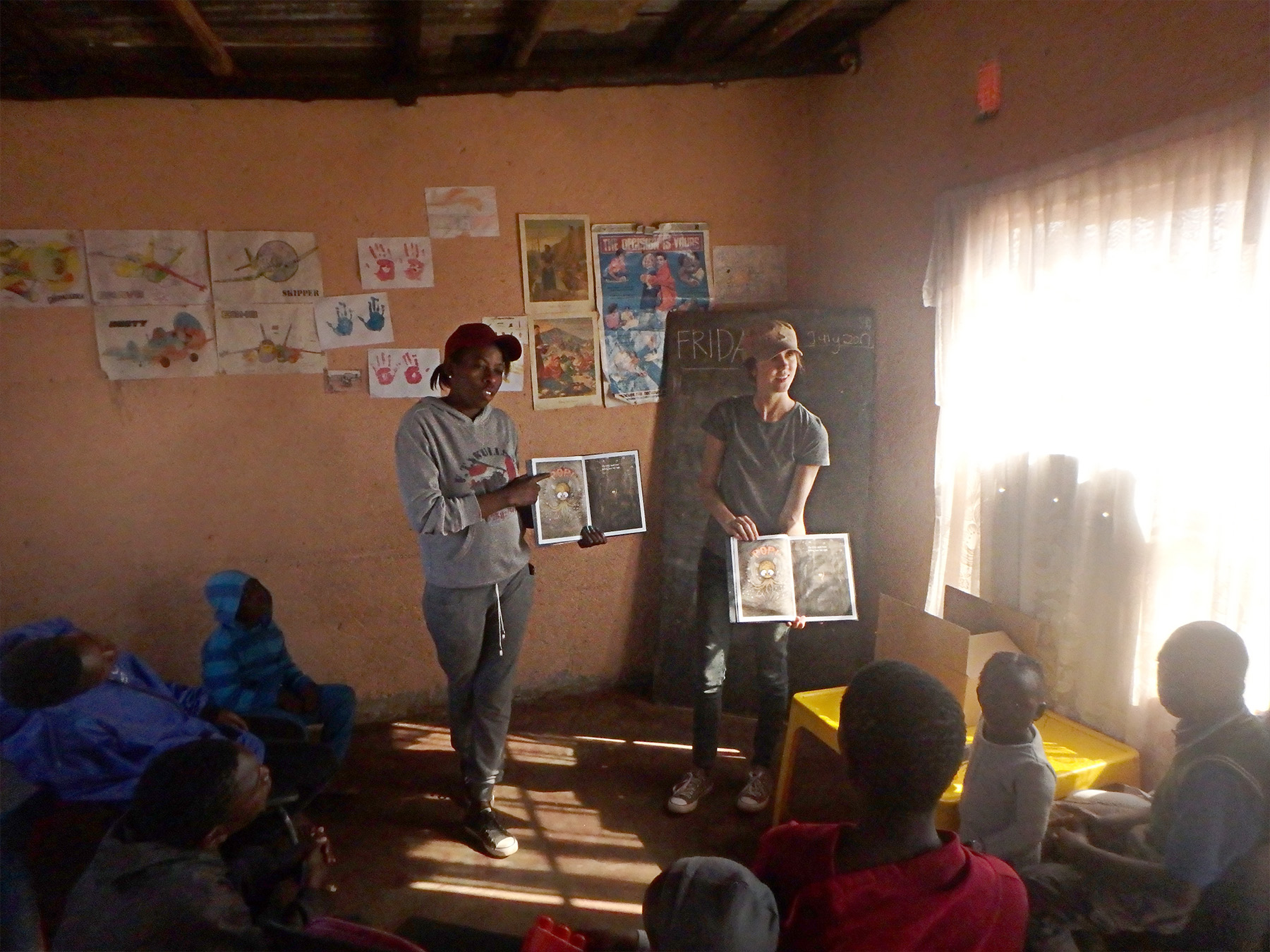
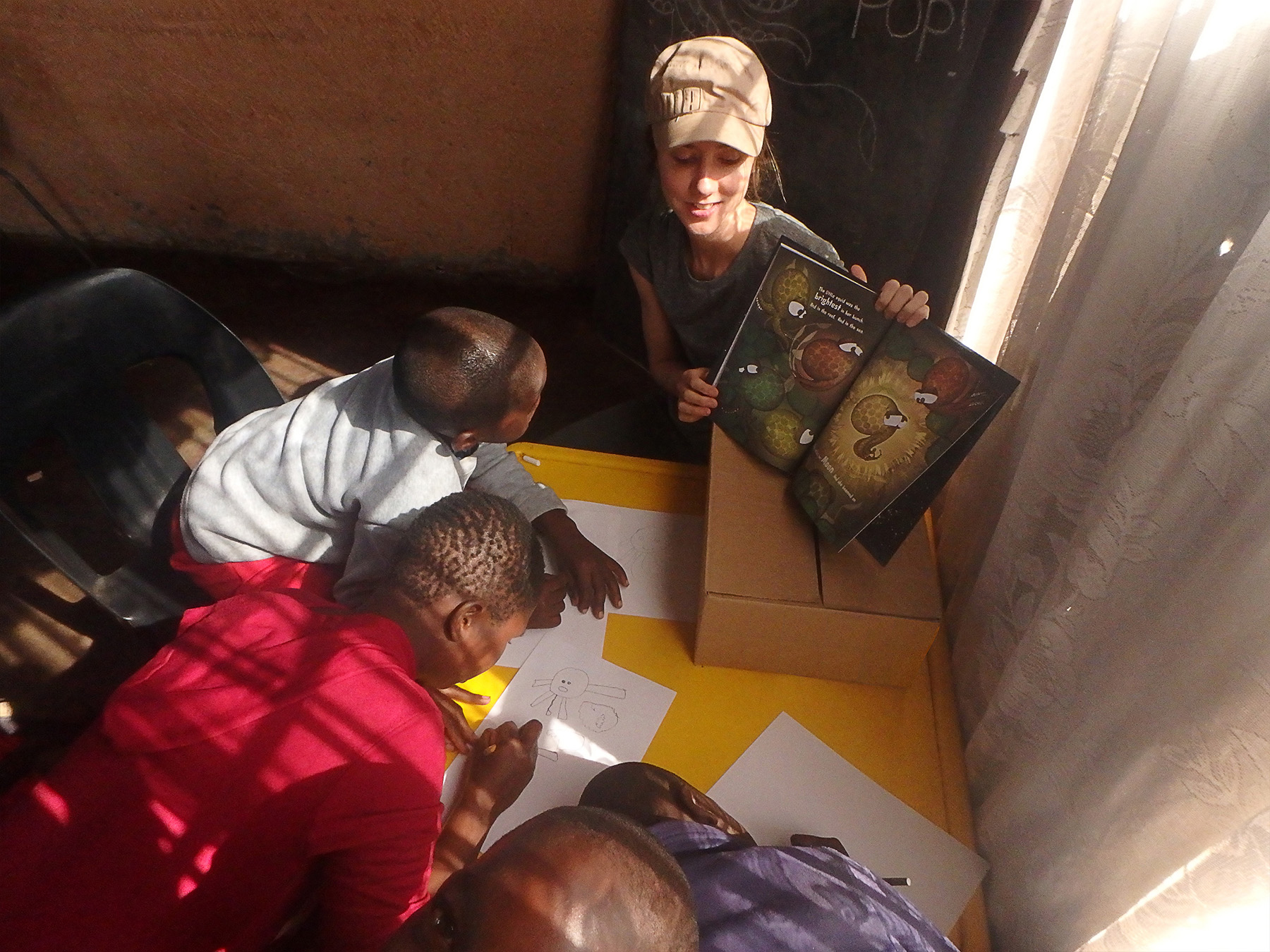

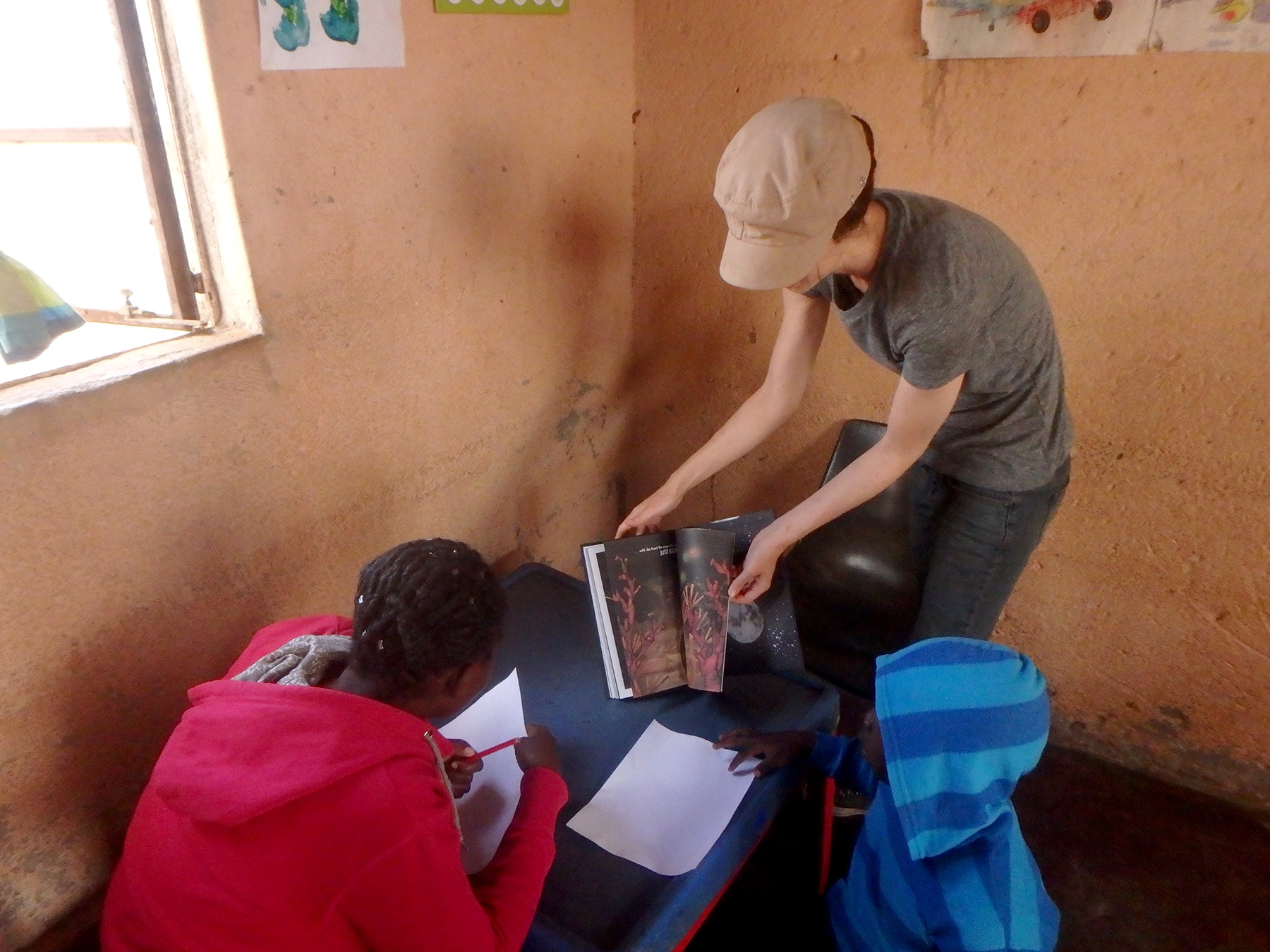
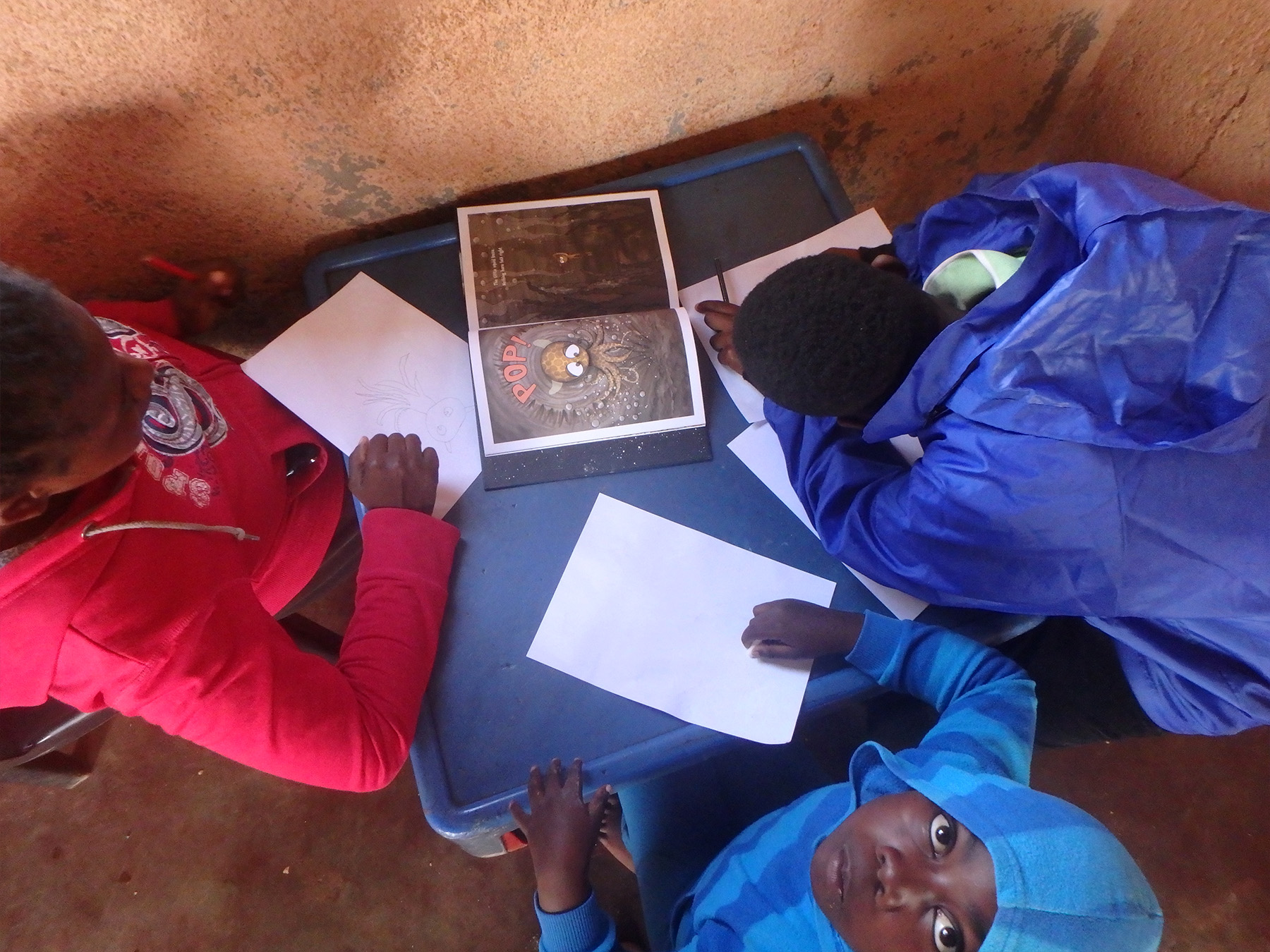
Considering the relative certainty that these children will never see a squid in Steenbok, I think it's a-ok that they memorize the word as "pop".
After so much time spent with the children, and as the only new visitor, I was able to form special bonds with more than a few. Thandiwe loved fashion and was quick to show off her shiny dress on my last day. Musa could not get enough basketball and I taught him how to spin a ball on one finger (thank you 8th grade basketball camp for that one!). Sebonelo was known to be shy around adults and newcomers, but he came to me every afternoon for a high-five and to expectantly ask, "tomorrow?".
As I always do – and as evidence that I would make a terrible parent – I chose a favorite. Nkosinaty, a 15 year old boy who cannot move below the waist, was relatively quiet among the group. When the other children ran wildly in the field, jumping and kicking balls, he sat introspectively on the sidelines. I could see that he was always pondering. I also noticed that he would focus a laser eye on the chalkboard whenever I drew something.
There are very few supplies at Ciniselani so simple sheets of paper are treated as precious commodities. I couldn't stand how little there was to go around so one afternoon I handed my spiral notepad to Nkosinaty – and he proceeded to blow my mind. He had imprinted many of the illustrations I had done throughout the week and could draw them perfectly from memory! Just like that, we had broken the cultural, language and age barrier with that limitless link – art. Needless to say, I left that notepad with Nkosinaty so that he will keep drawing.
I mentioned earlier how much I love anglicized African names and there was one 13 year old boy whose name I couldn't agree with more –
he was called Perfect.















